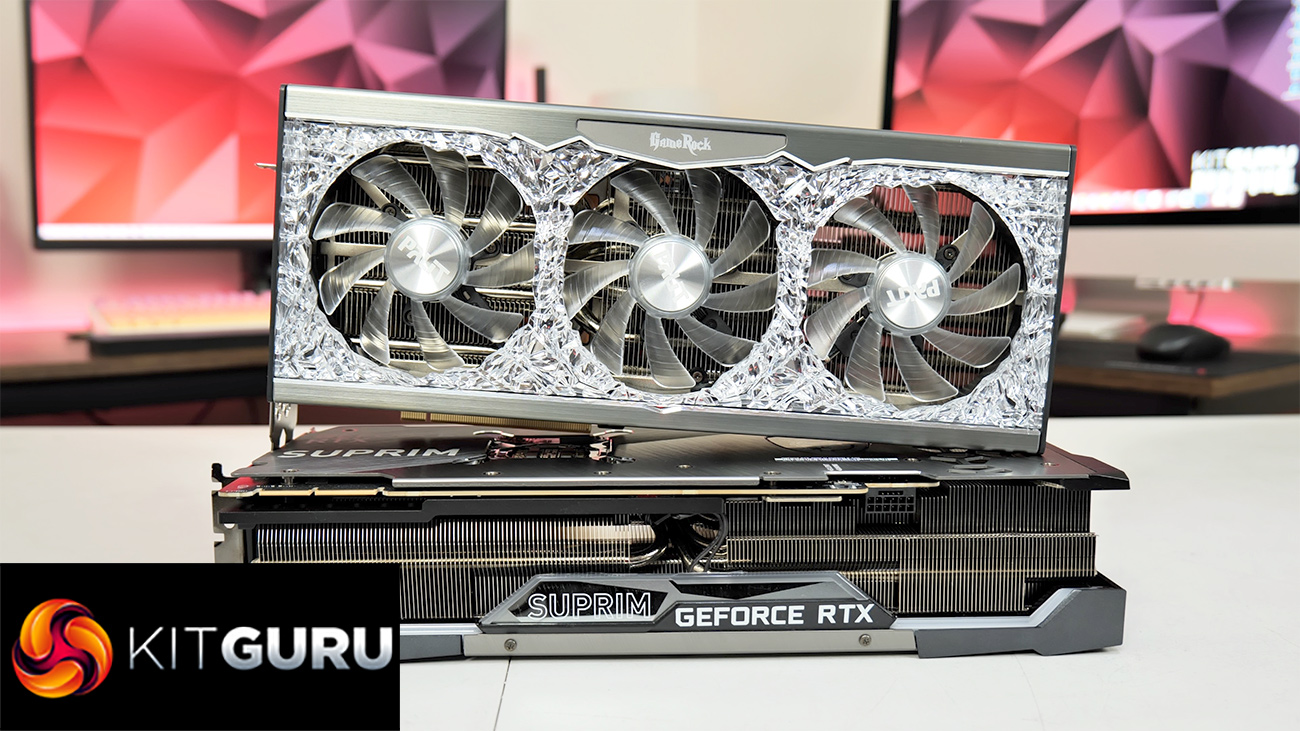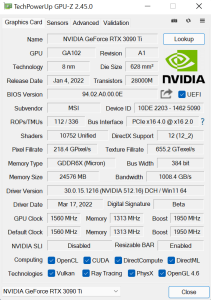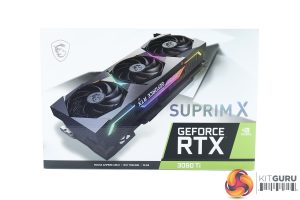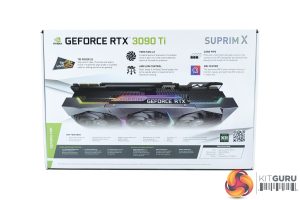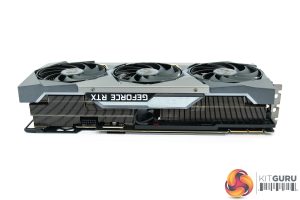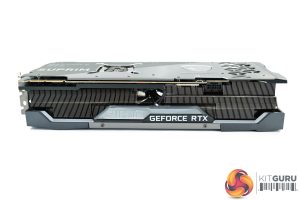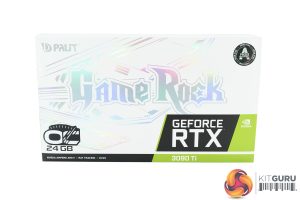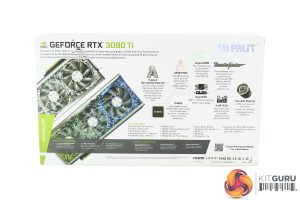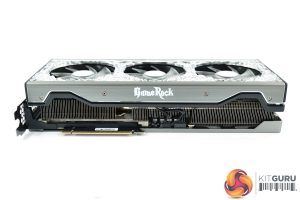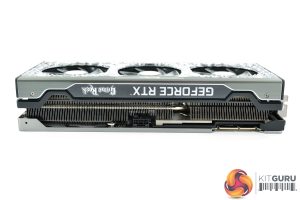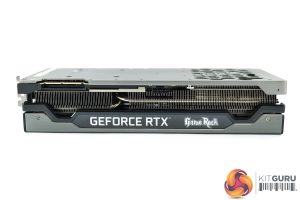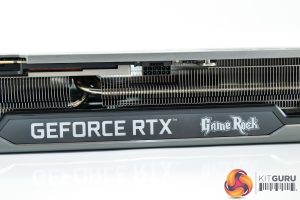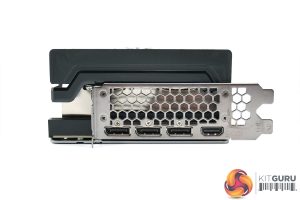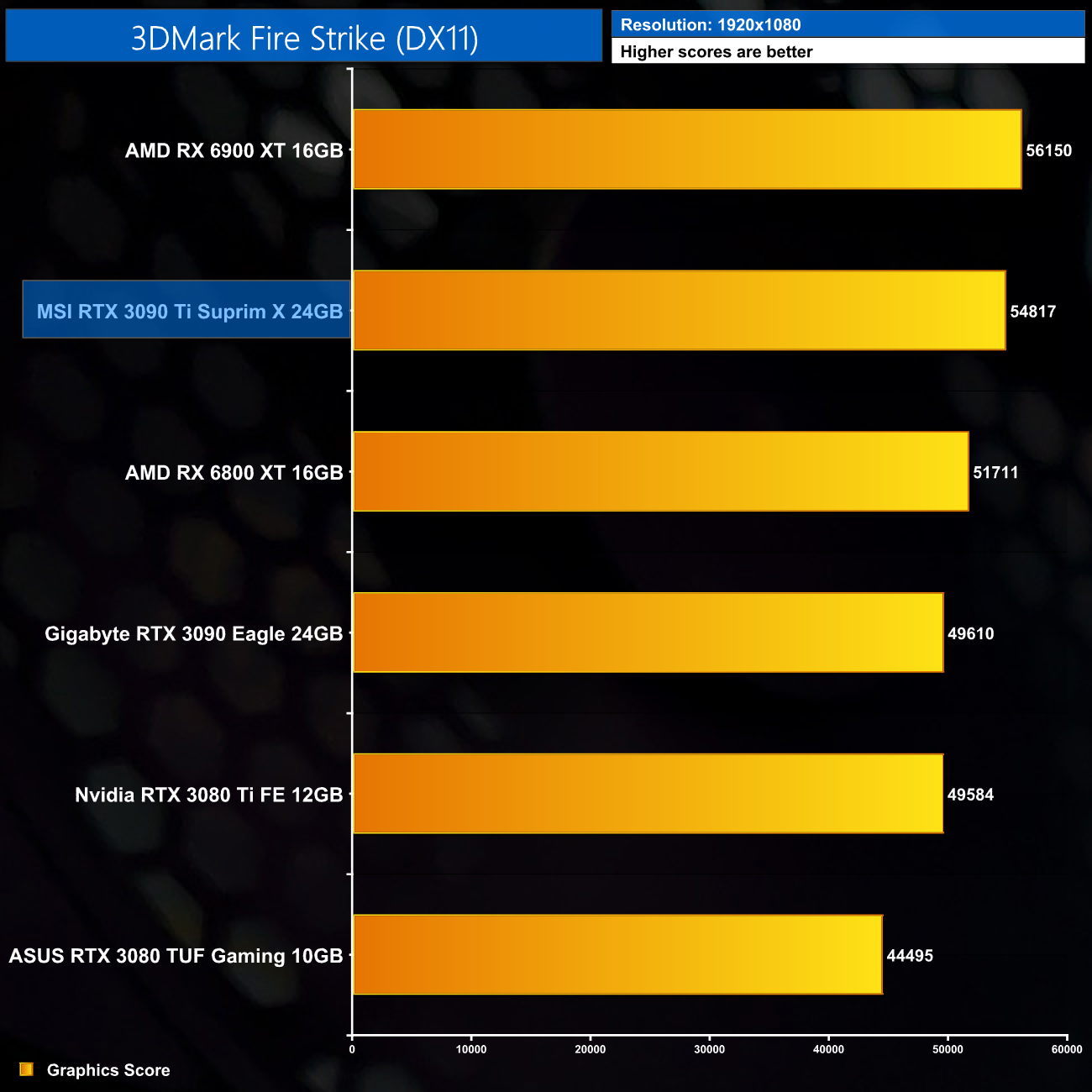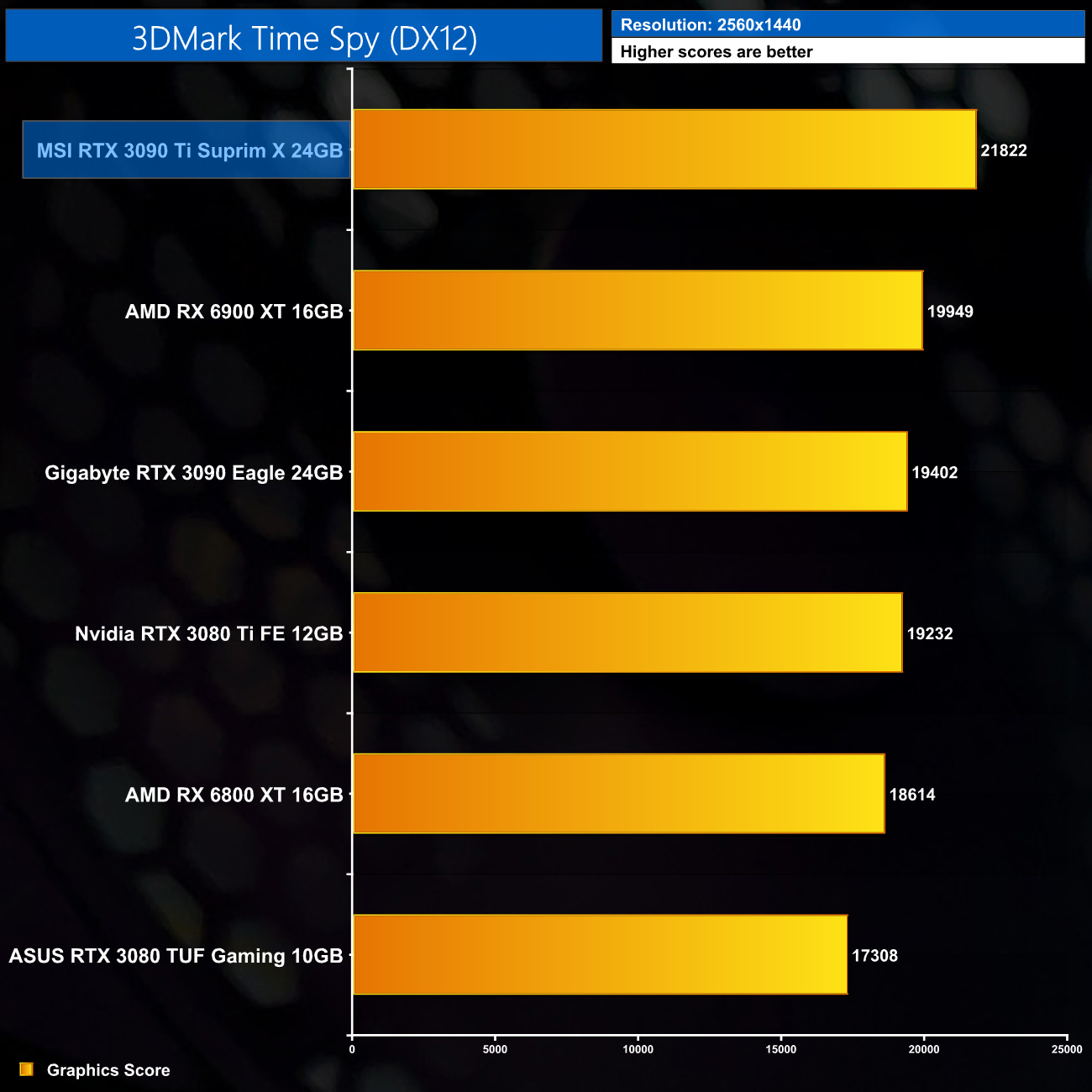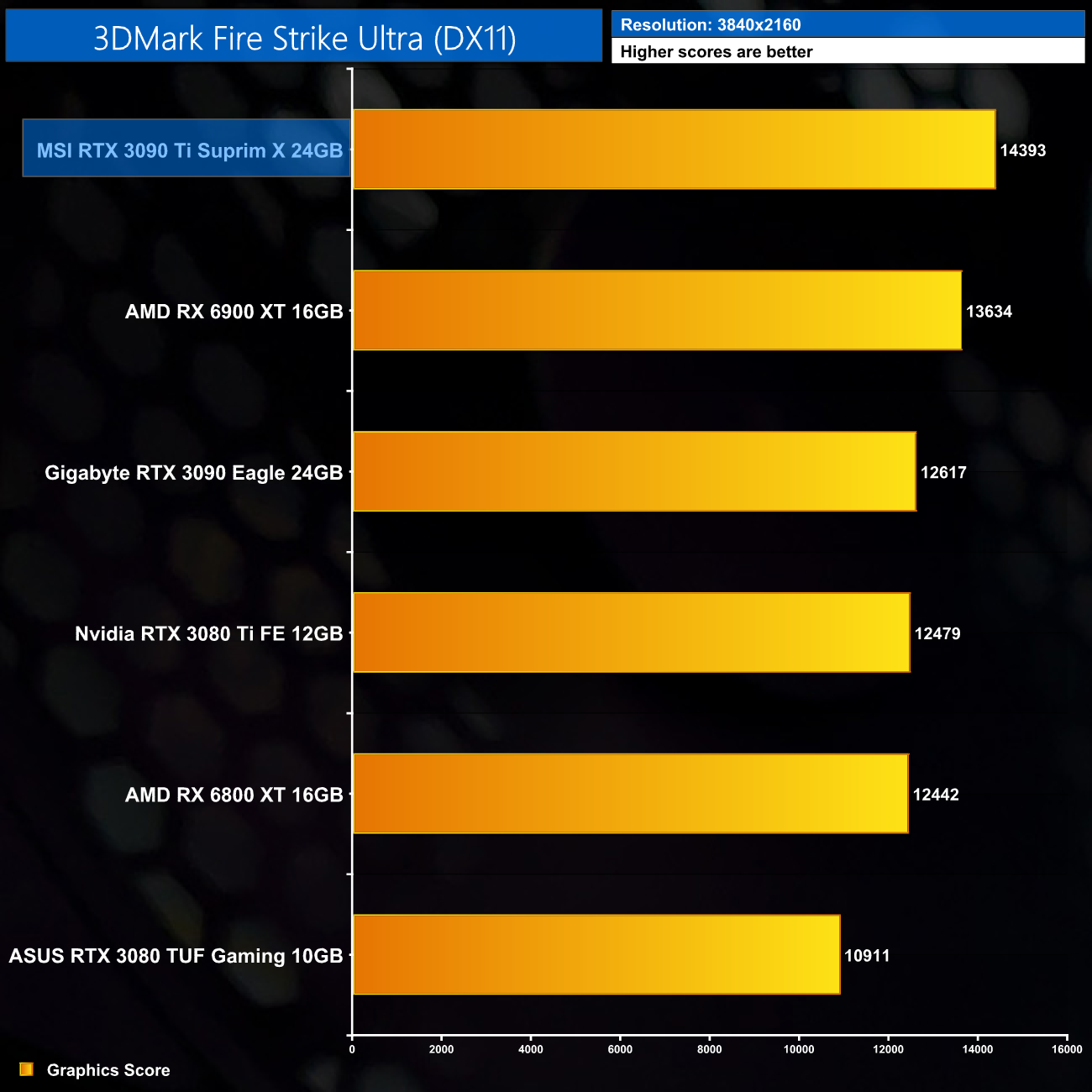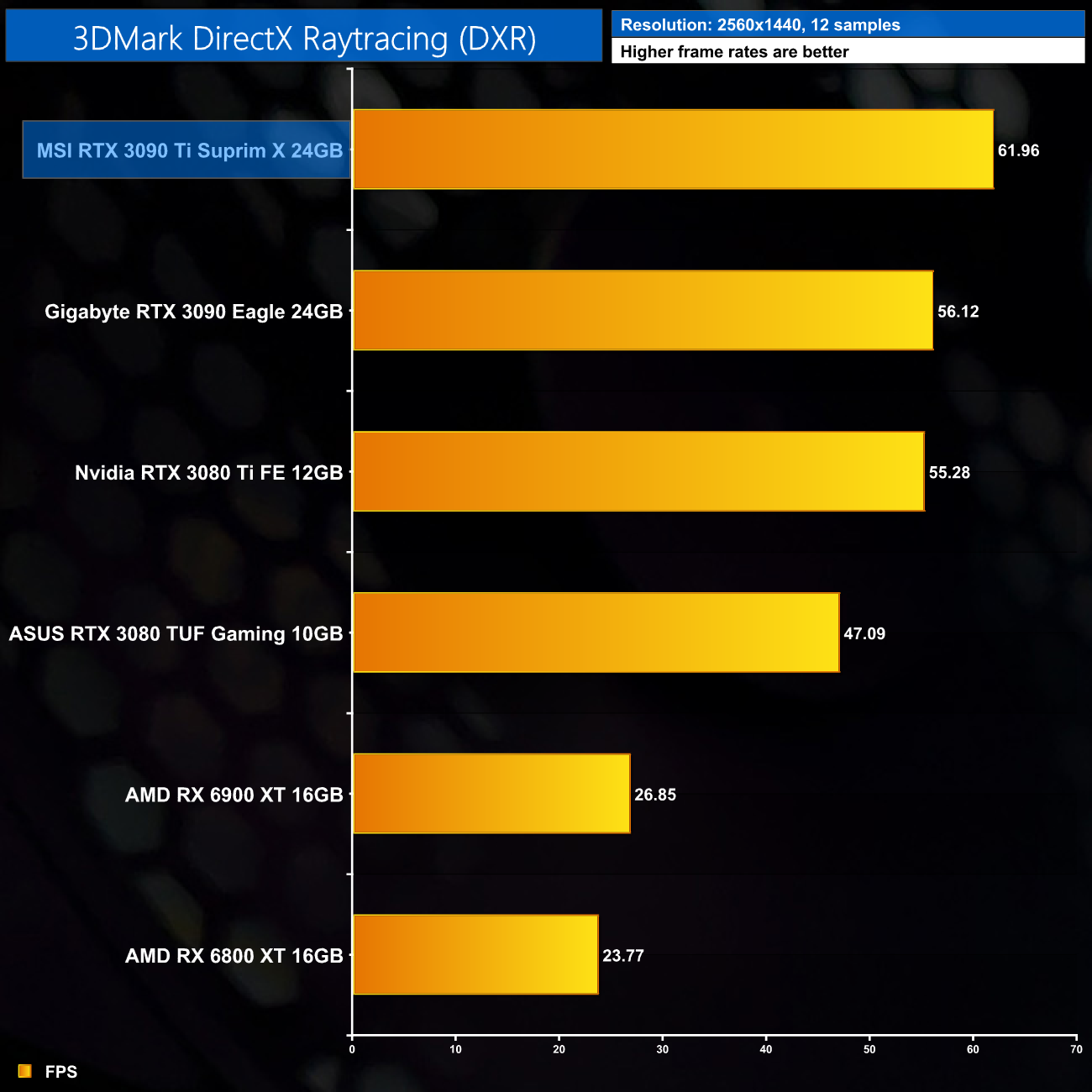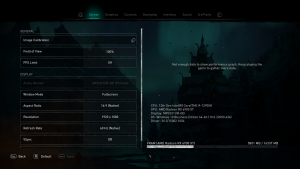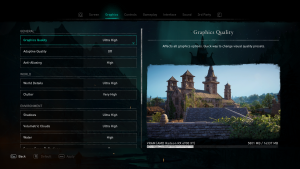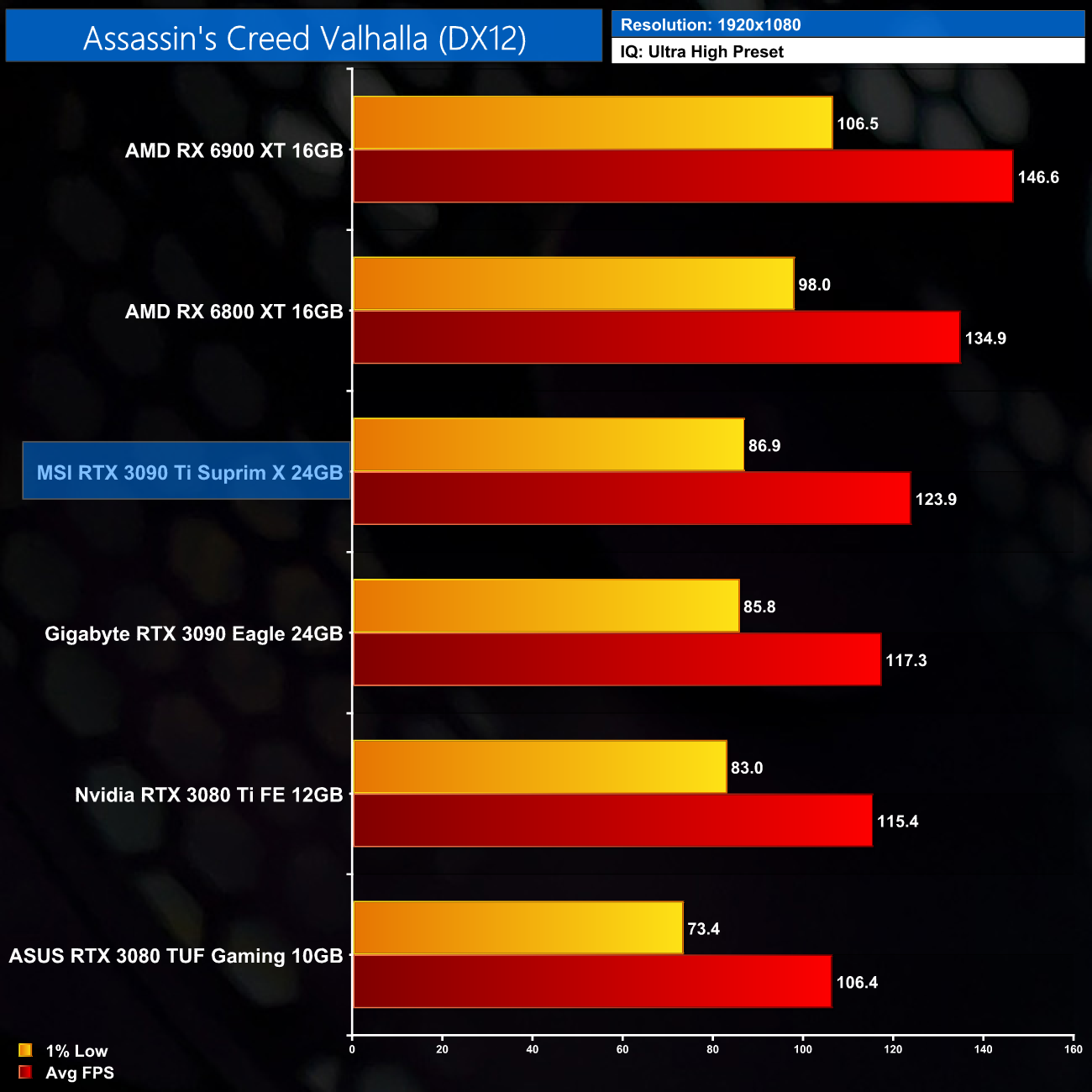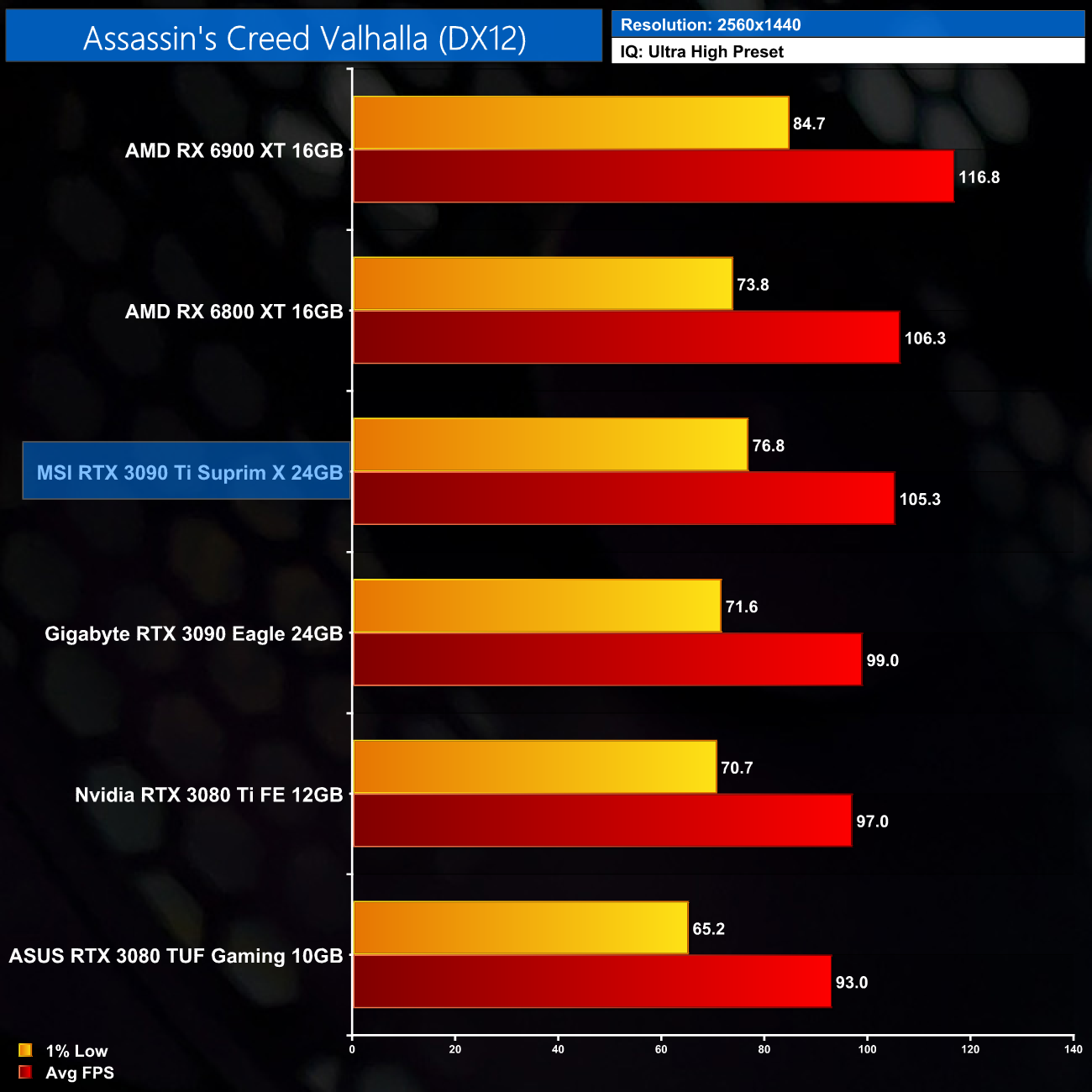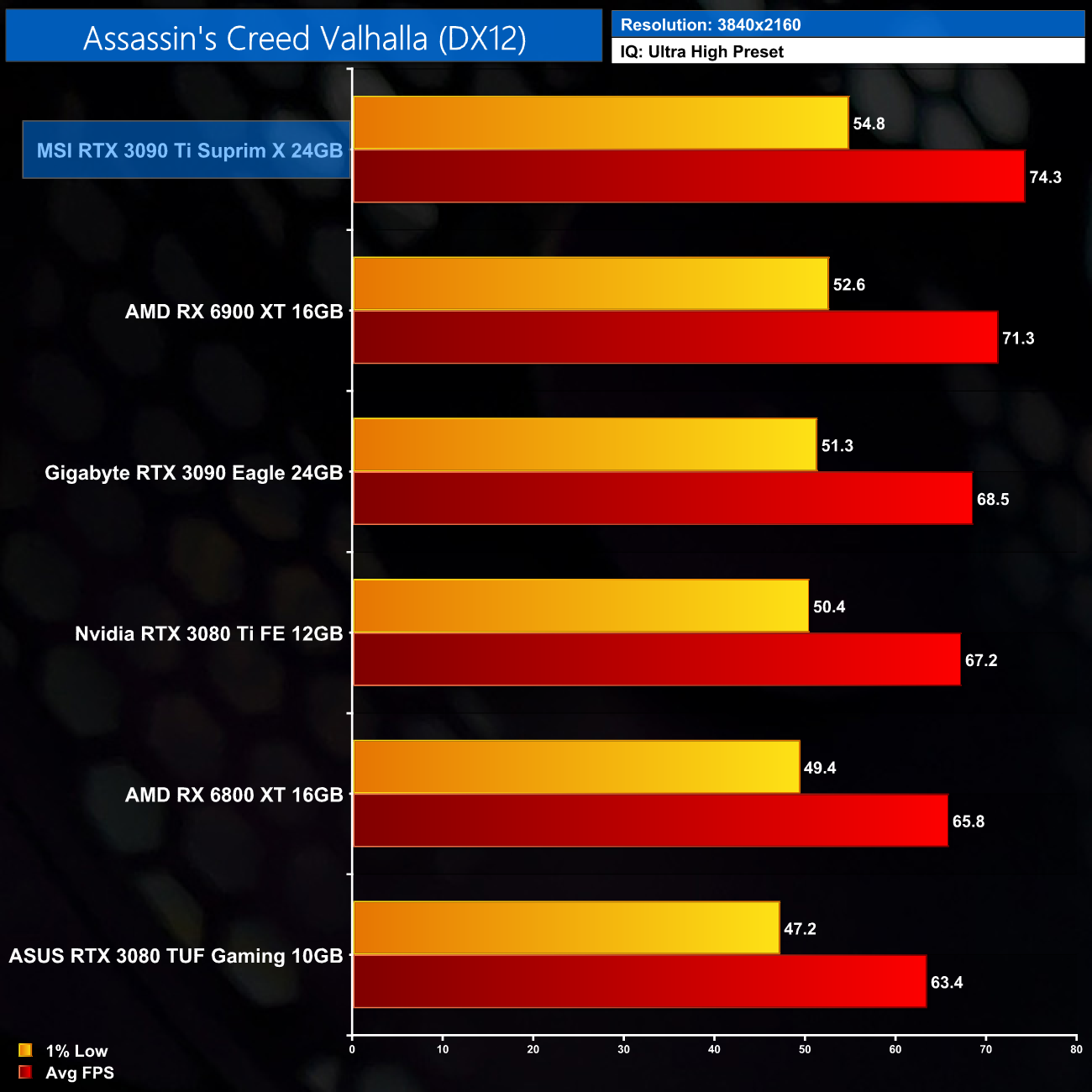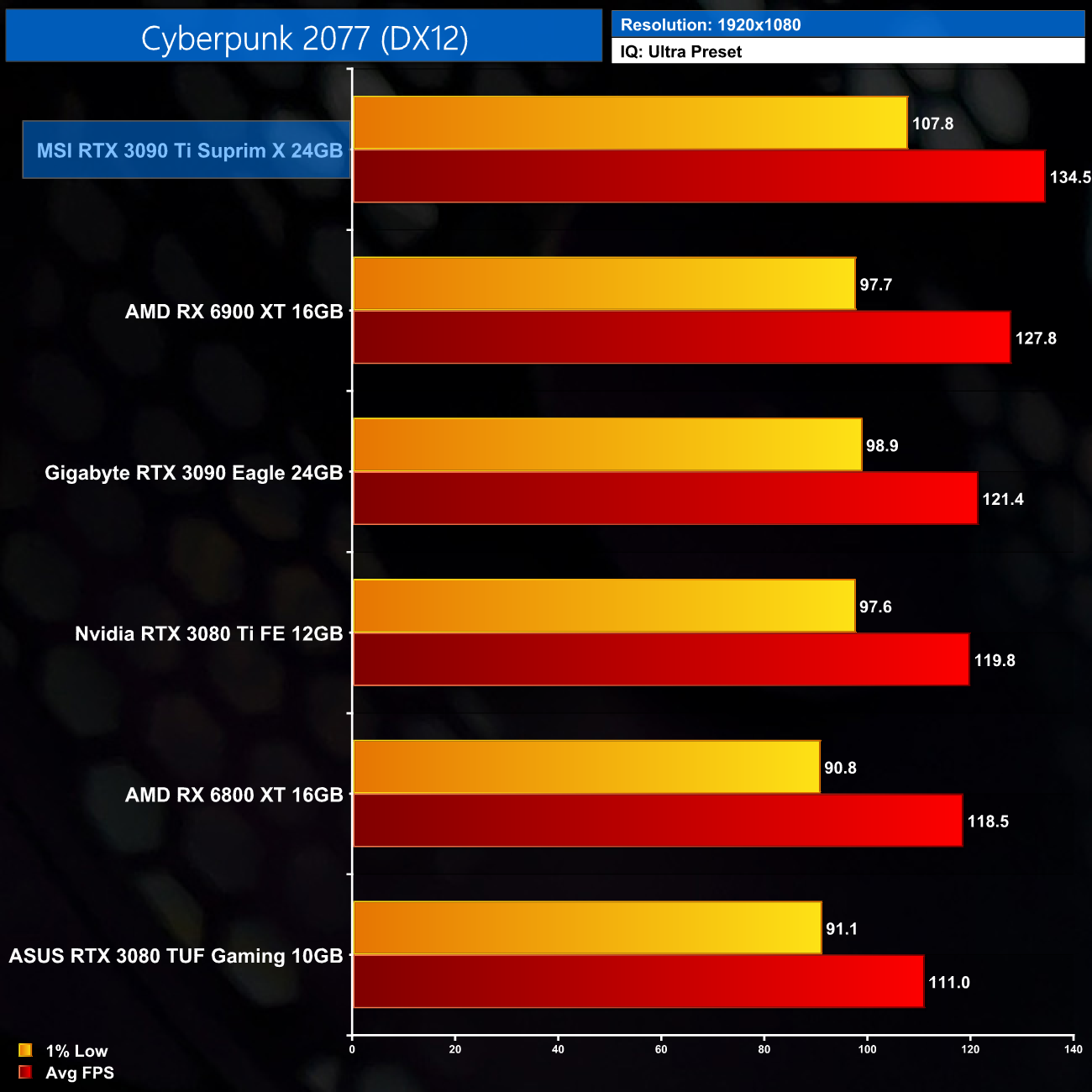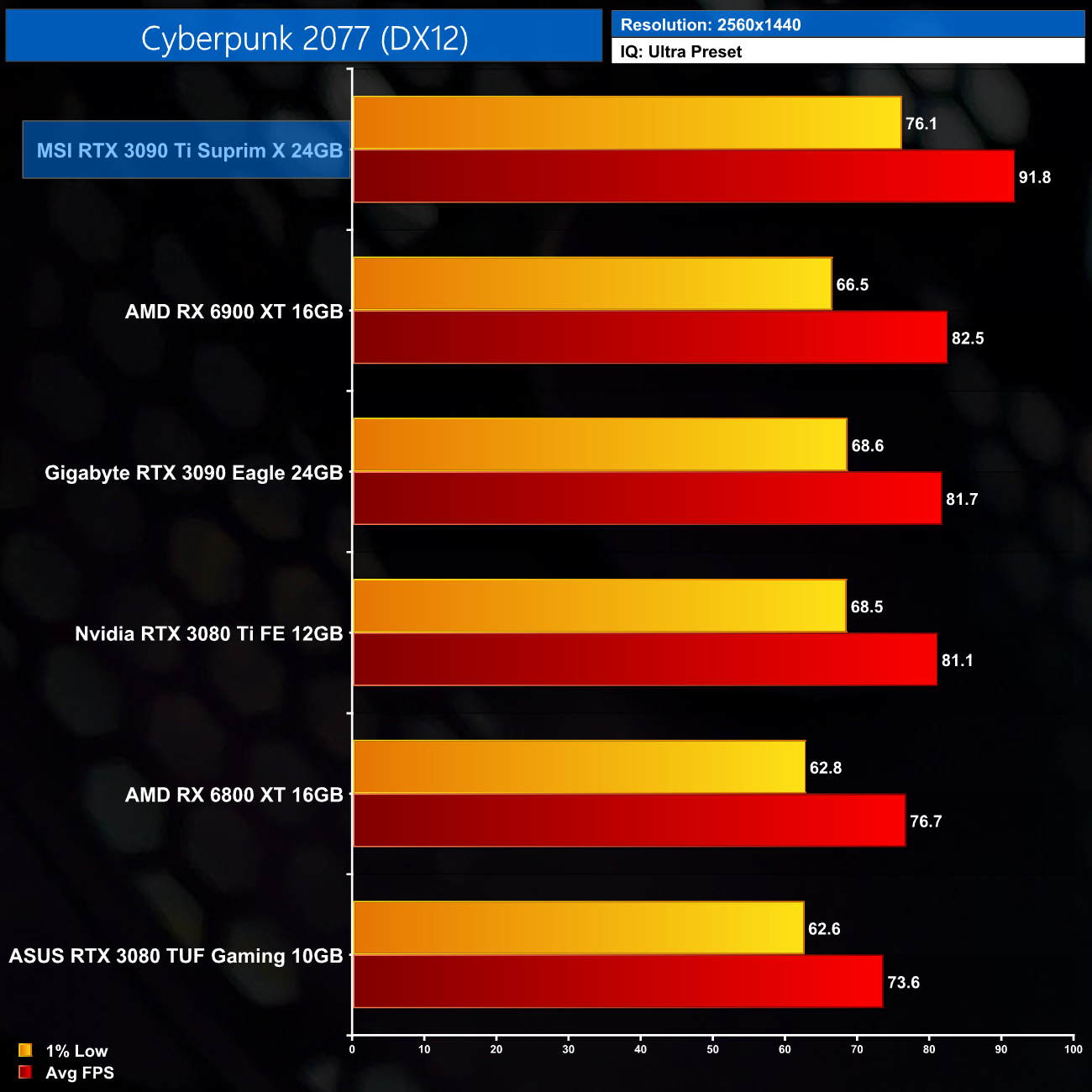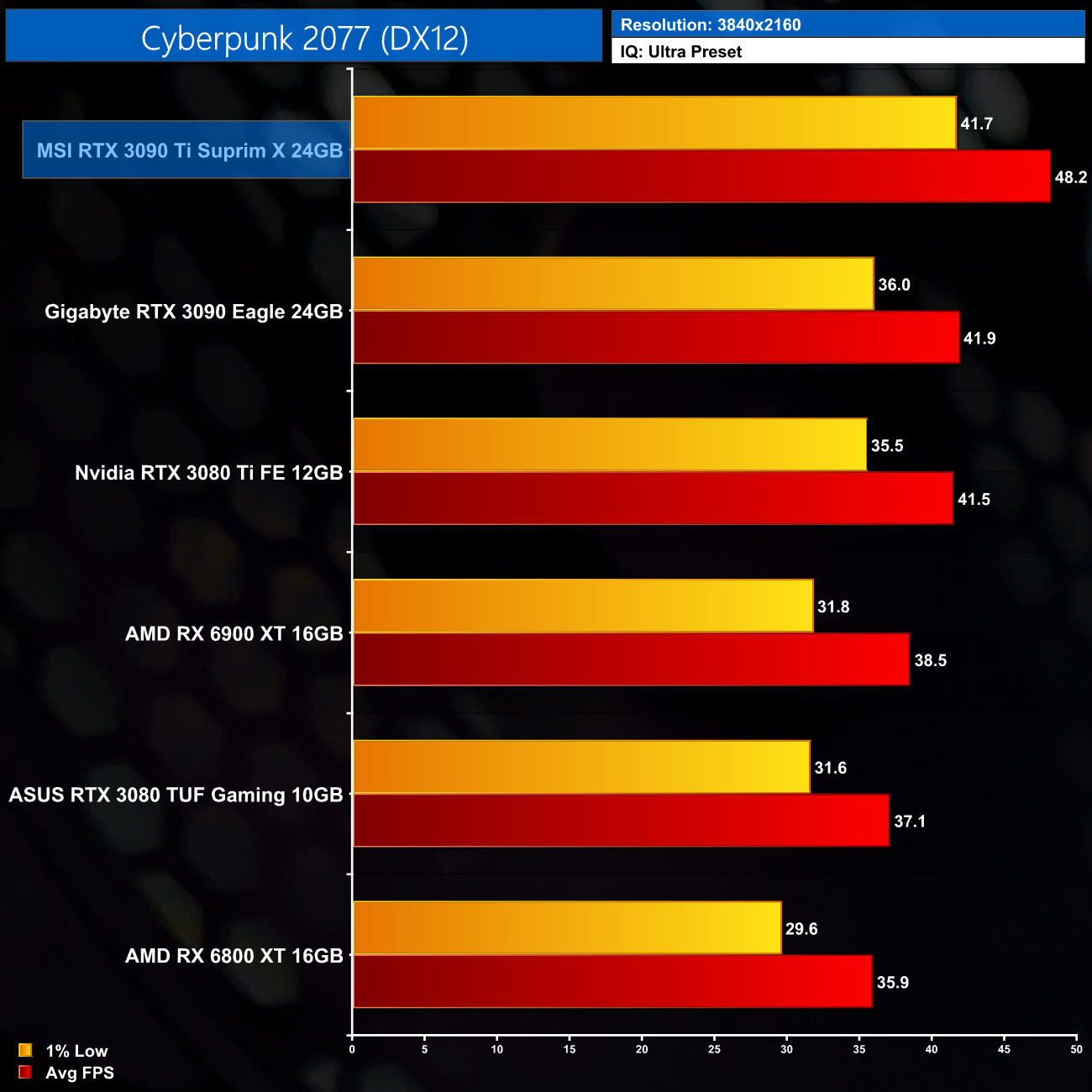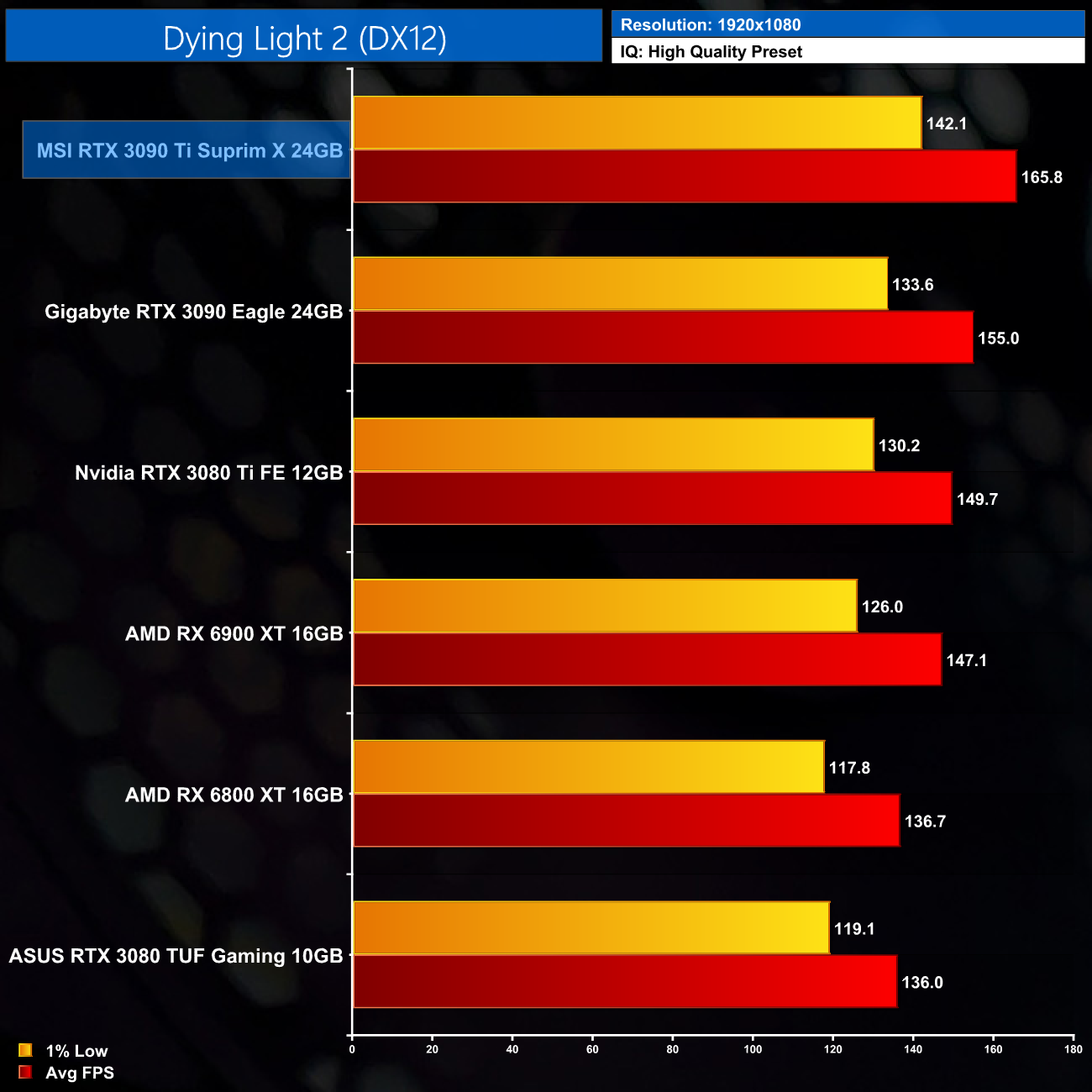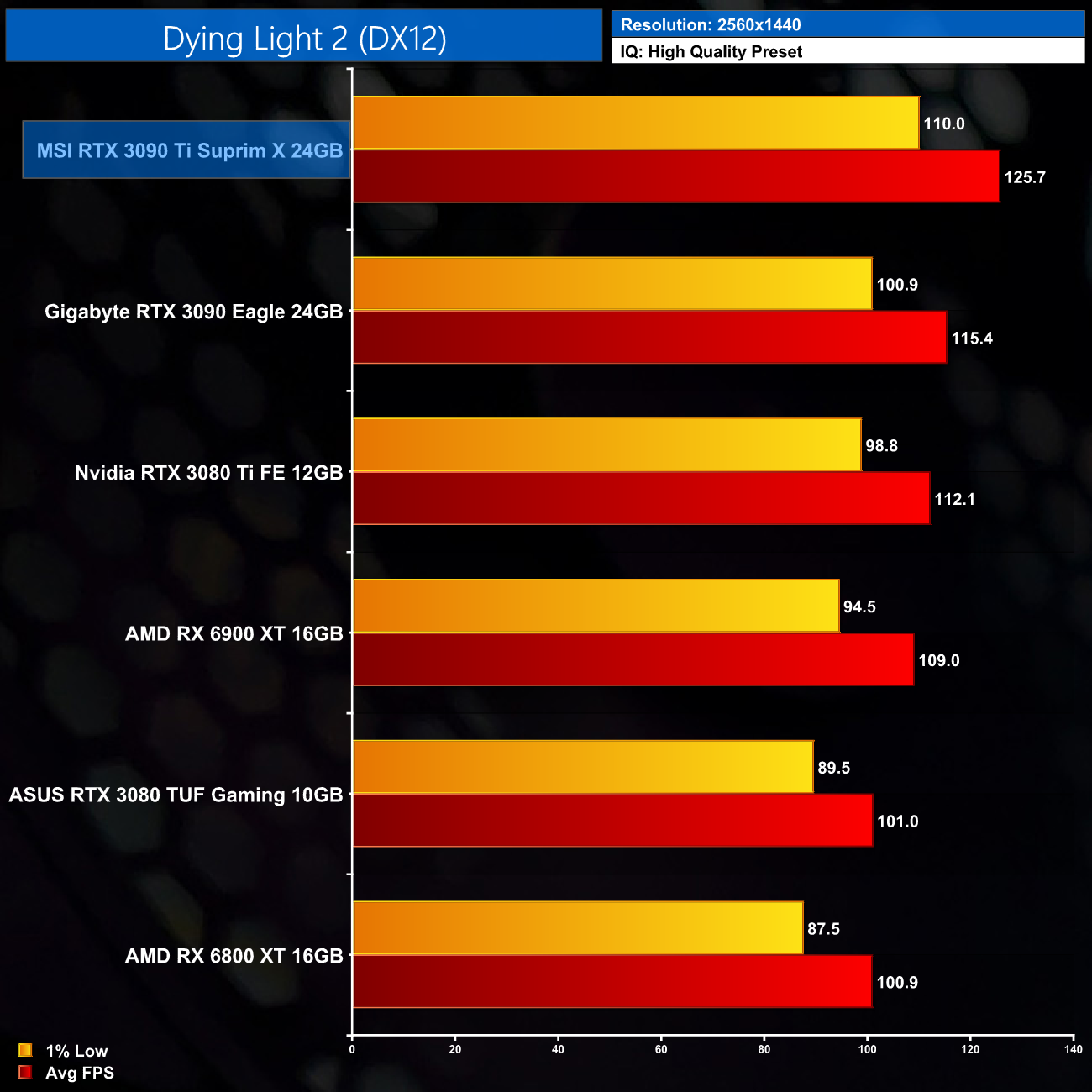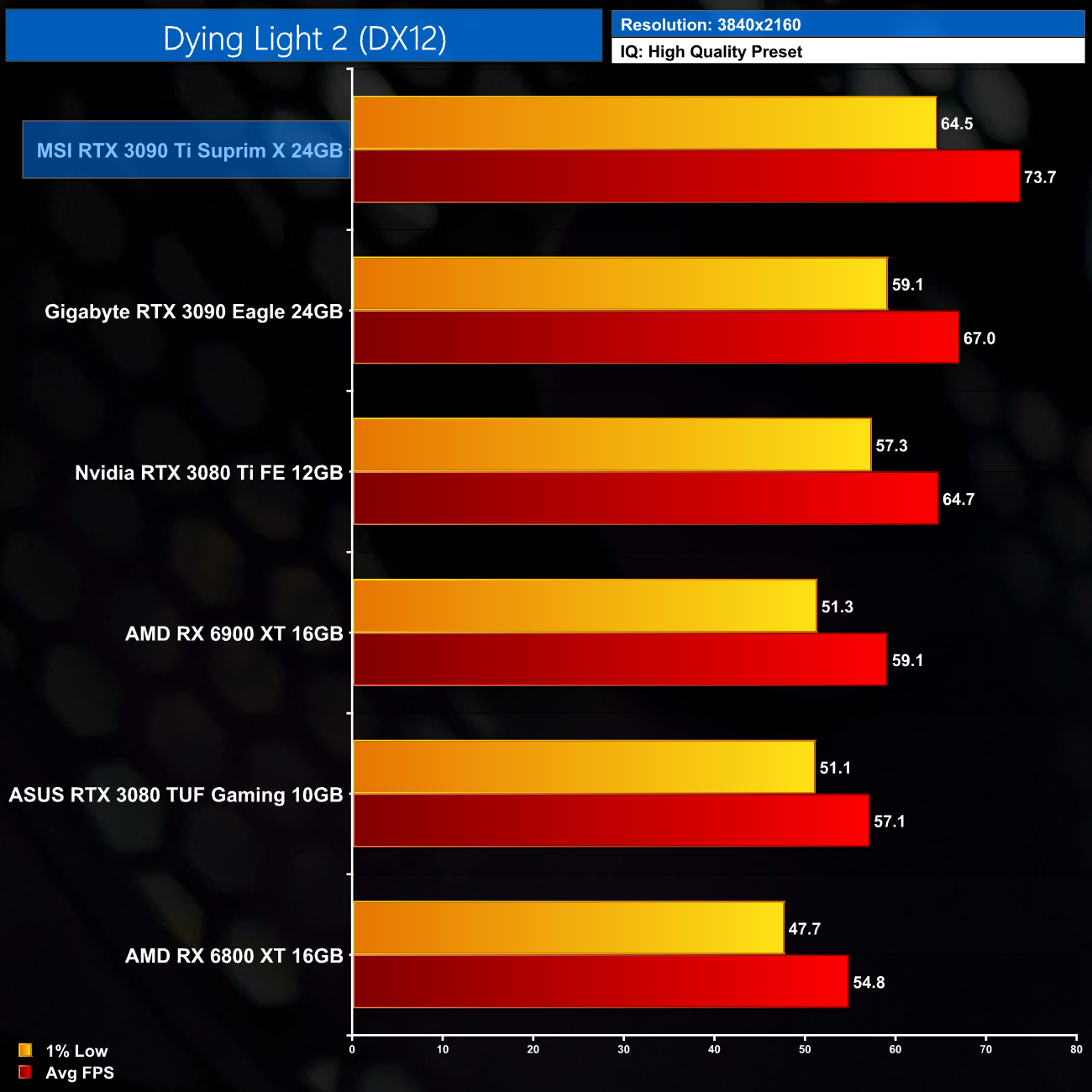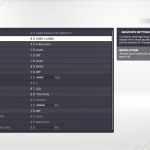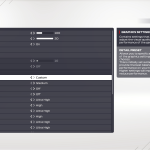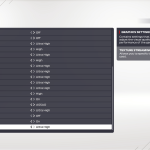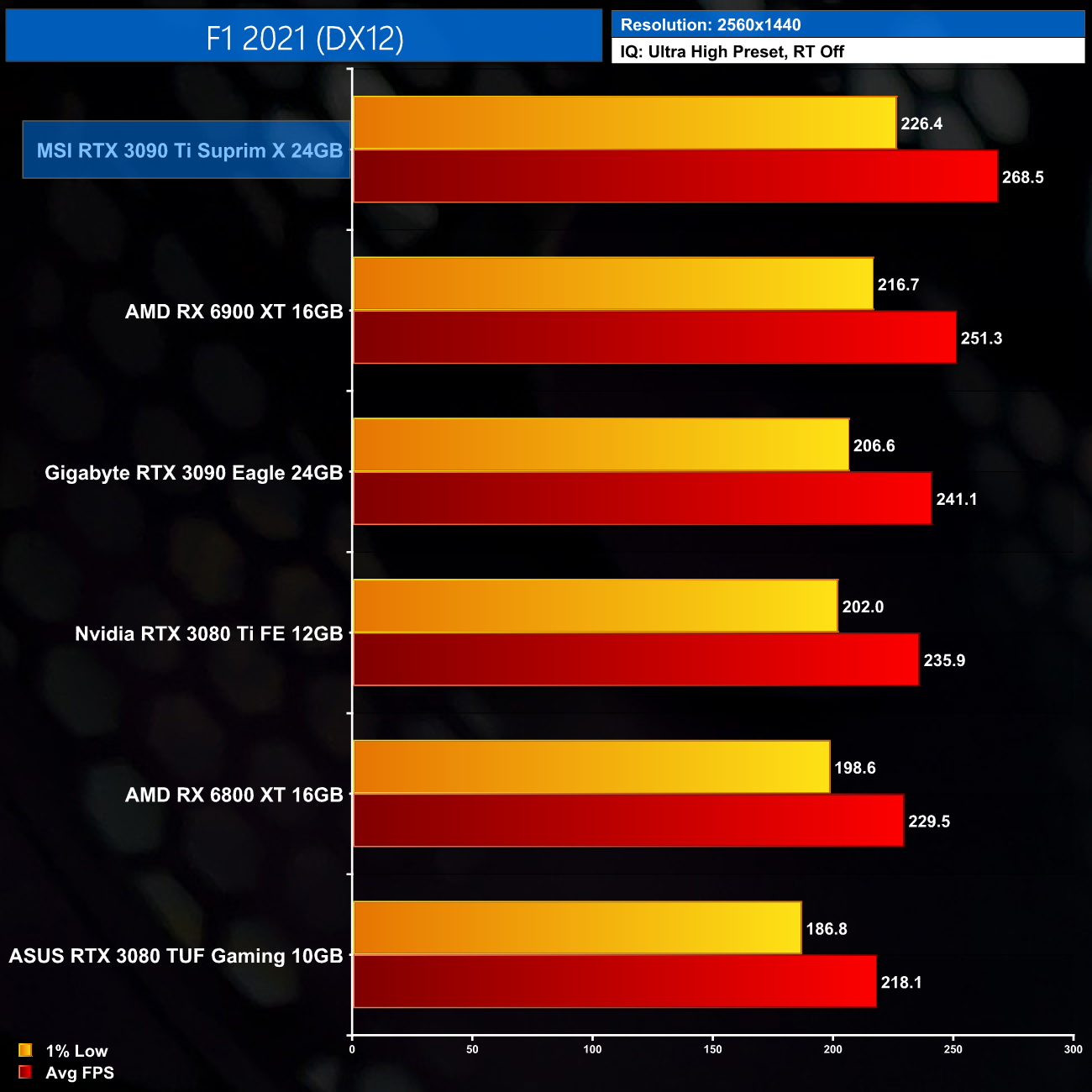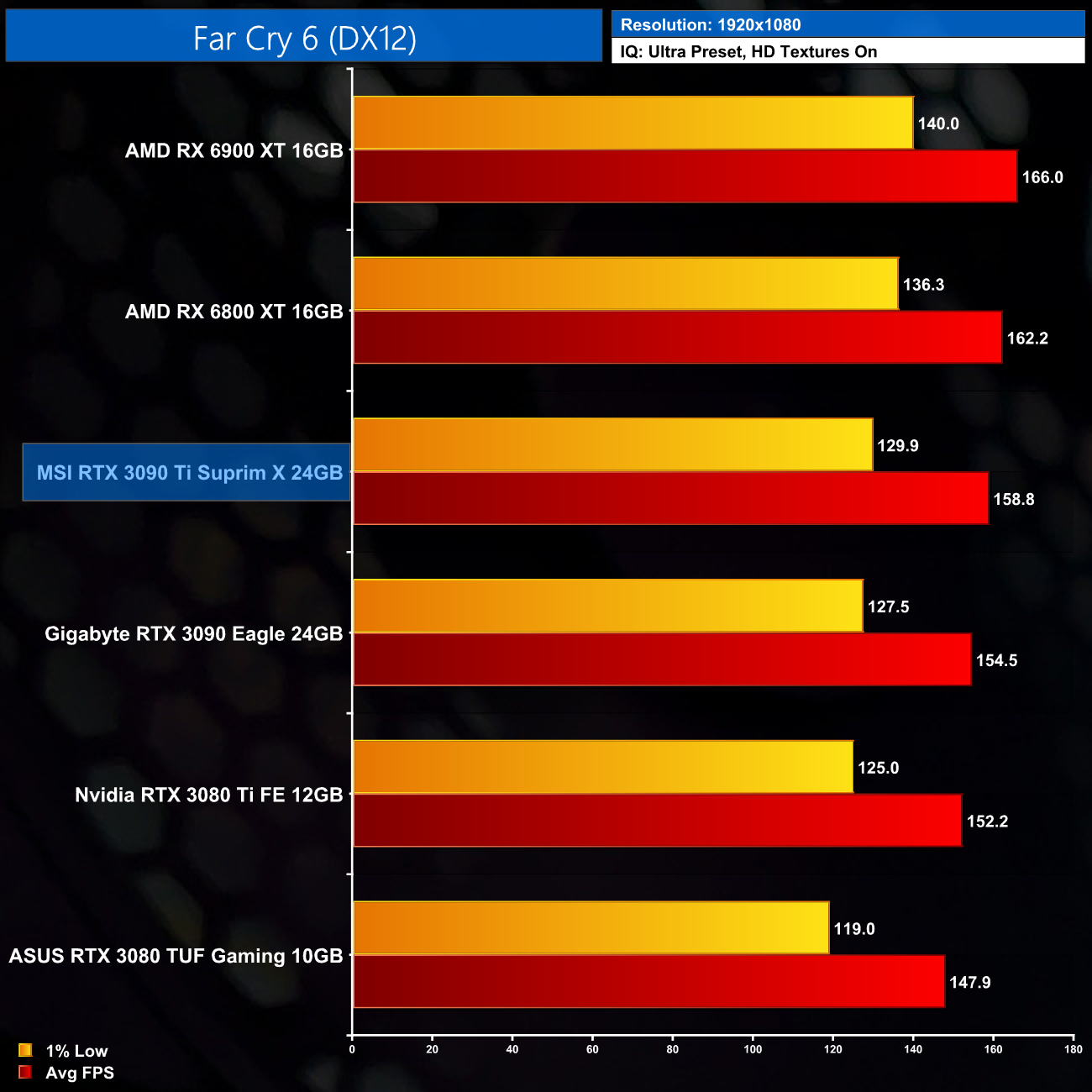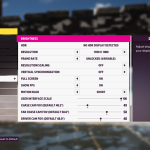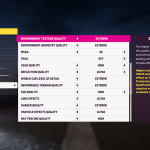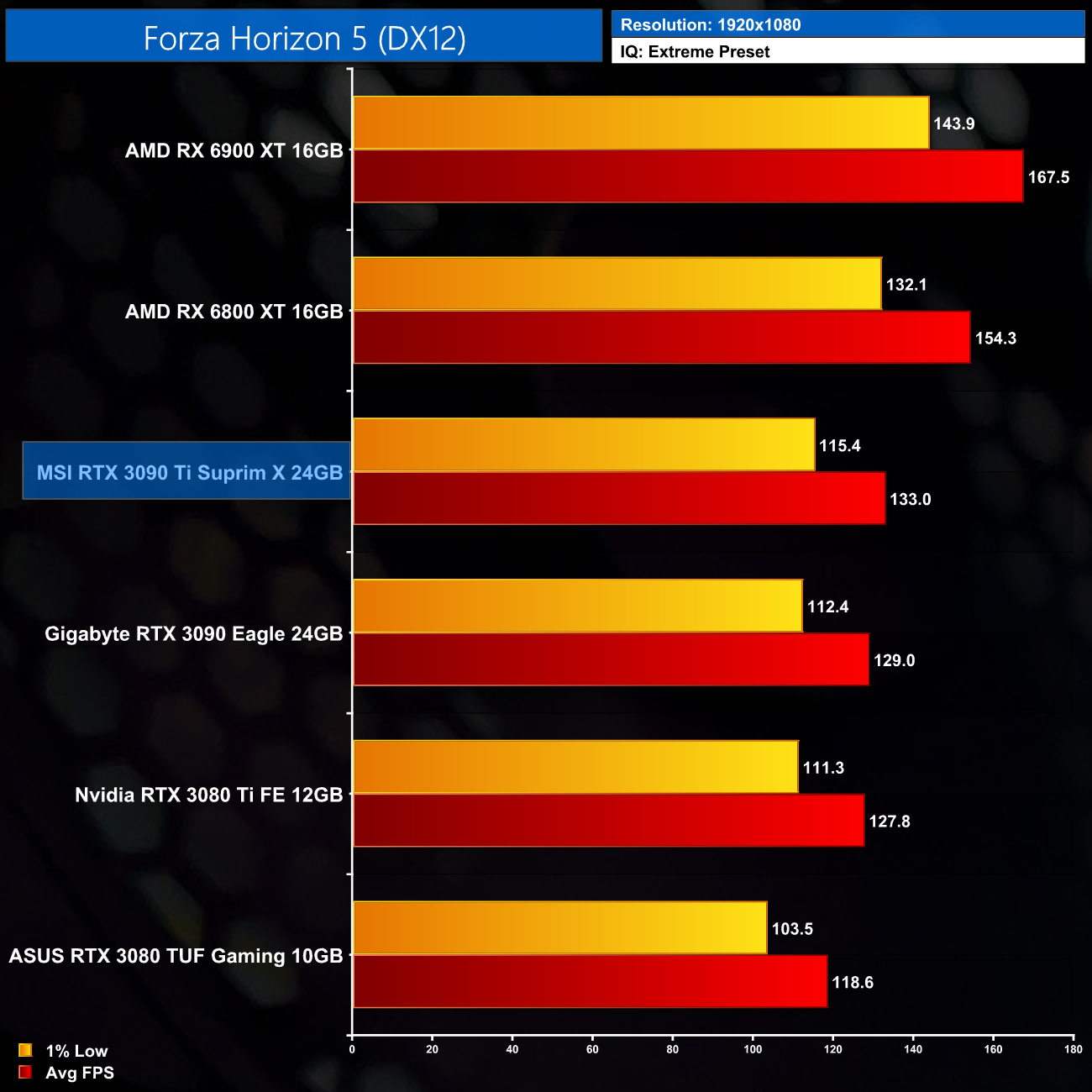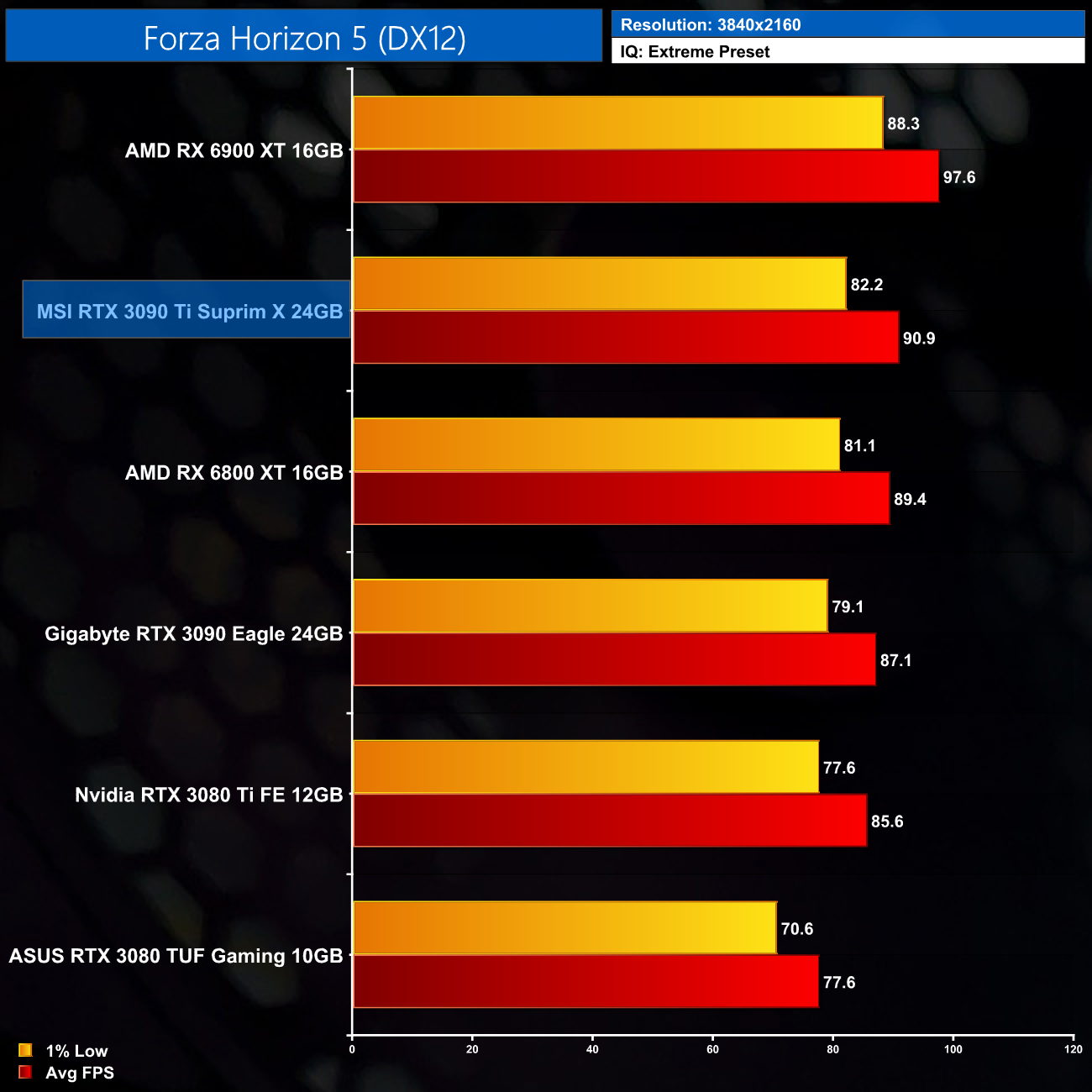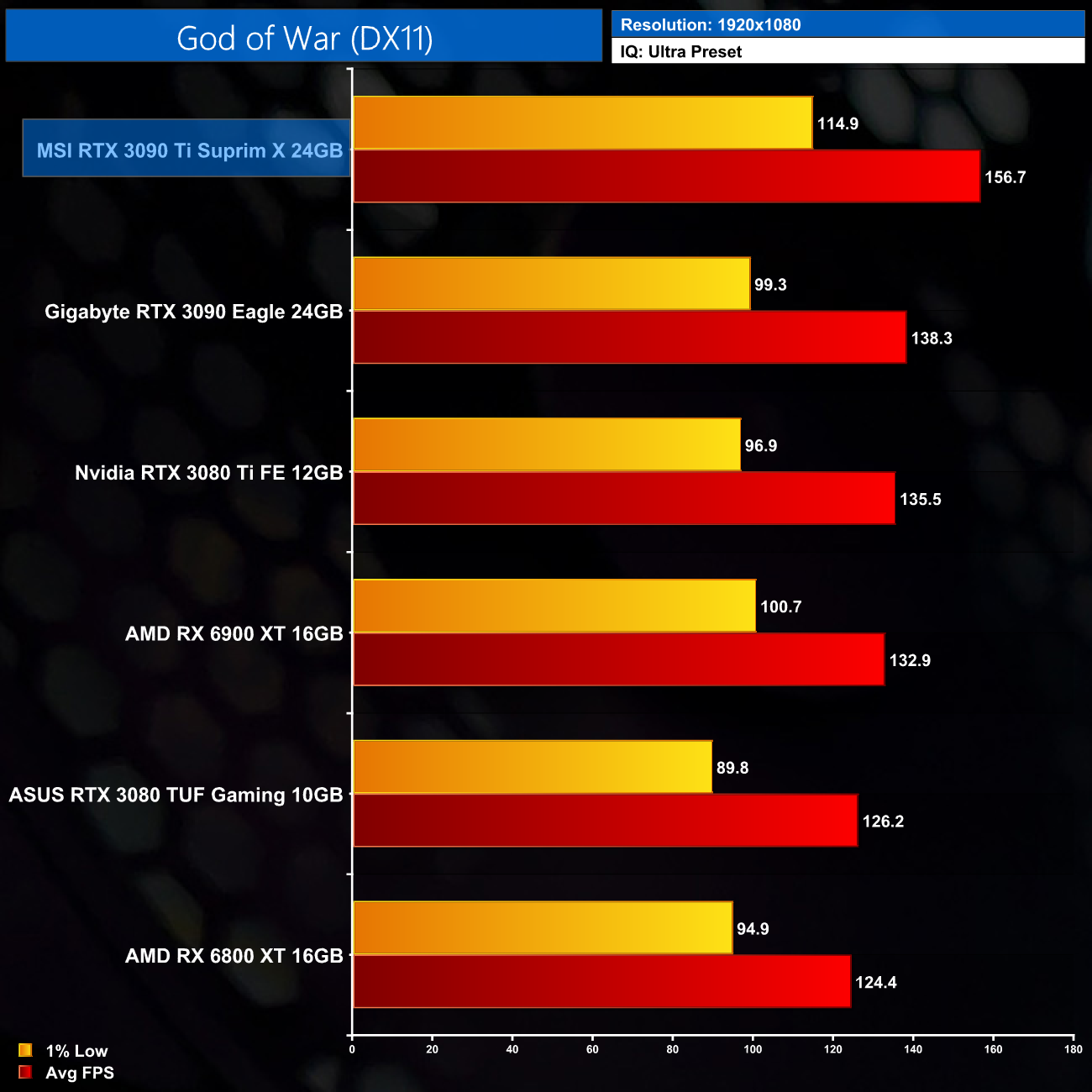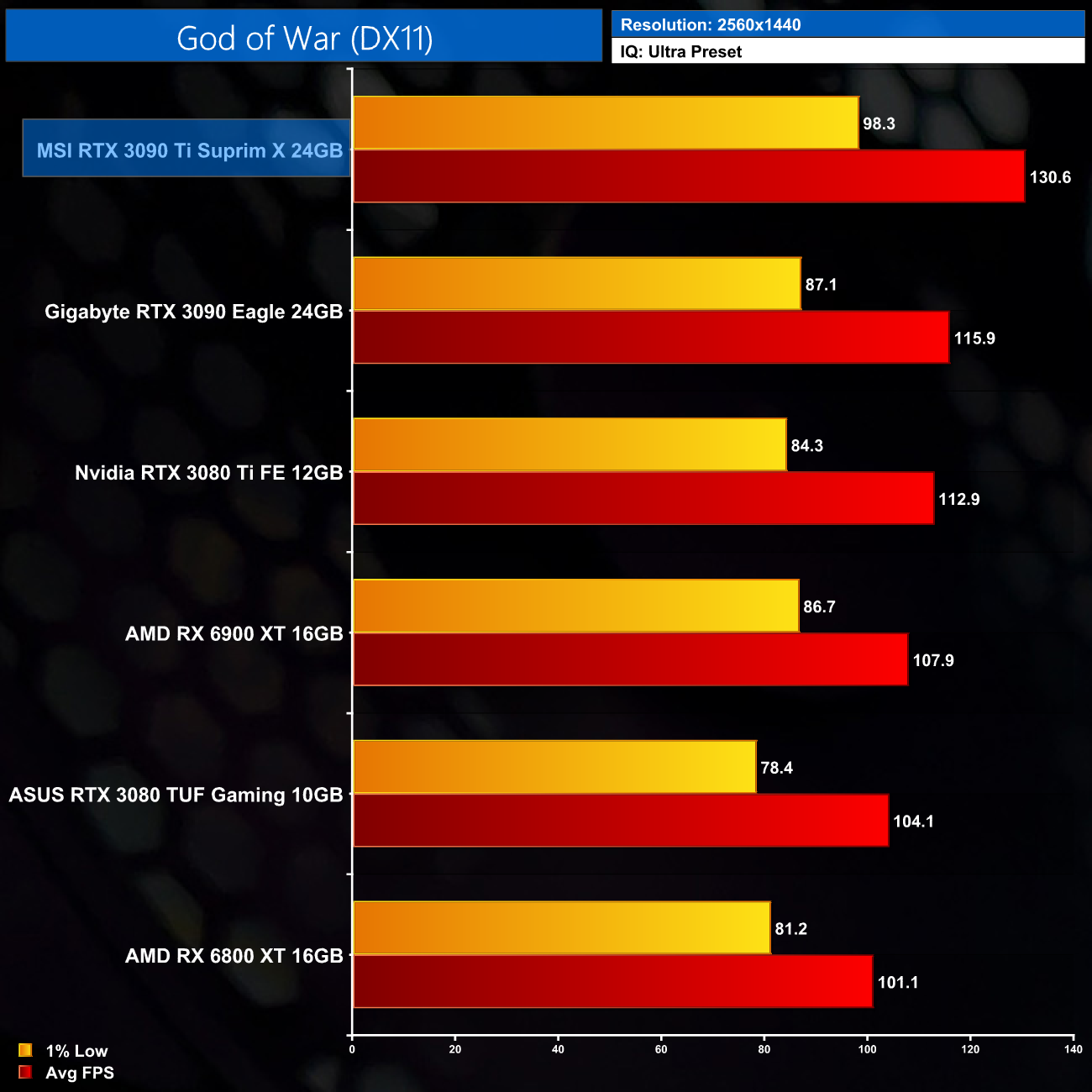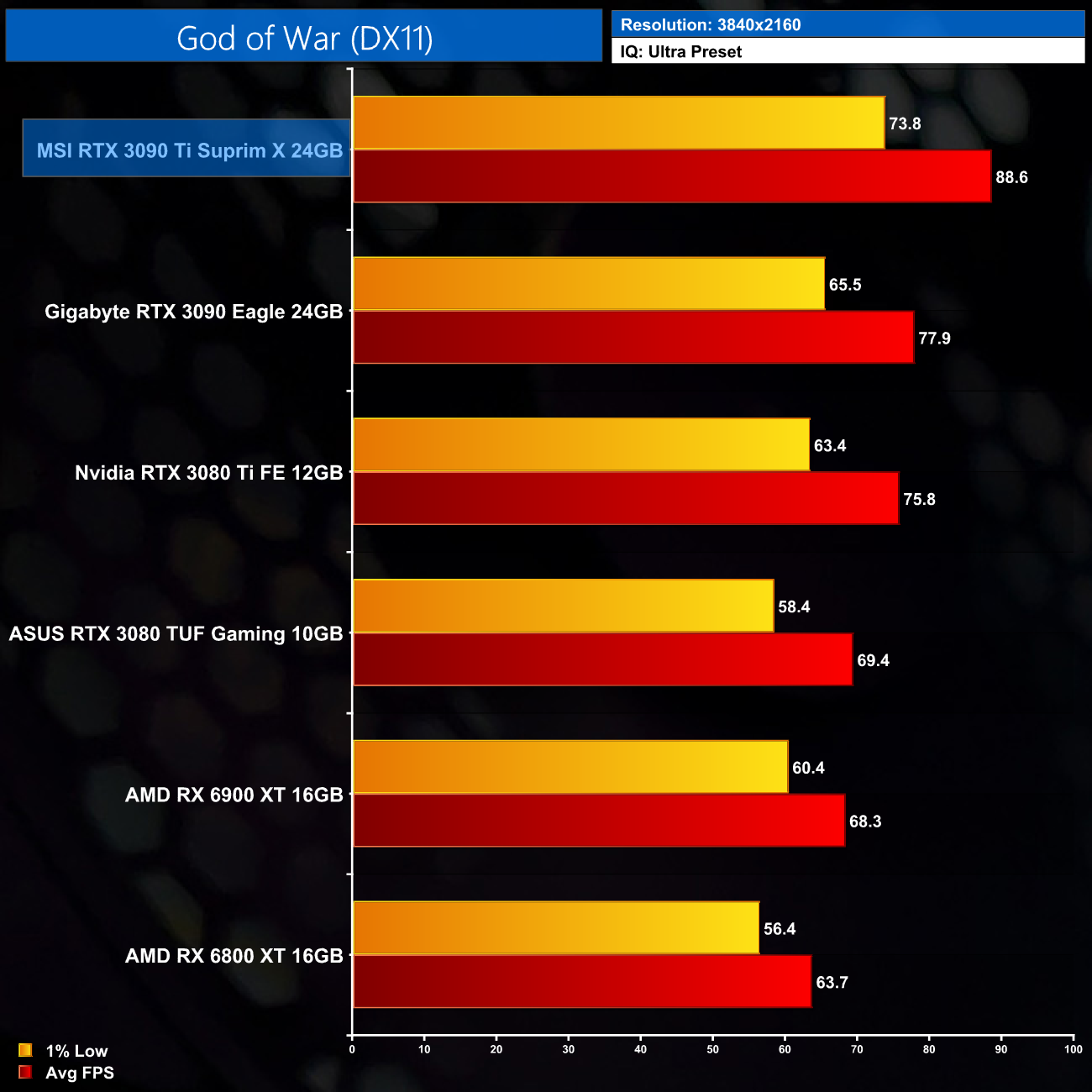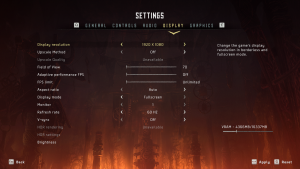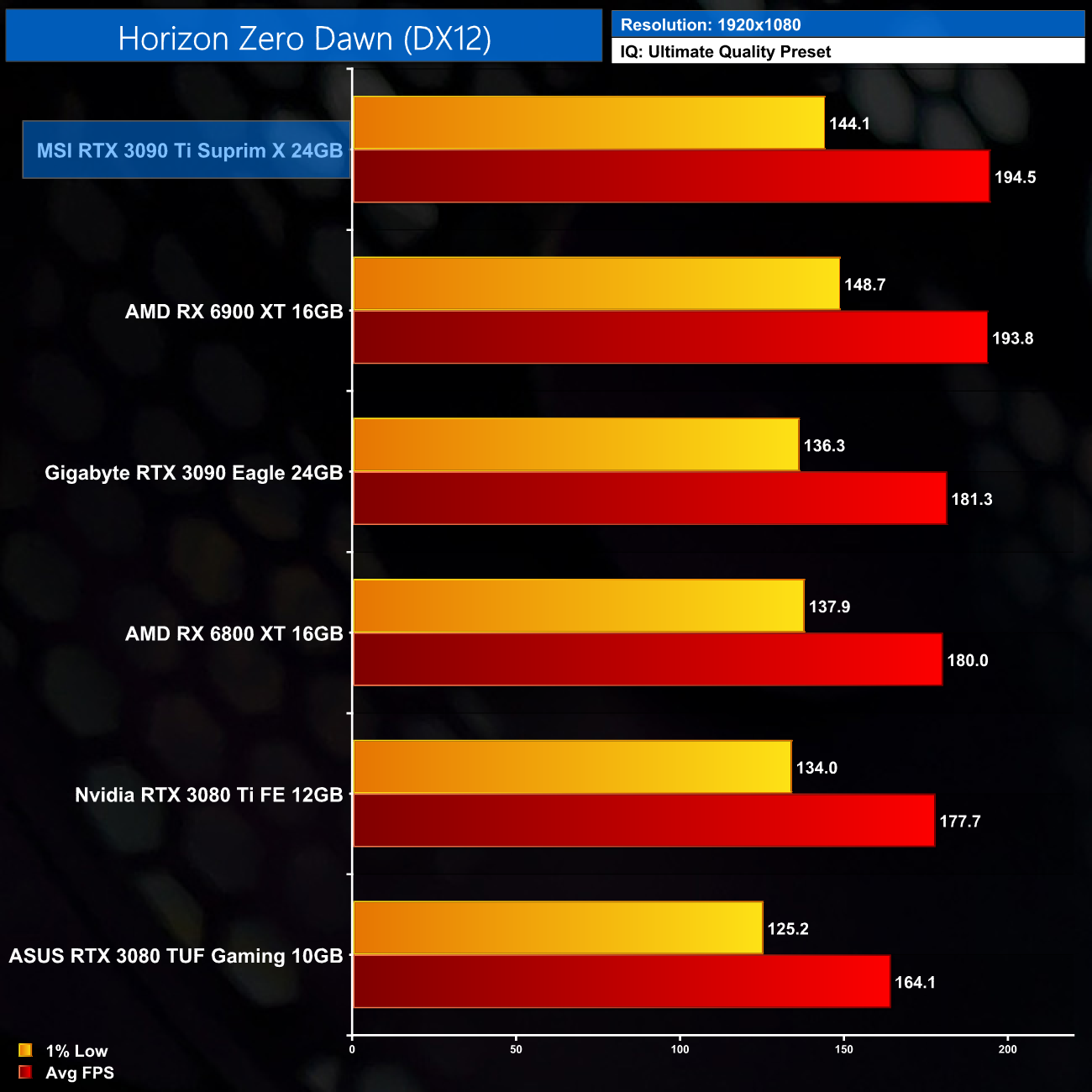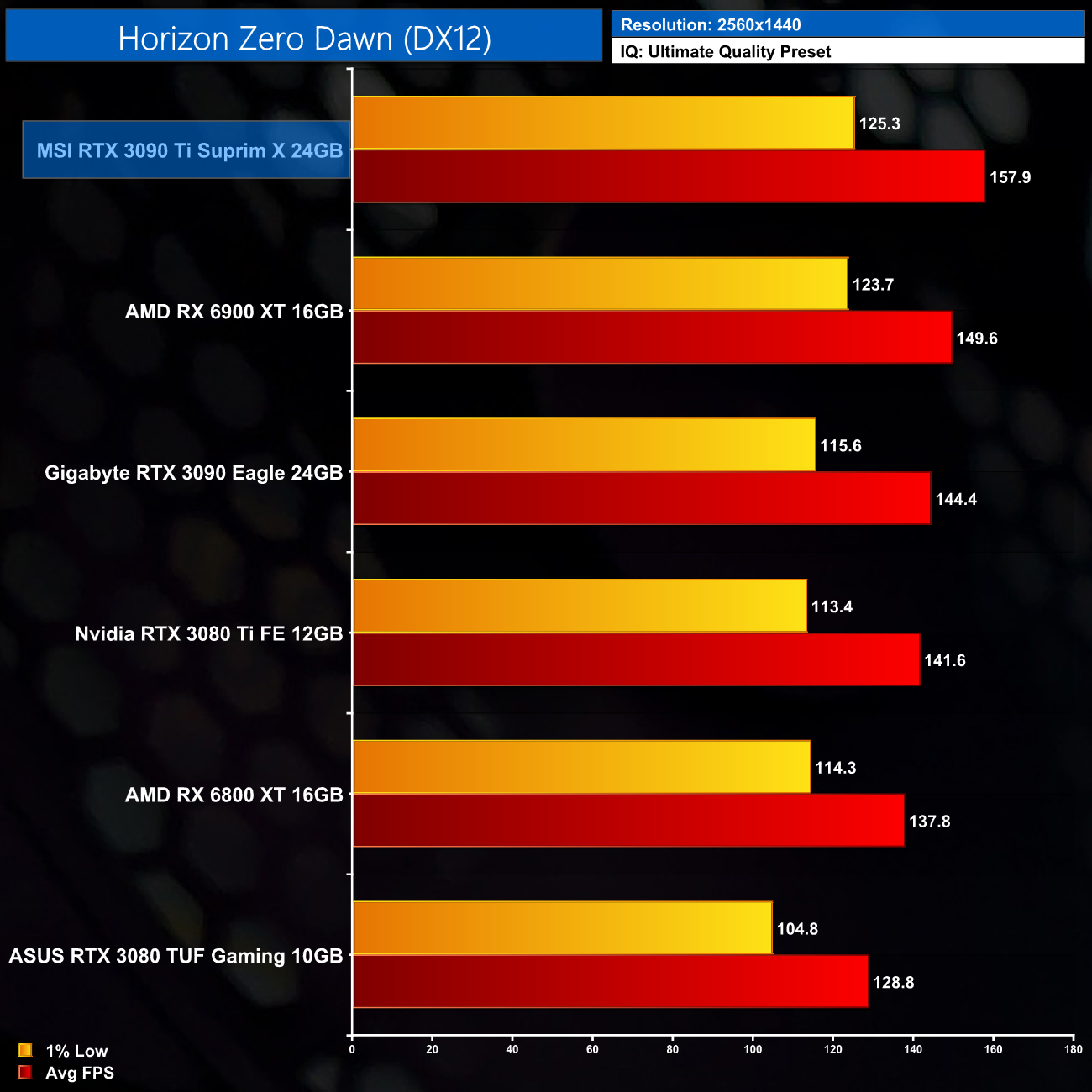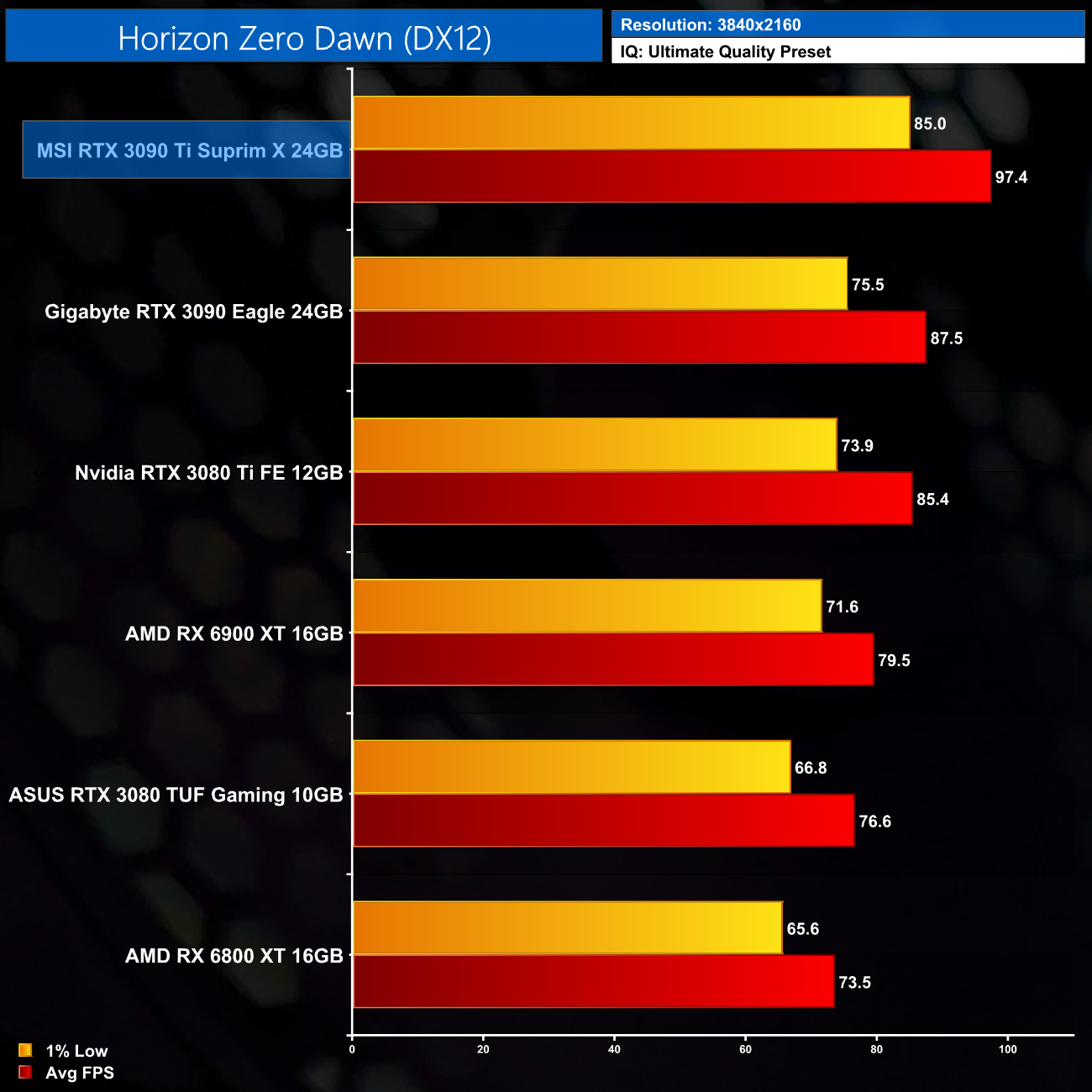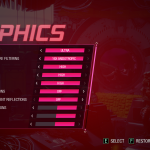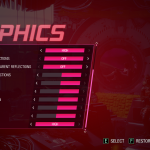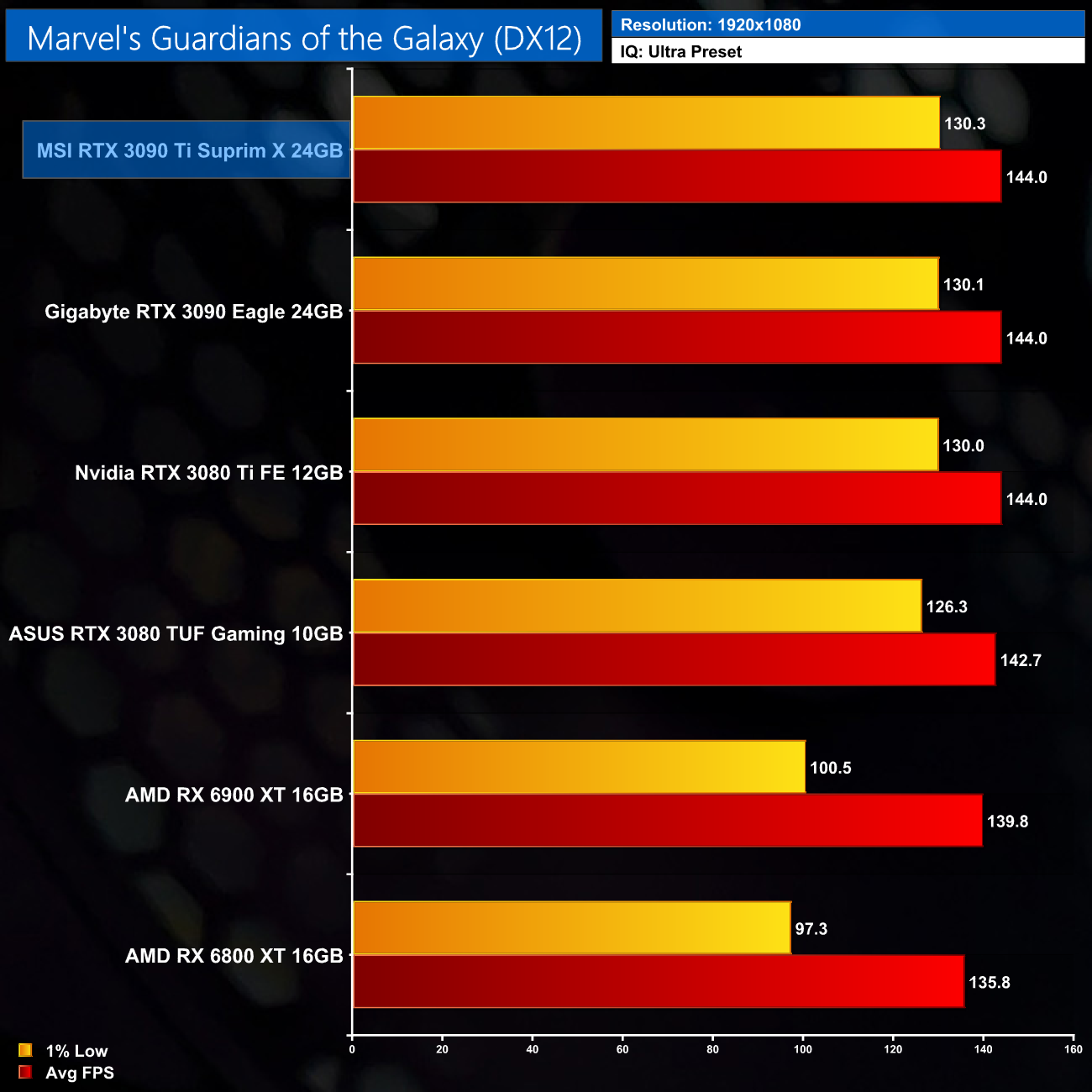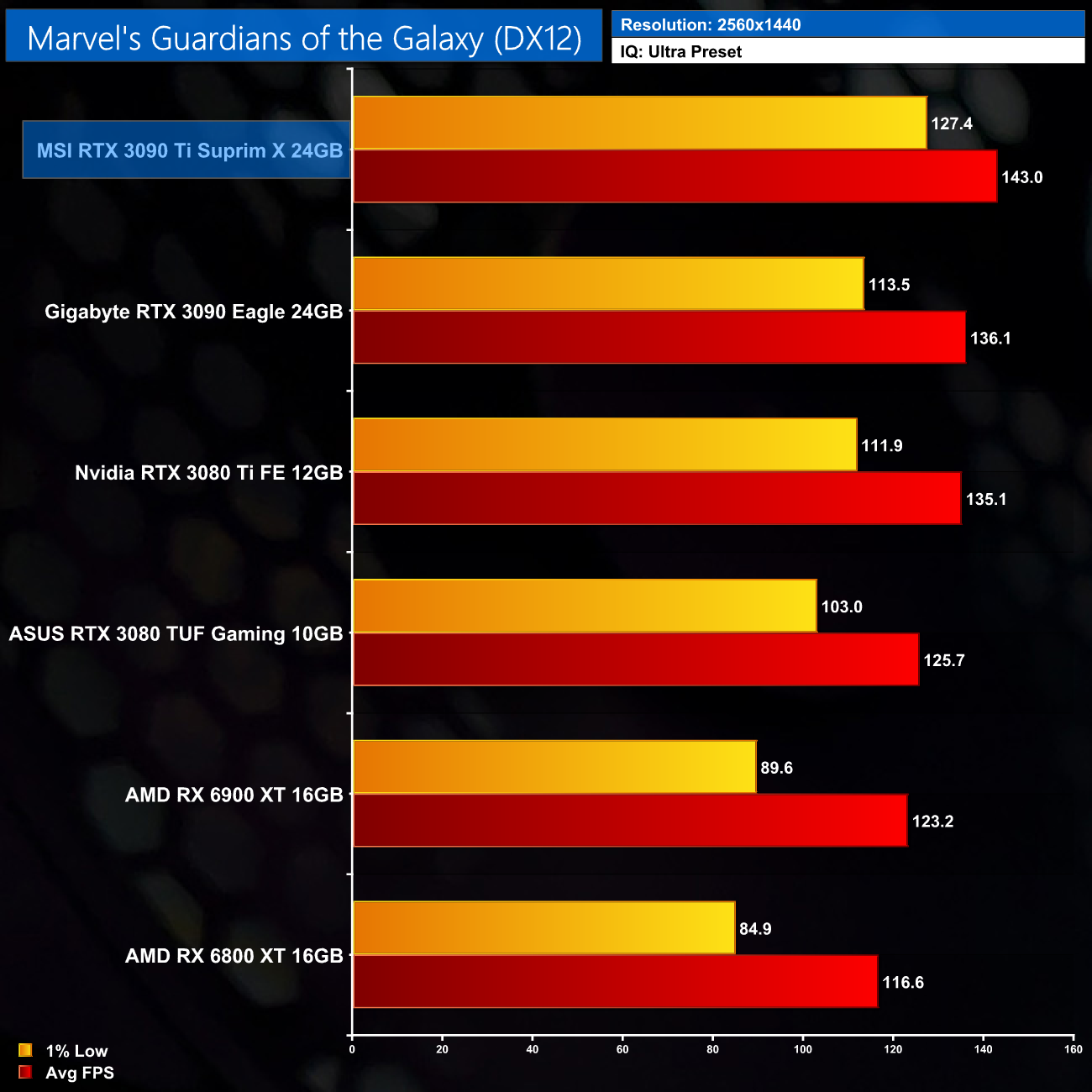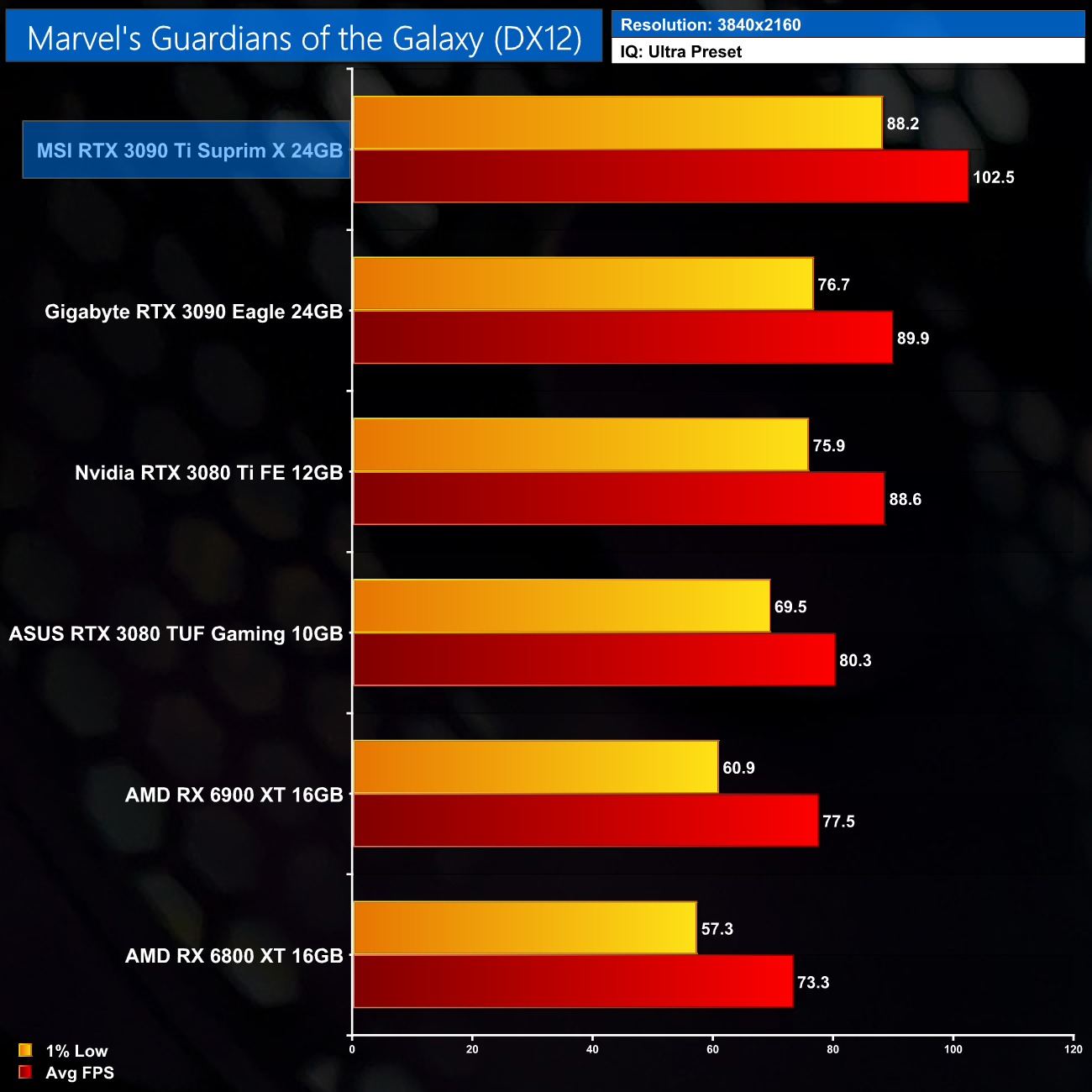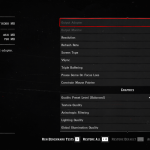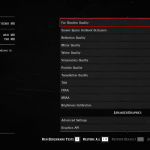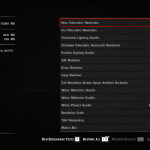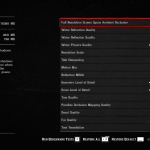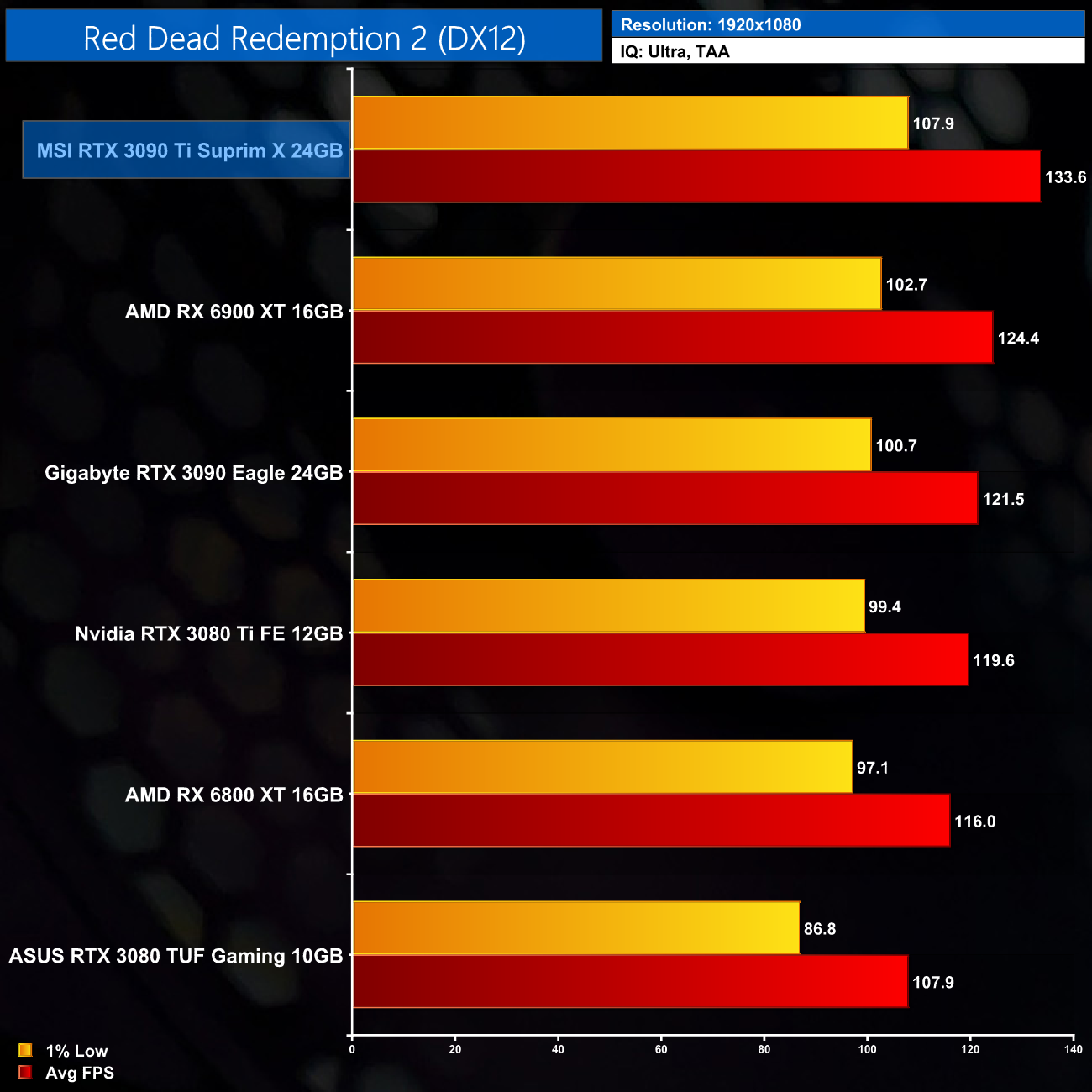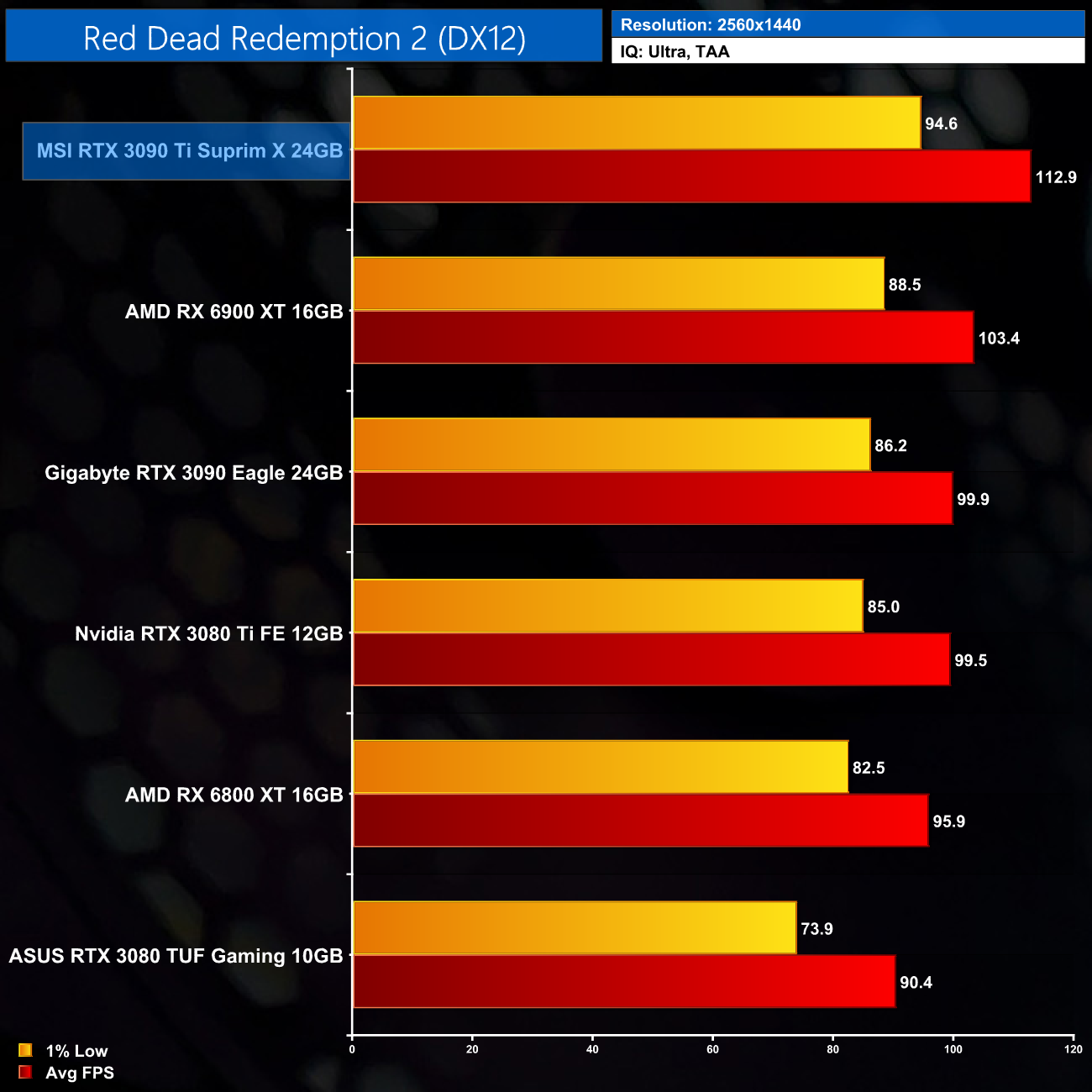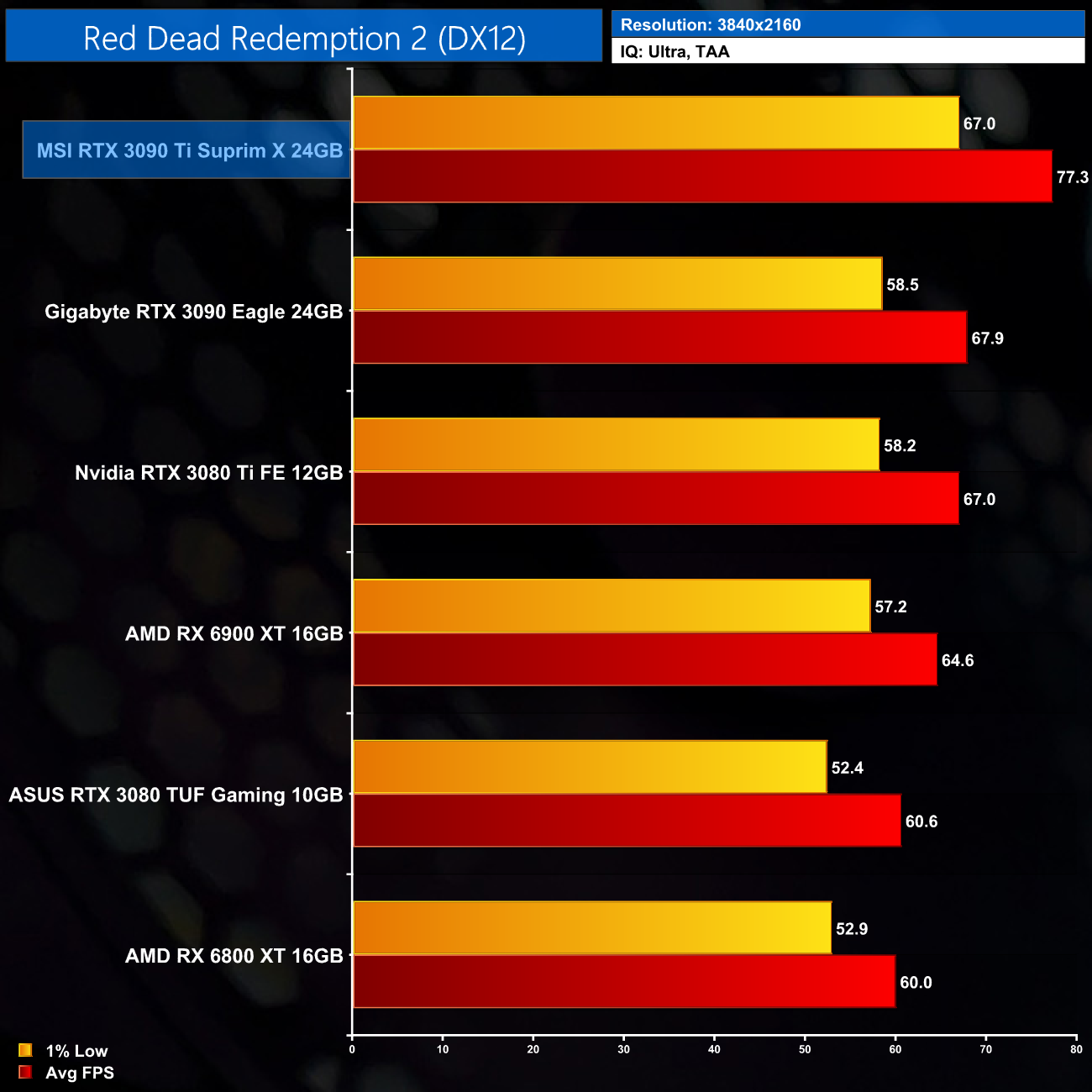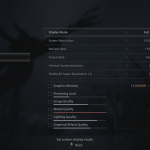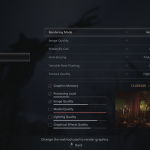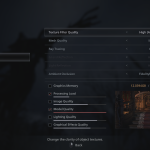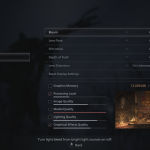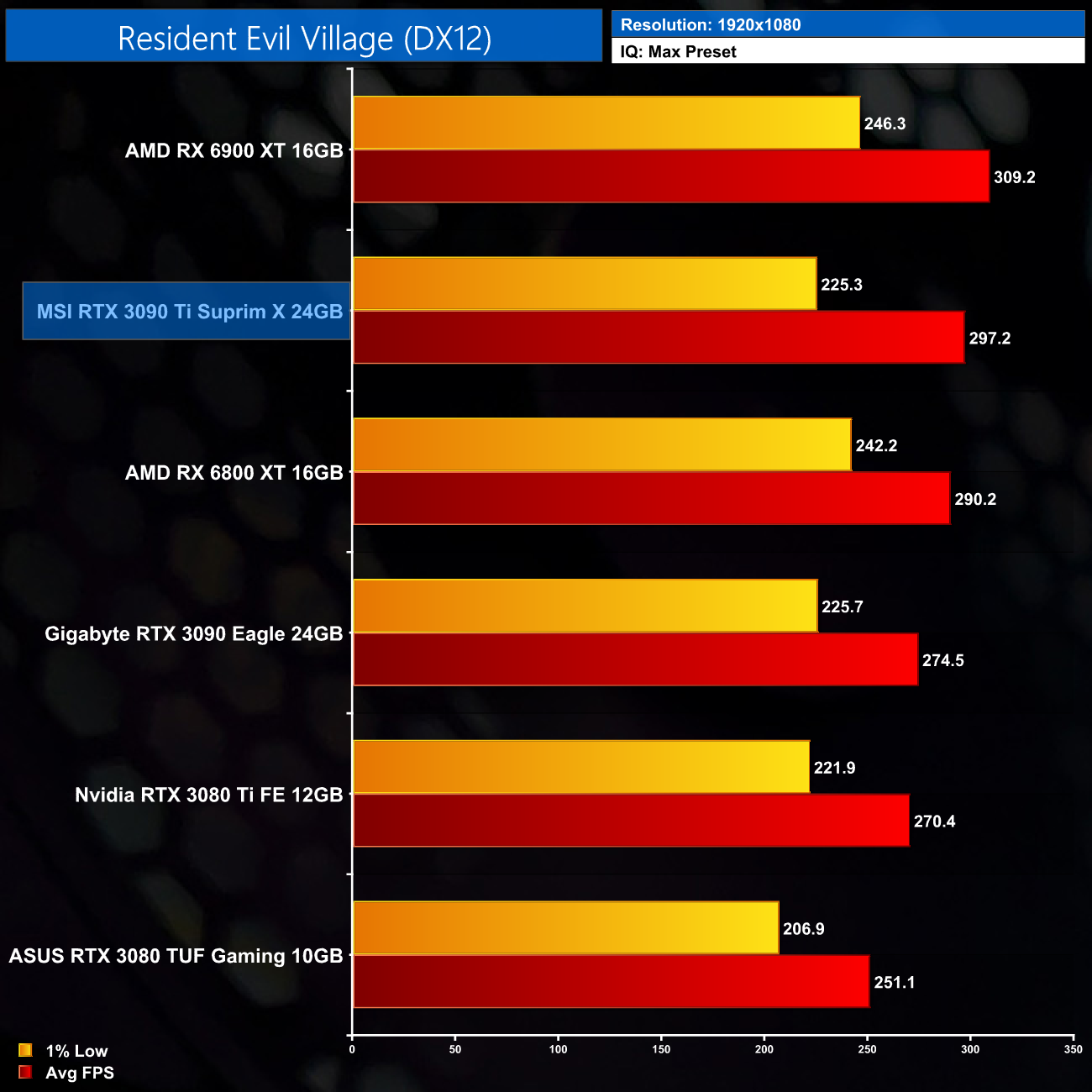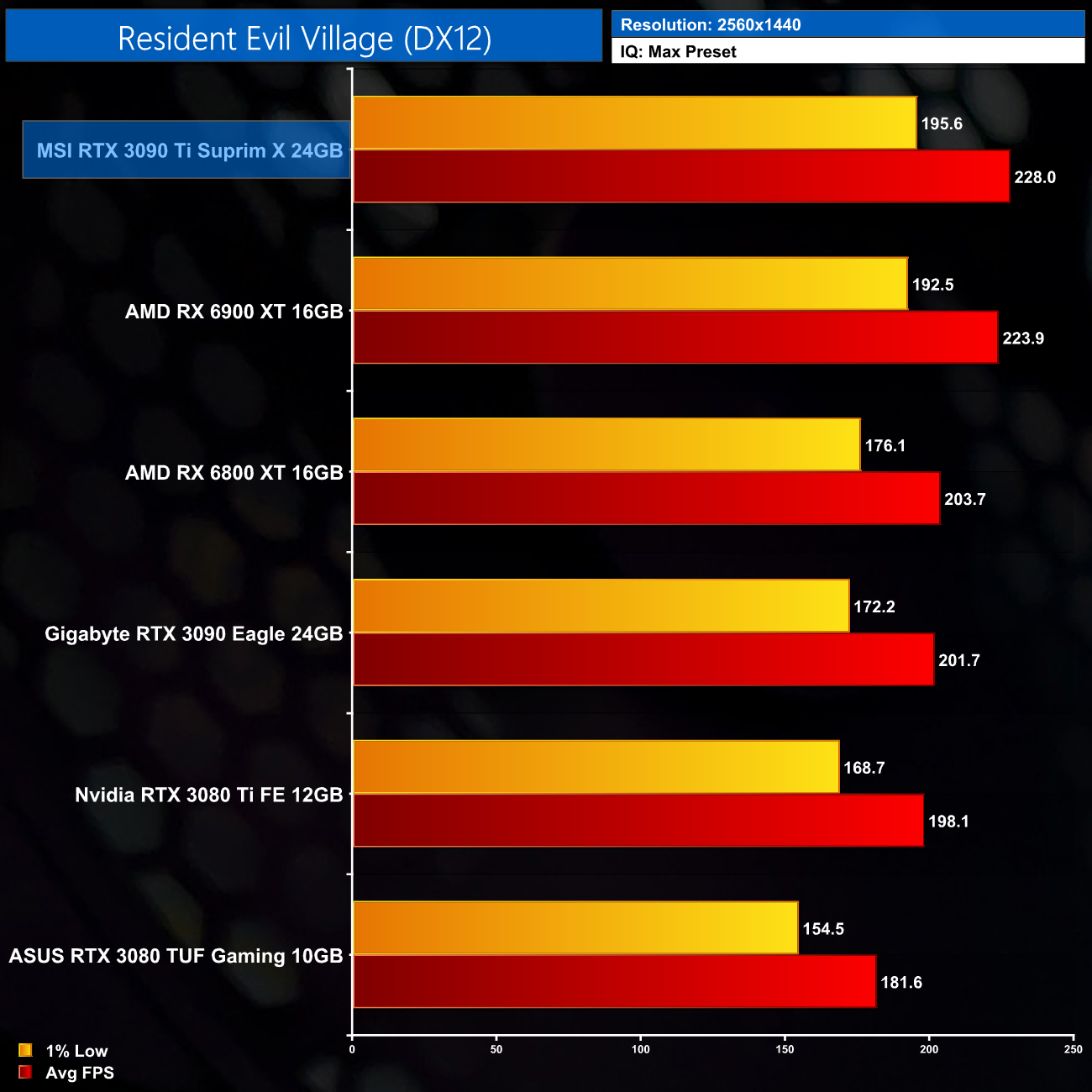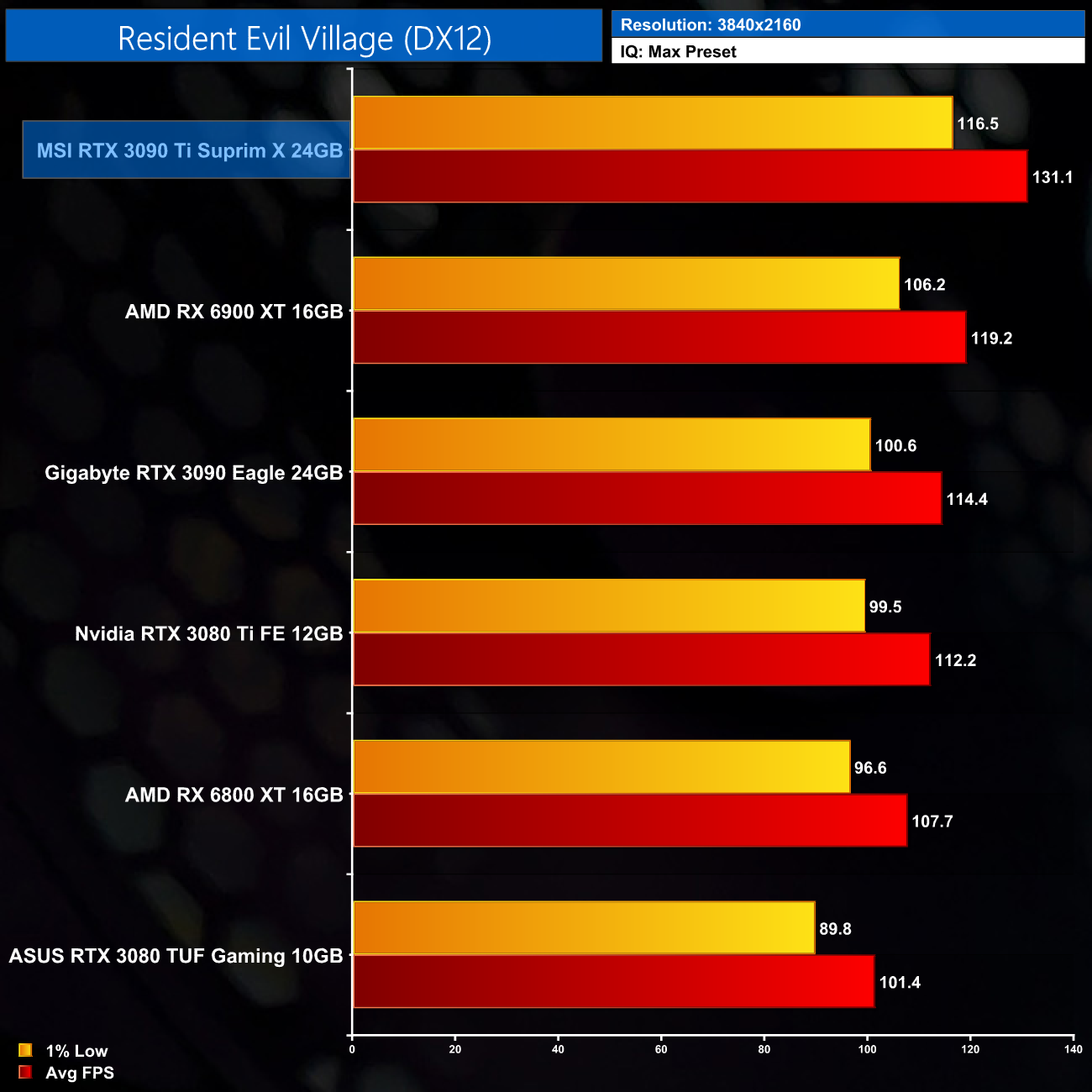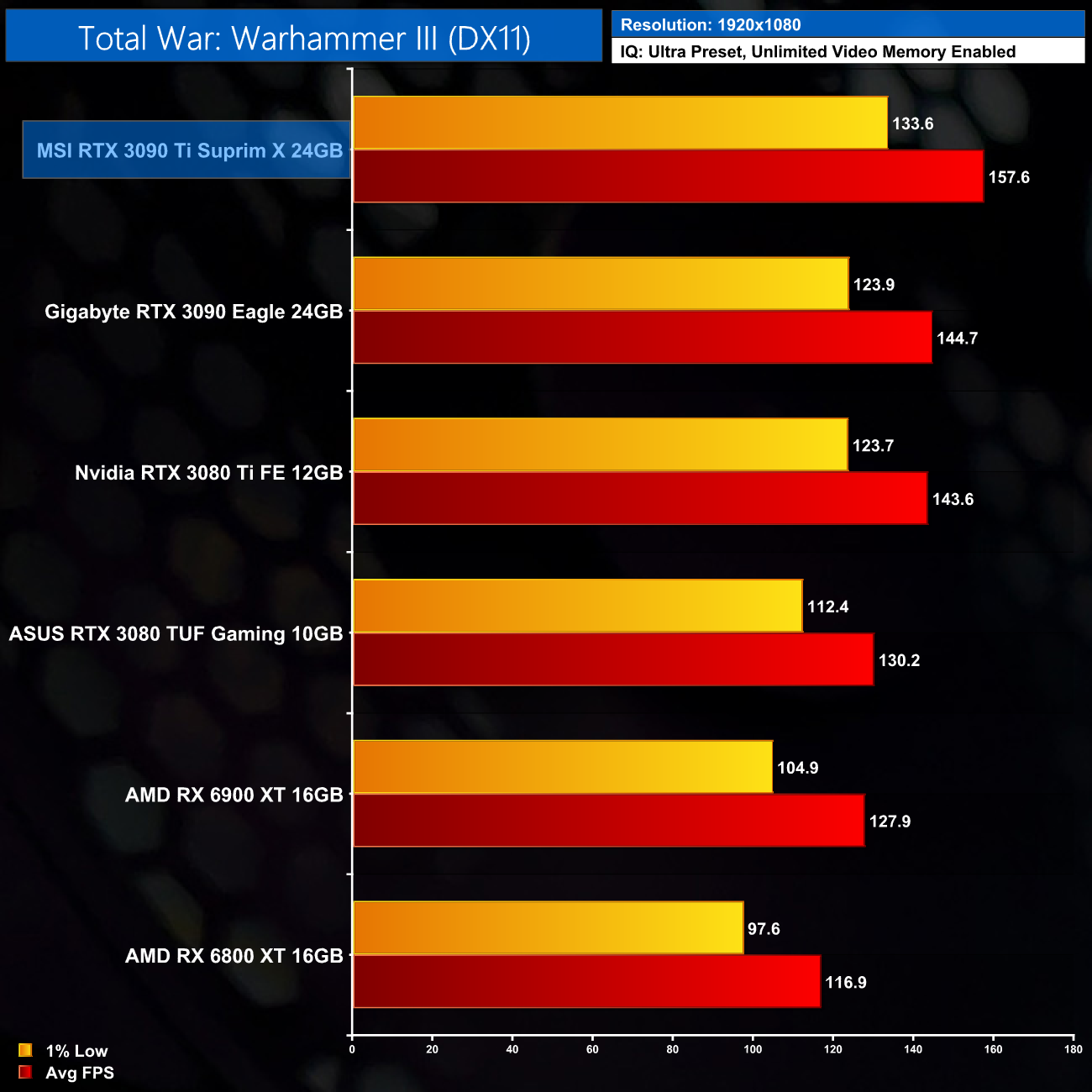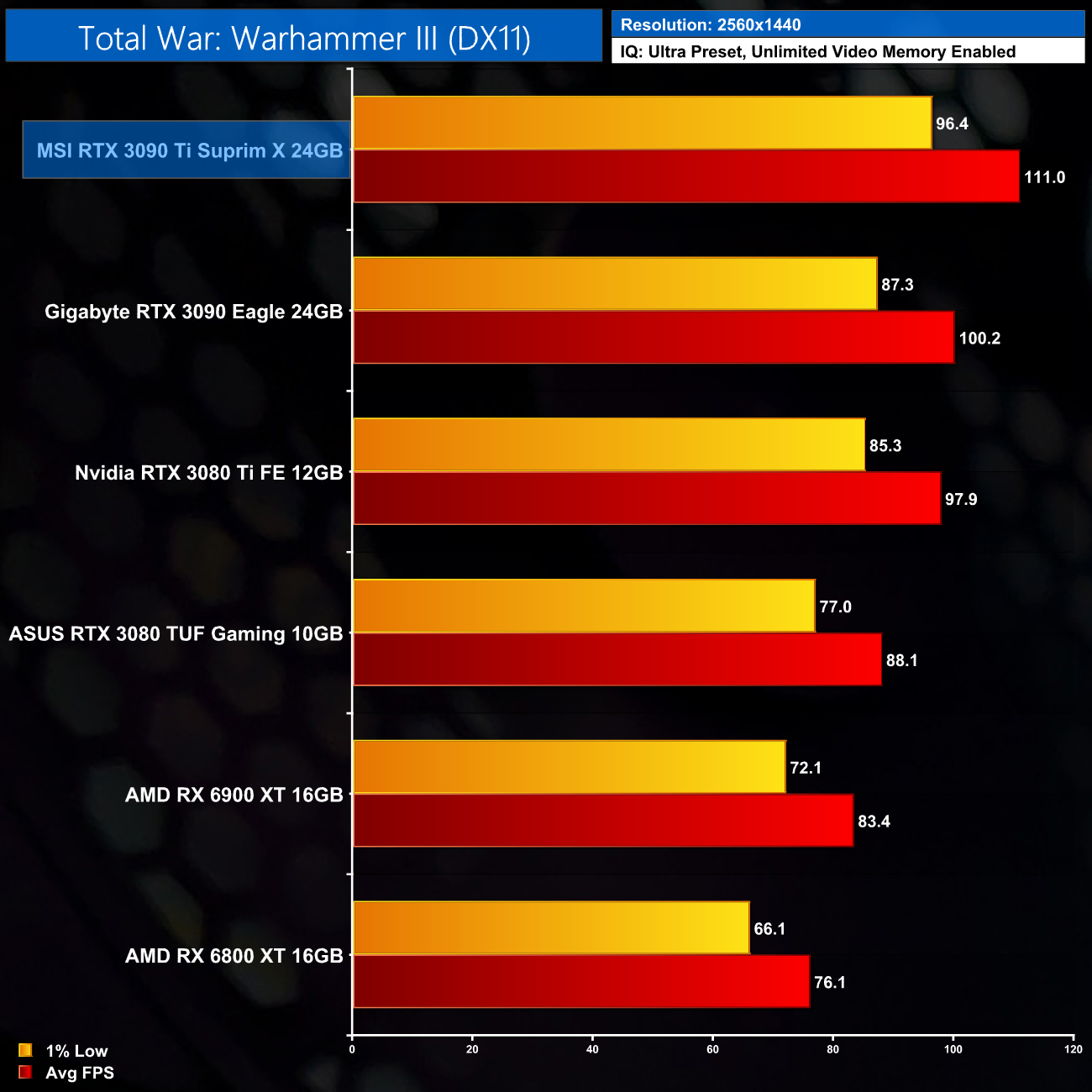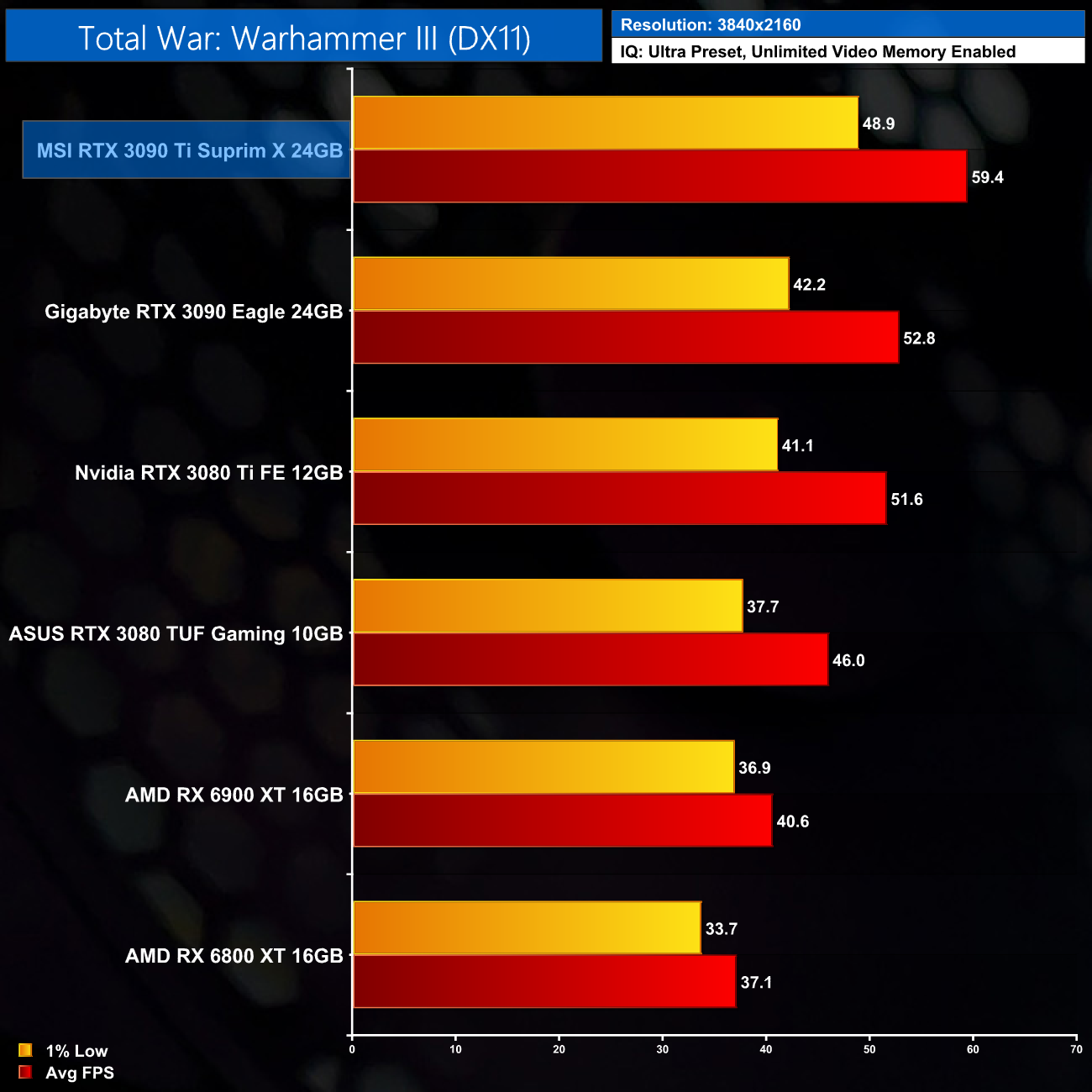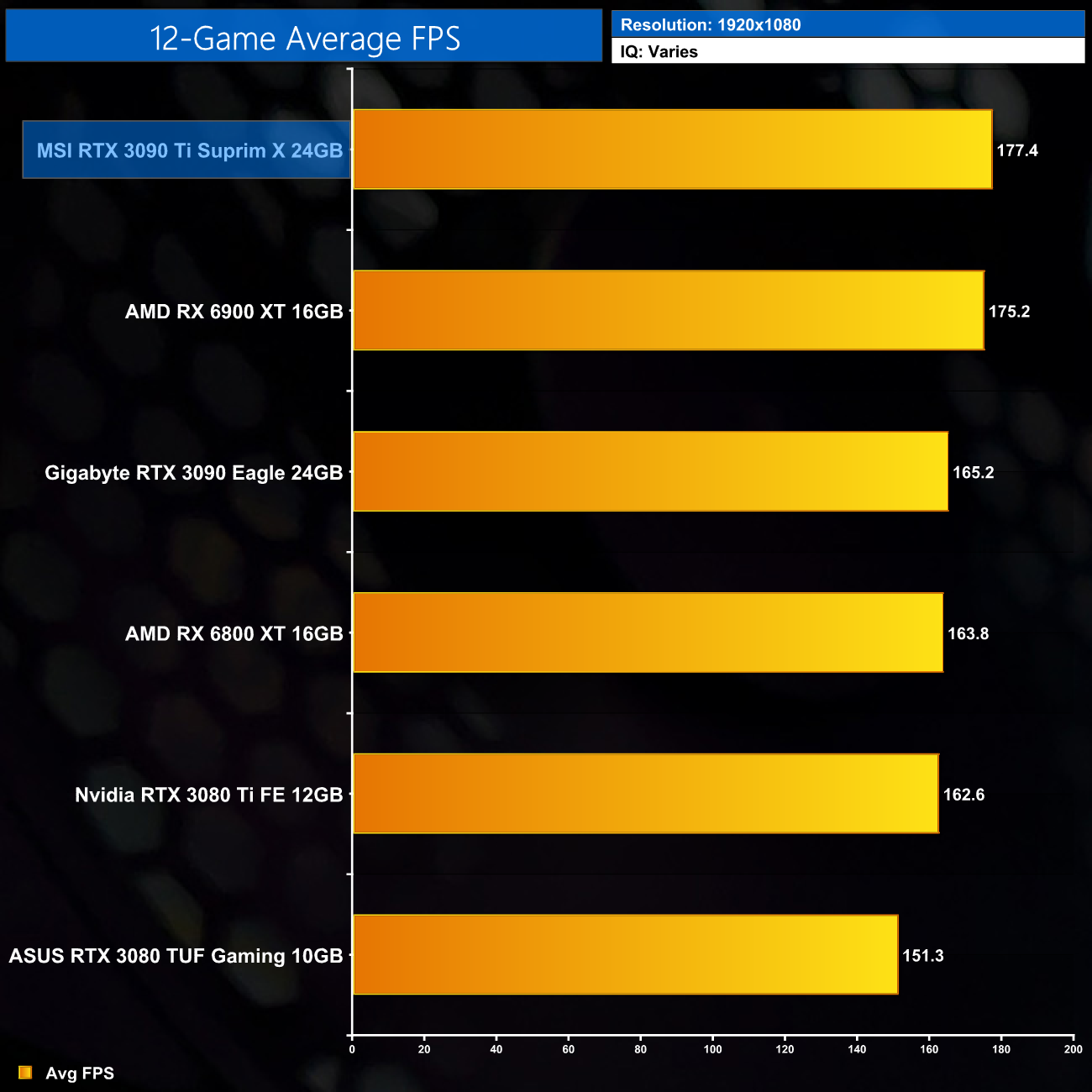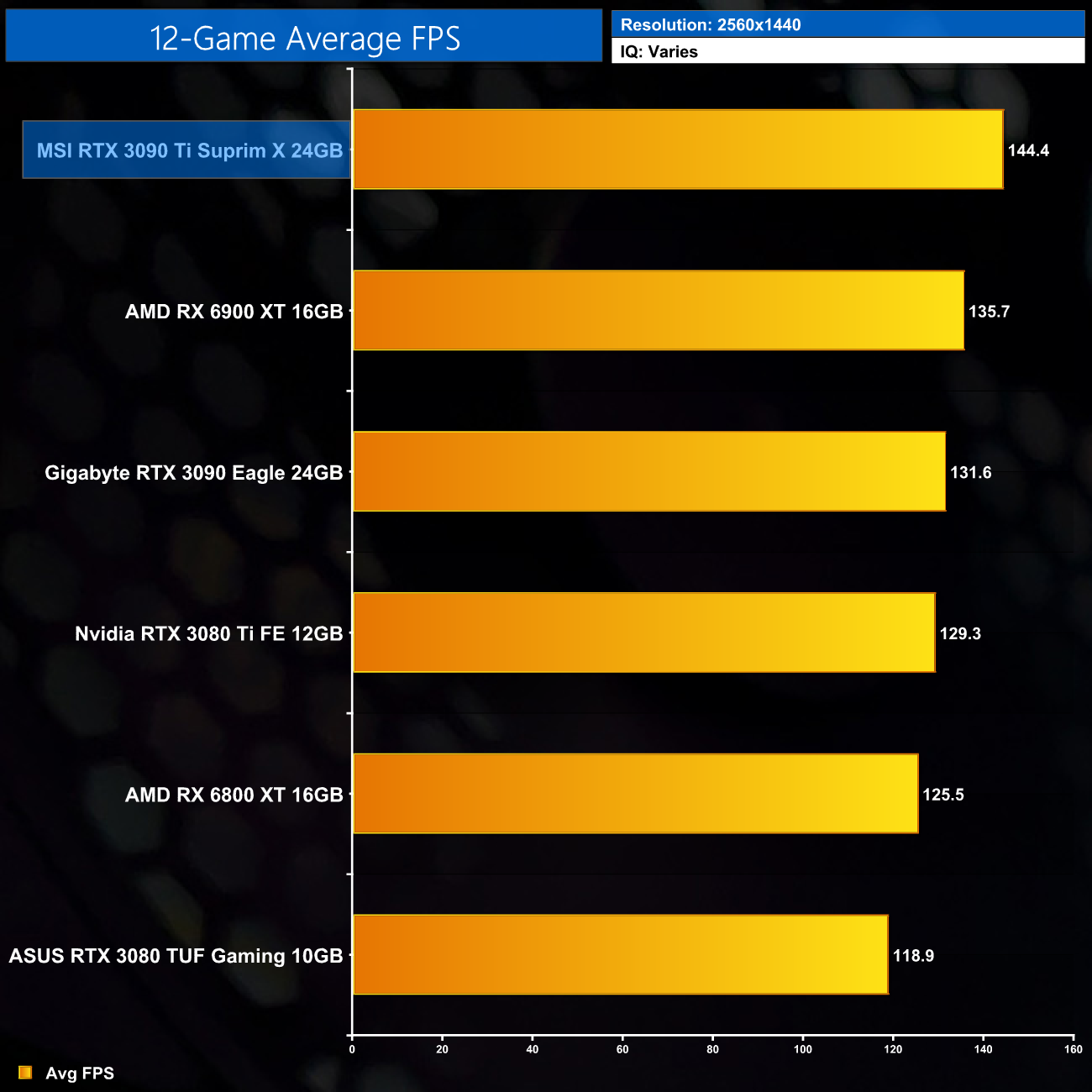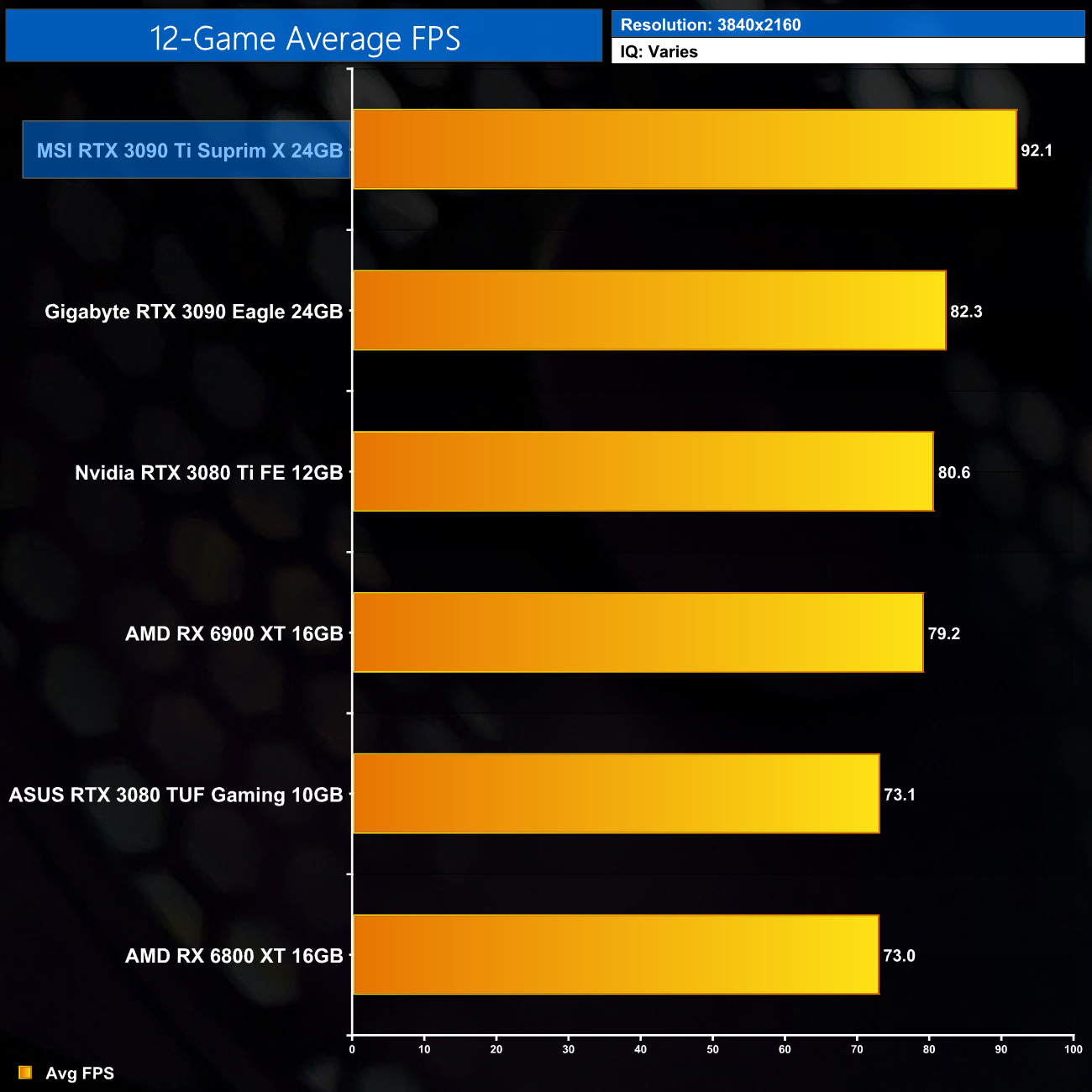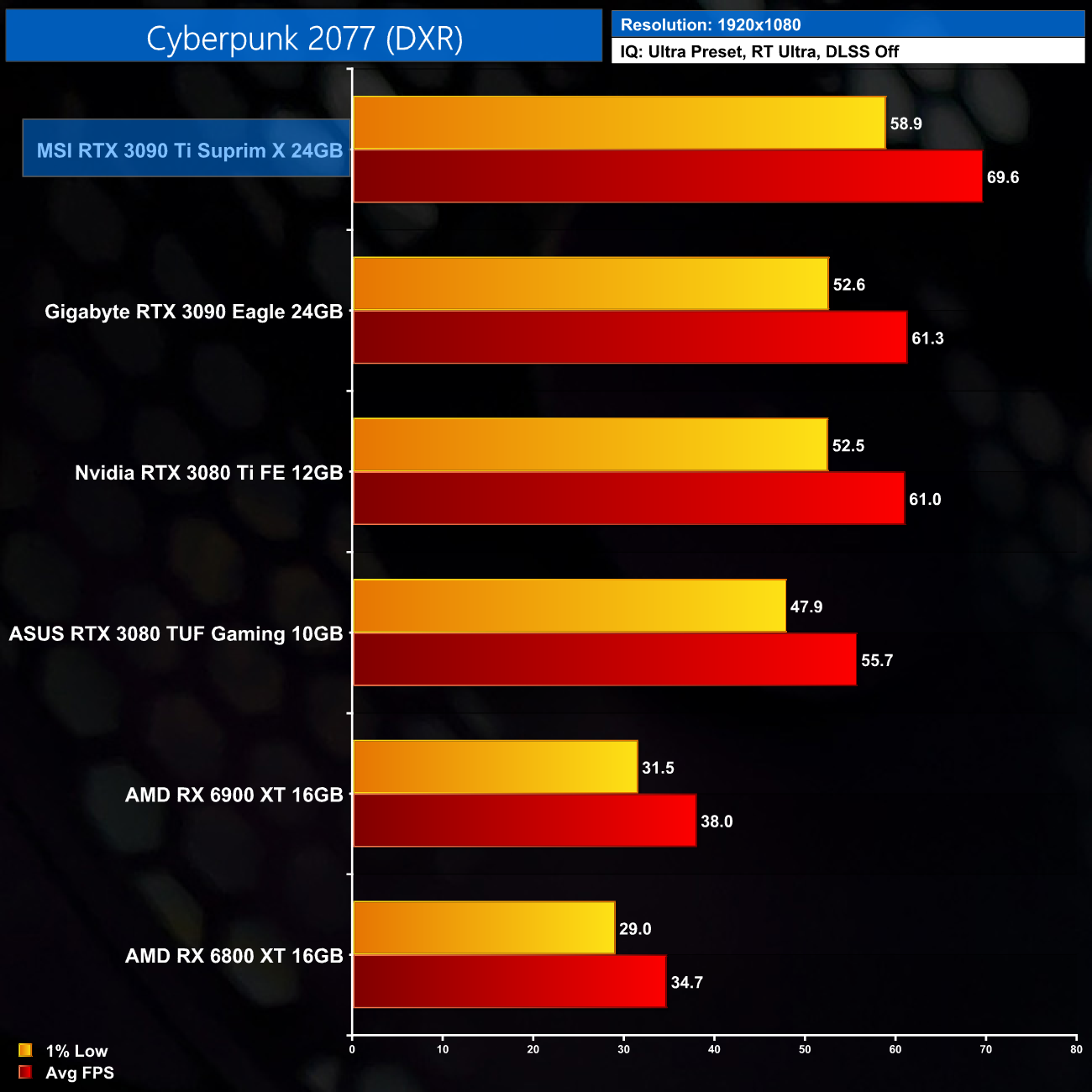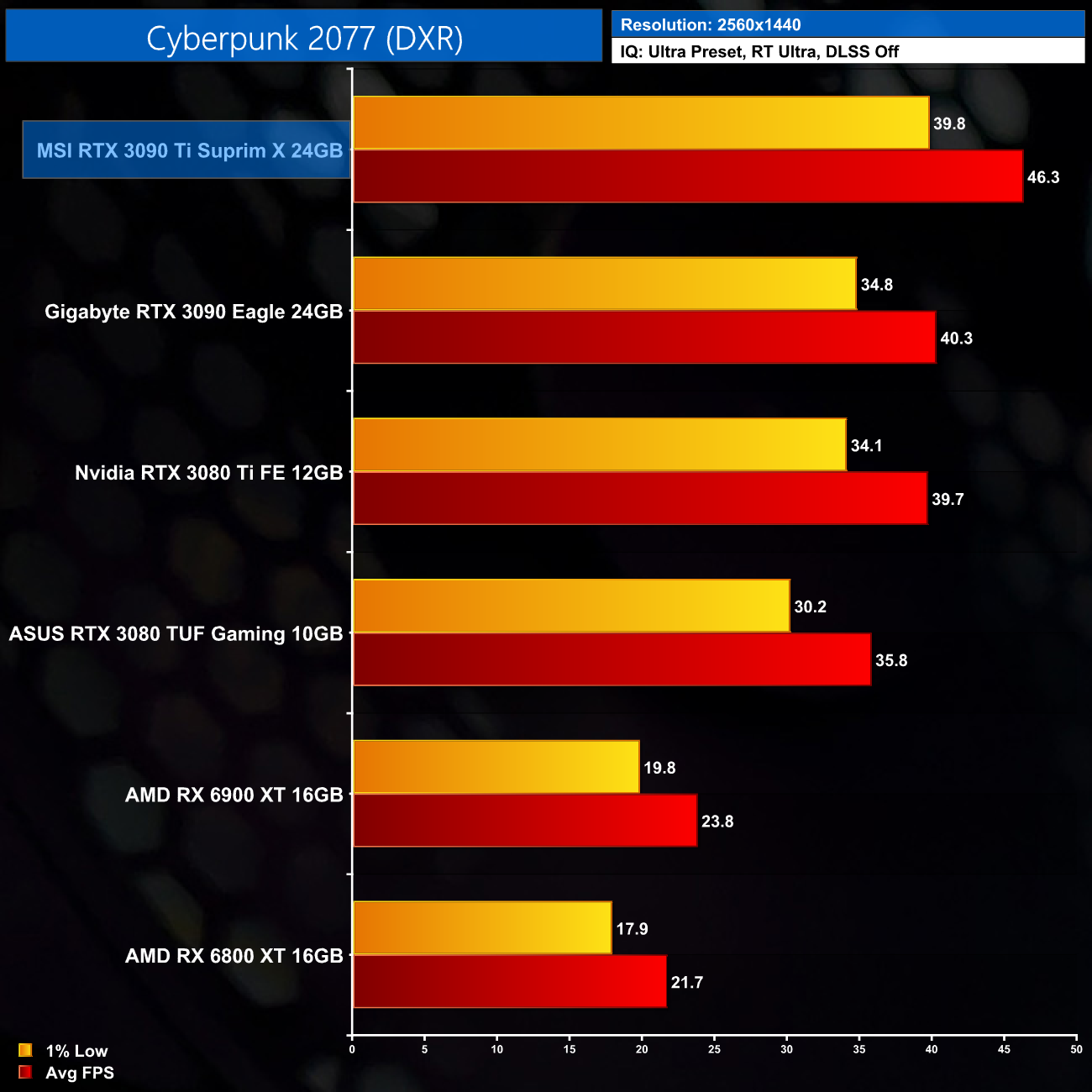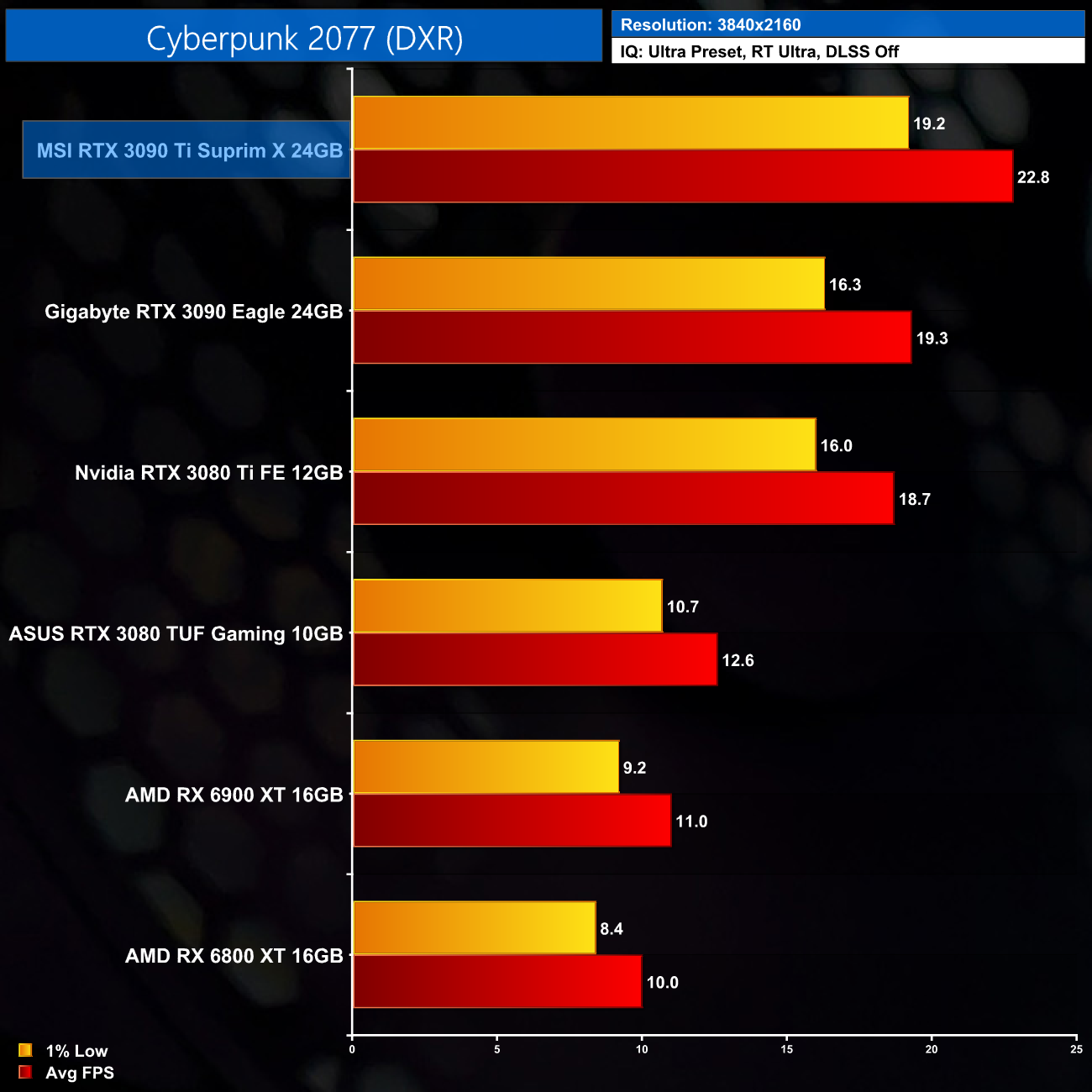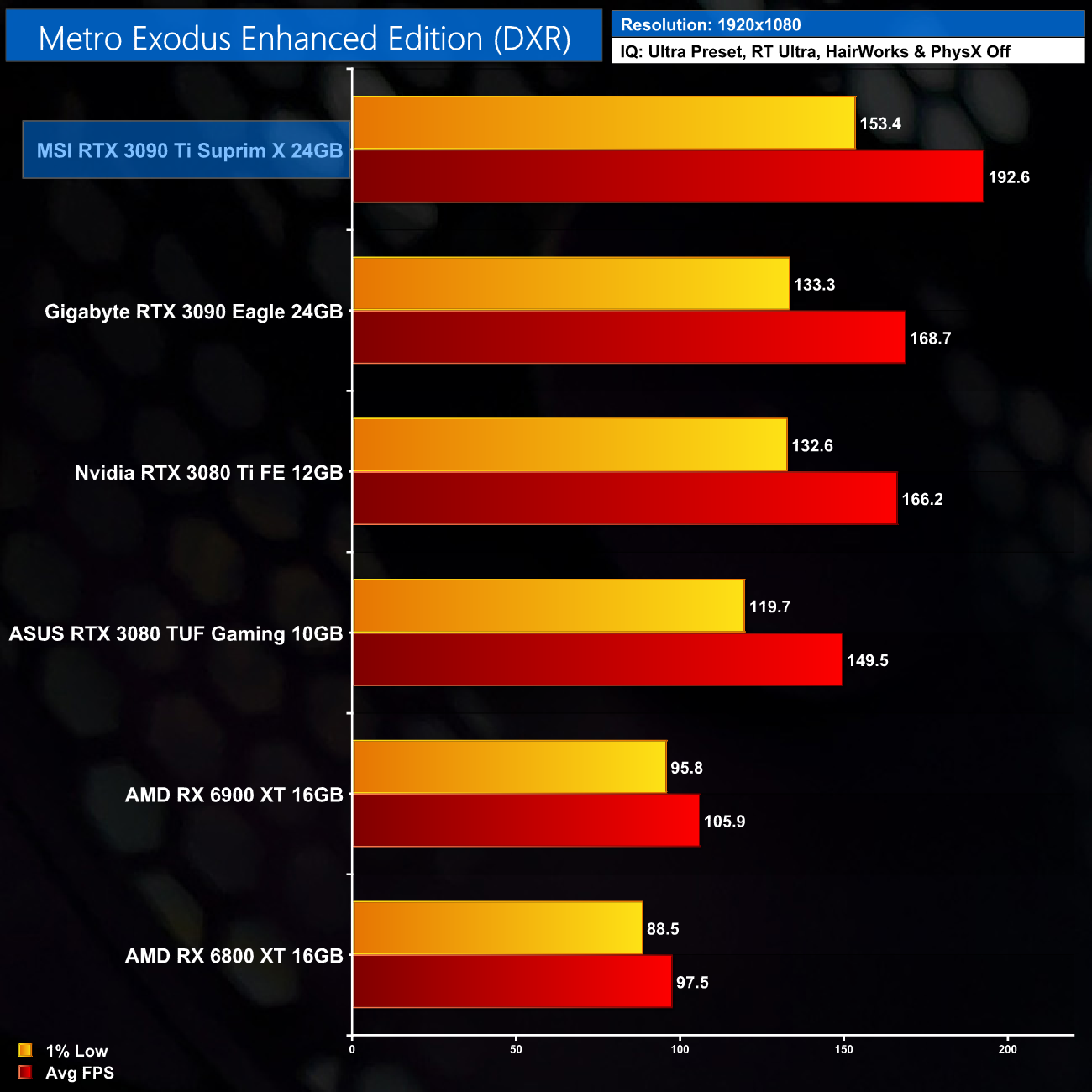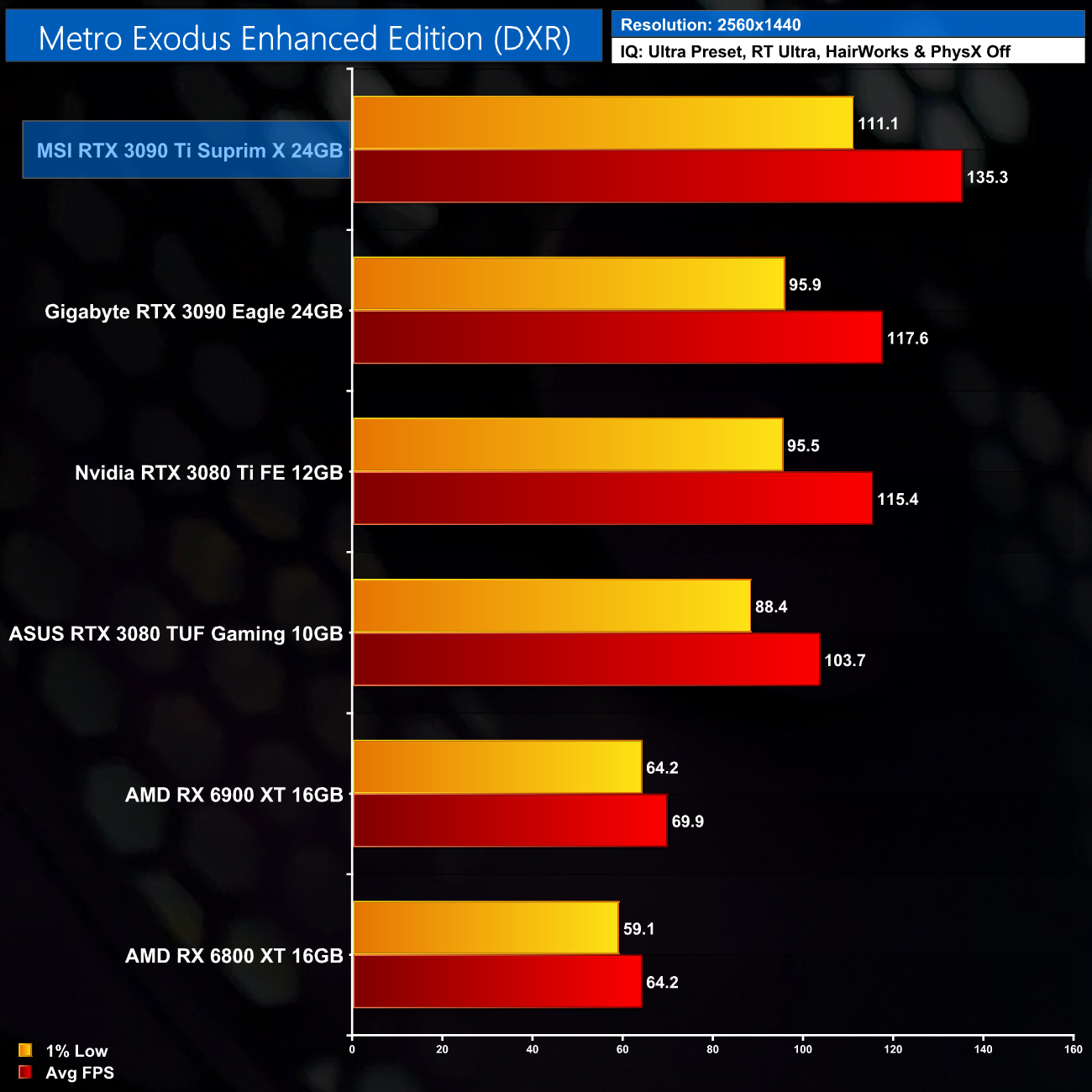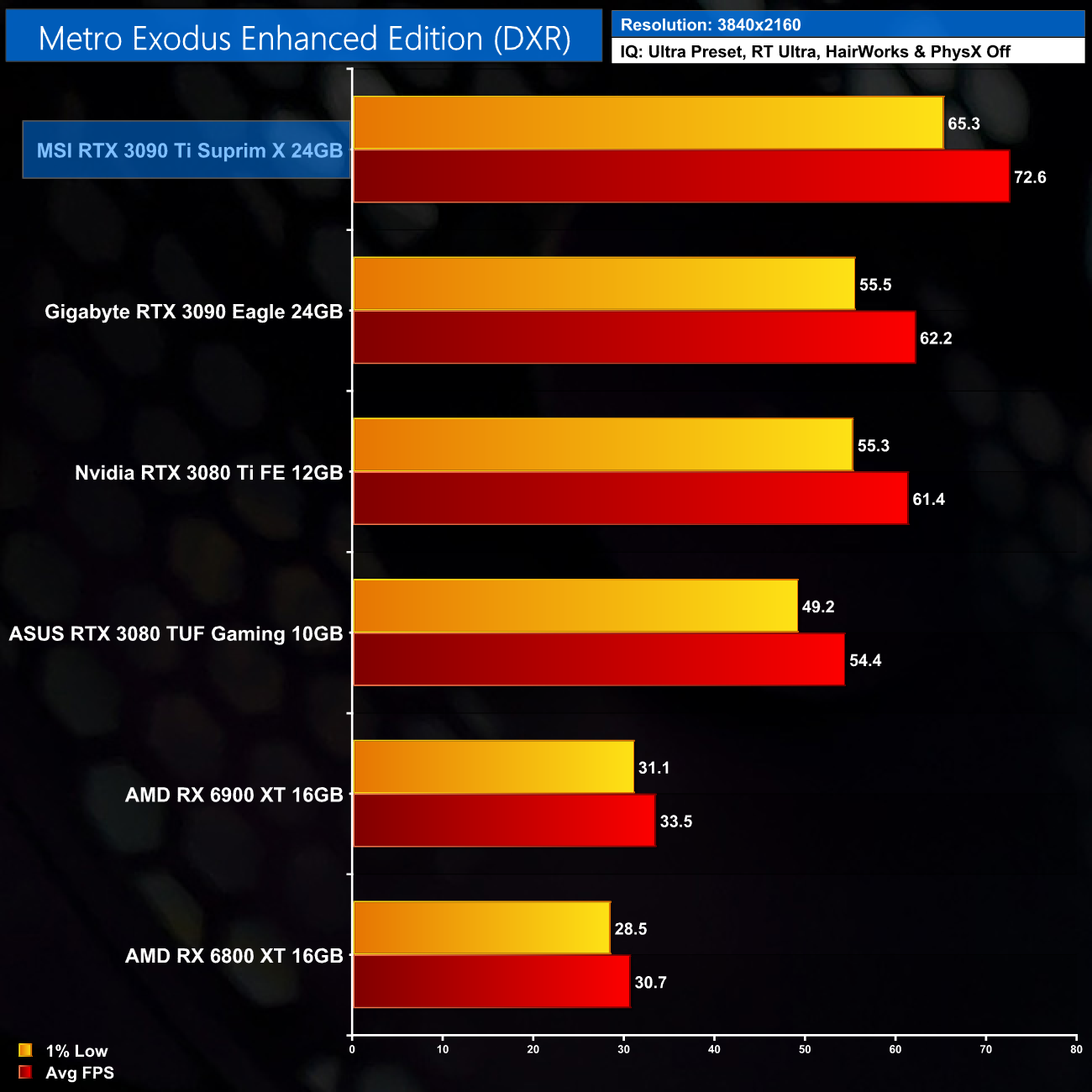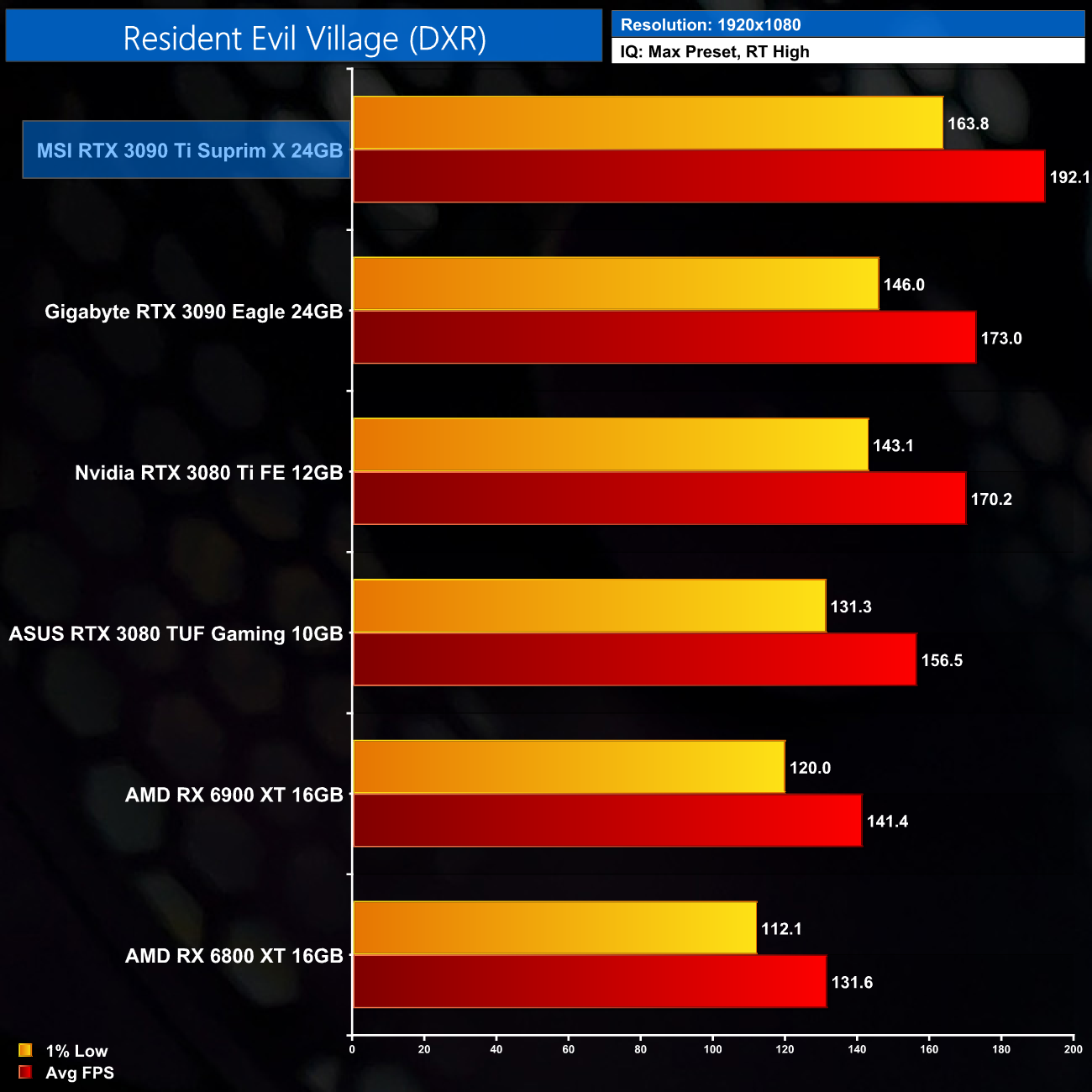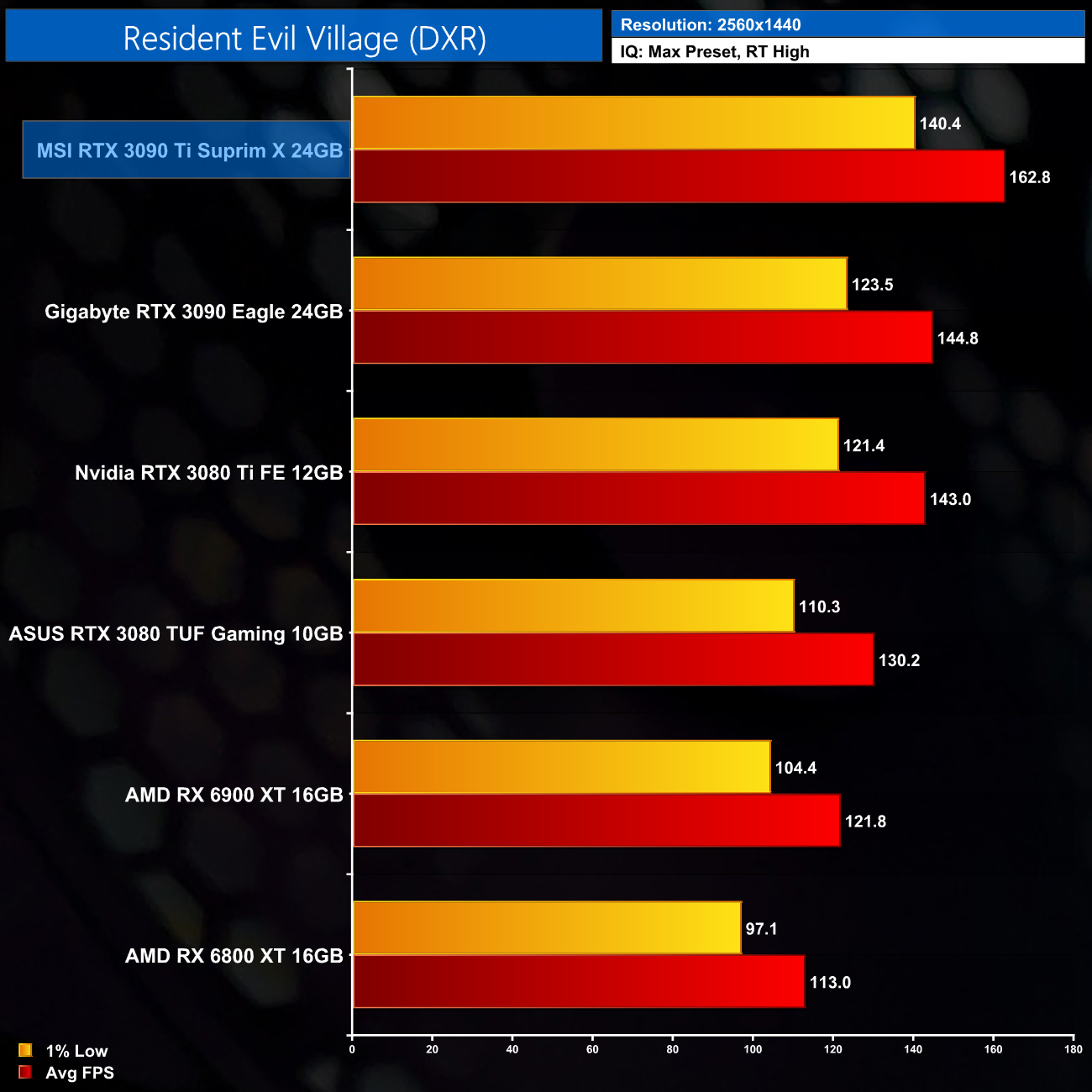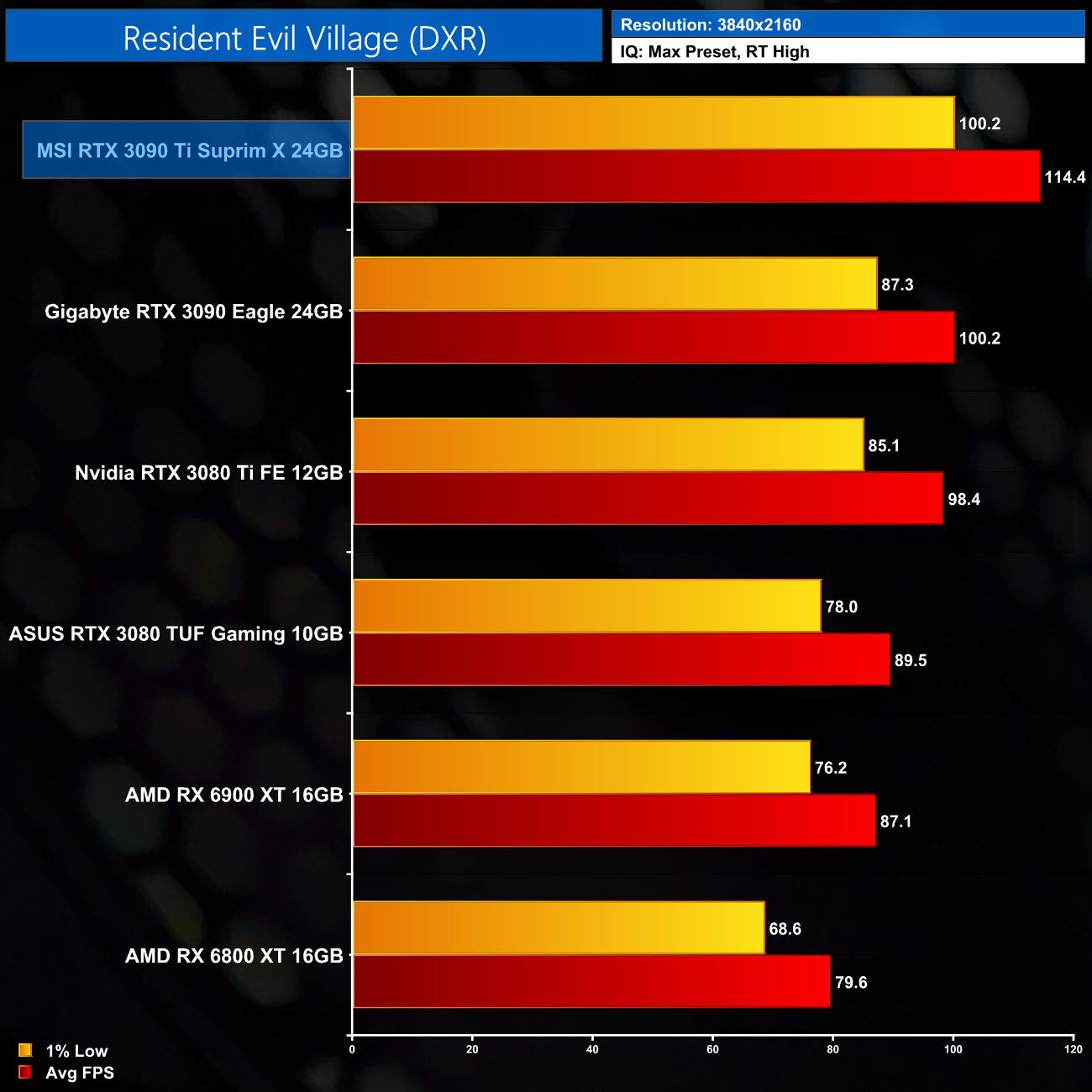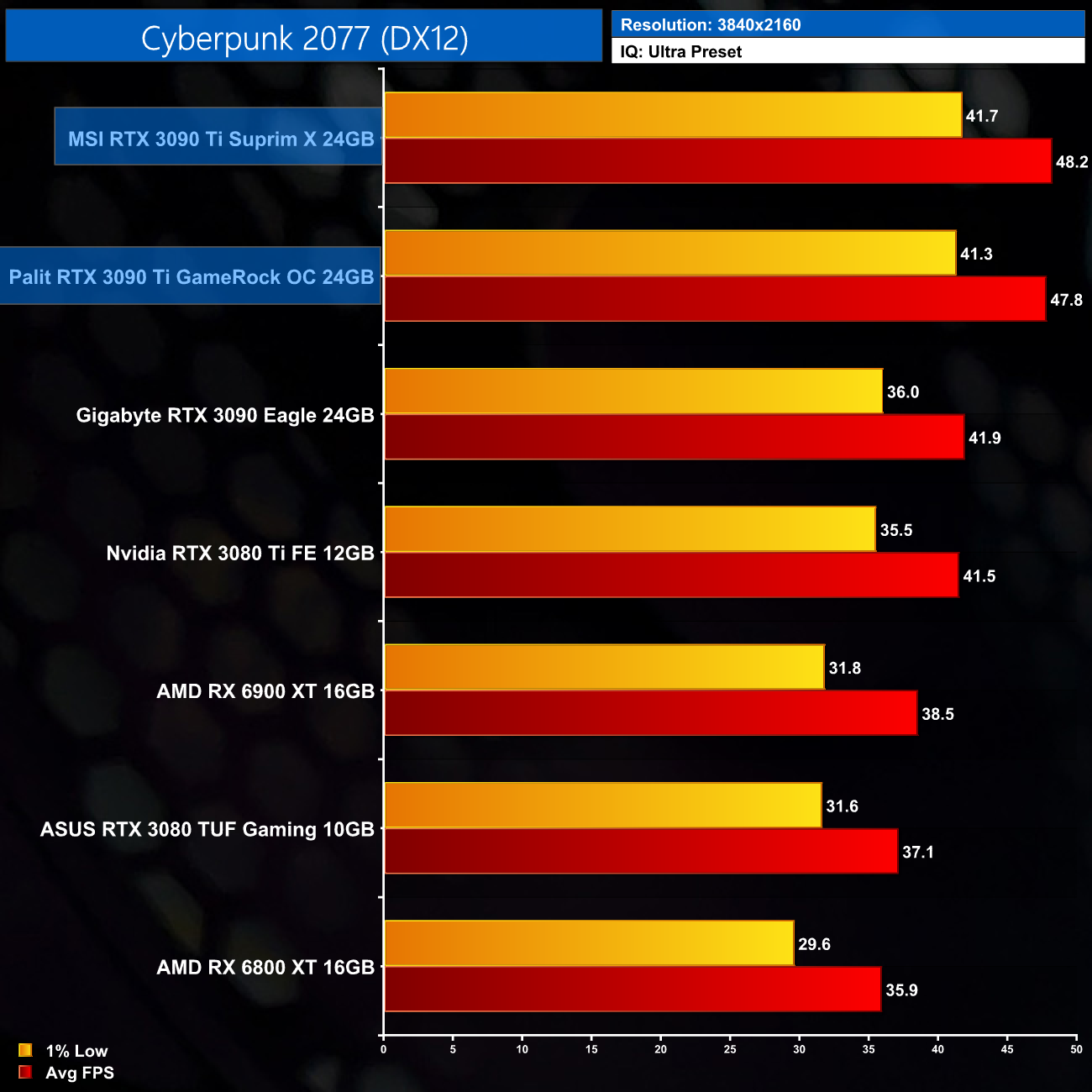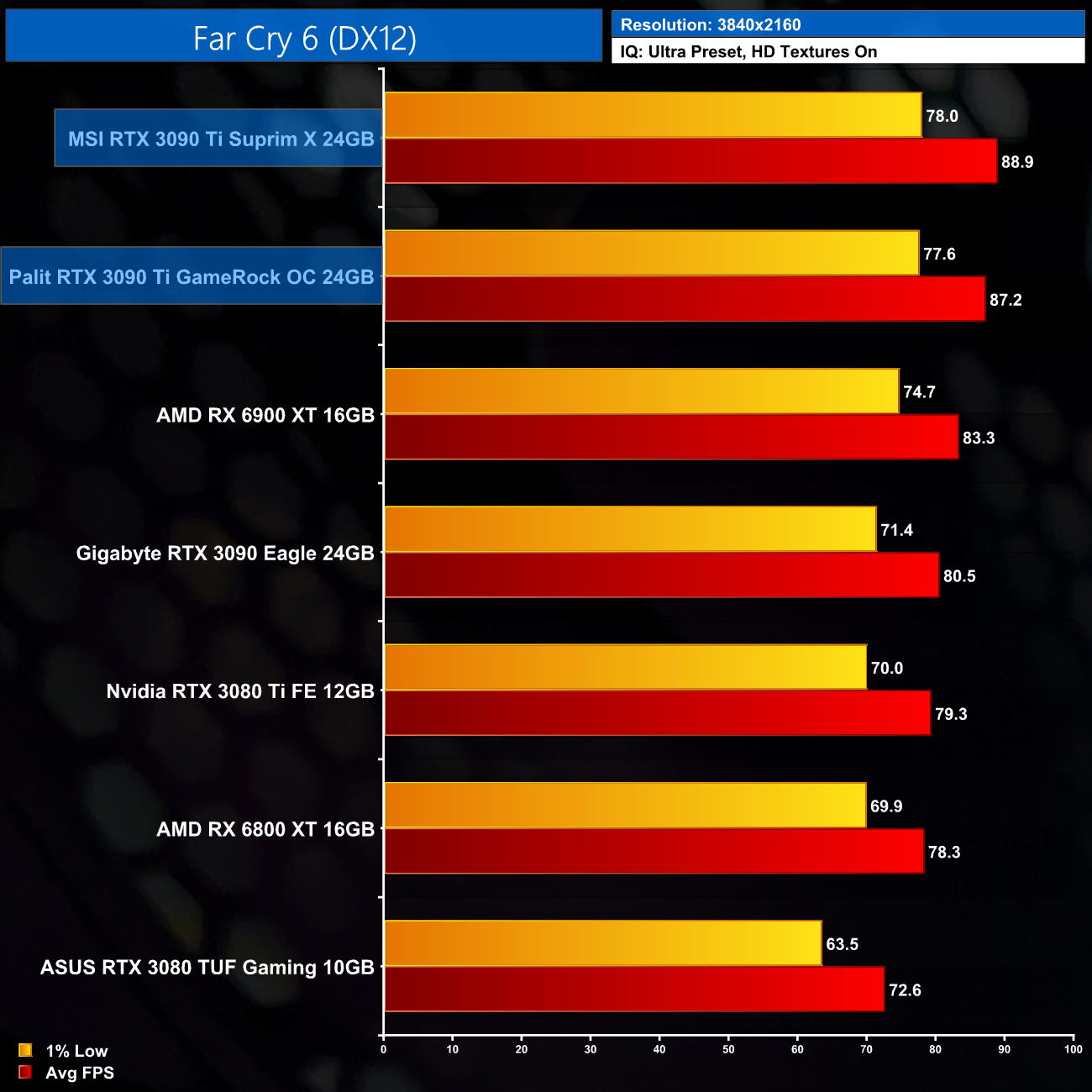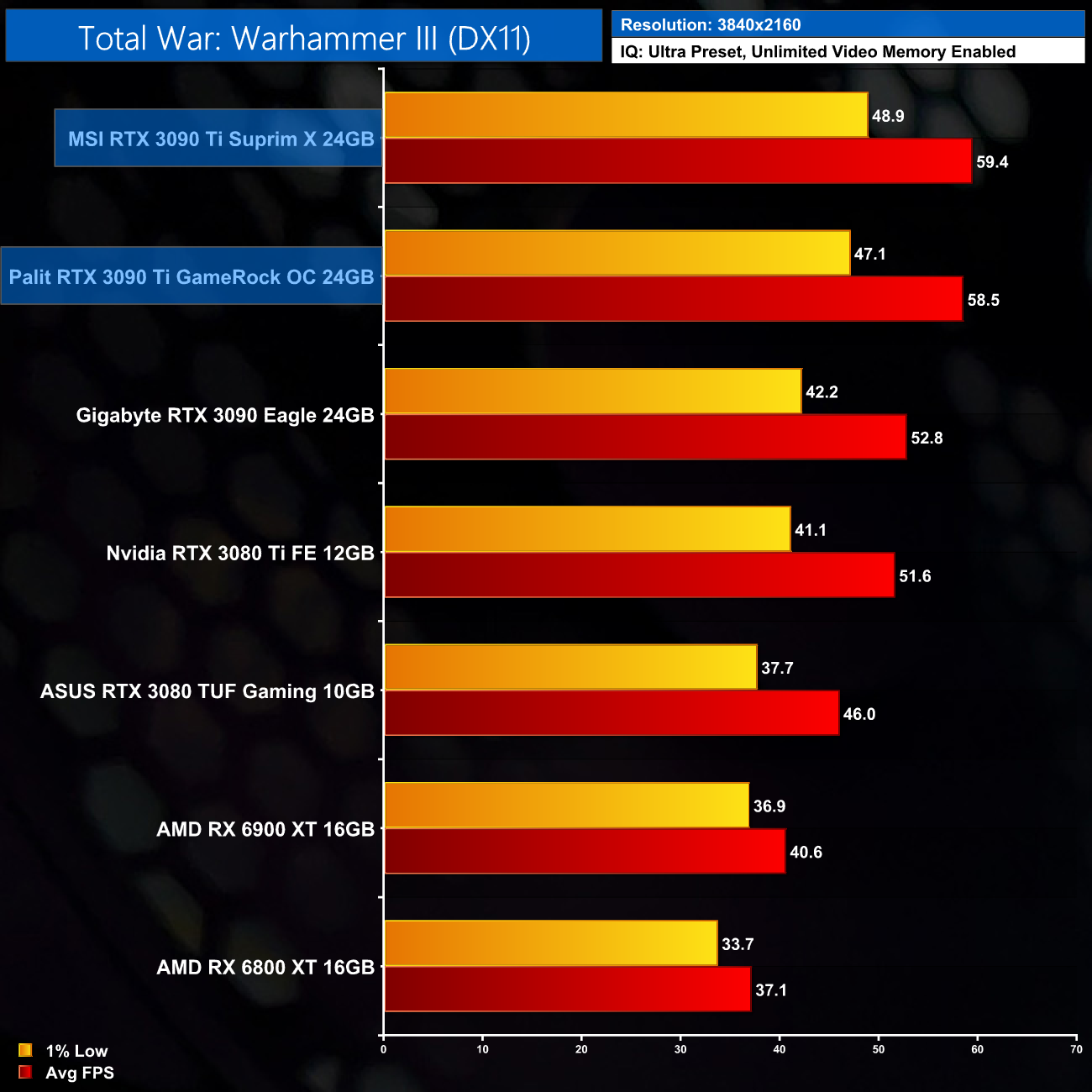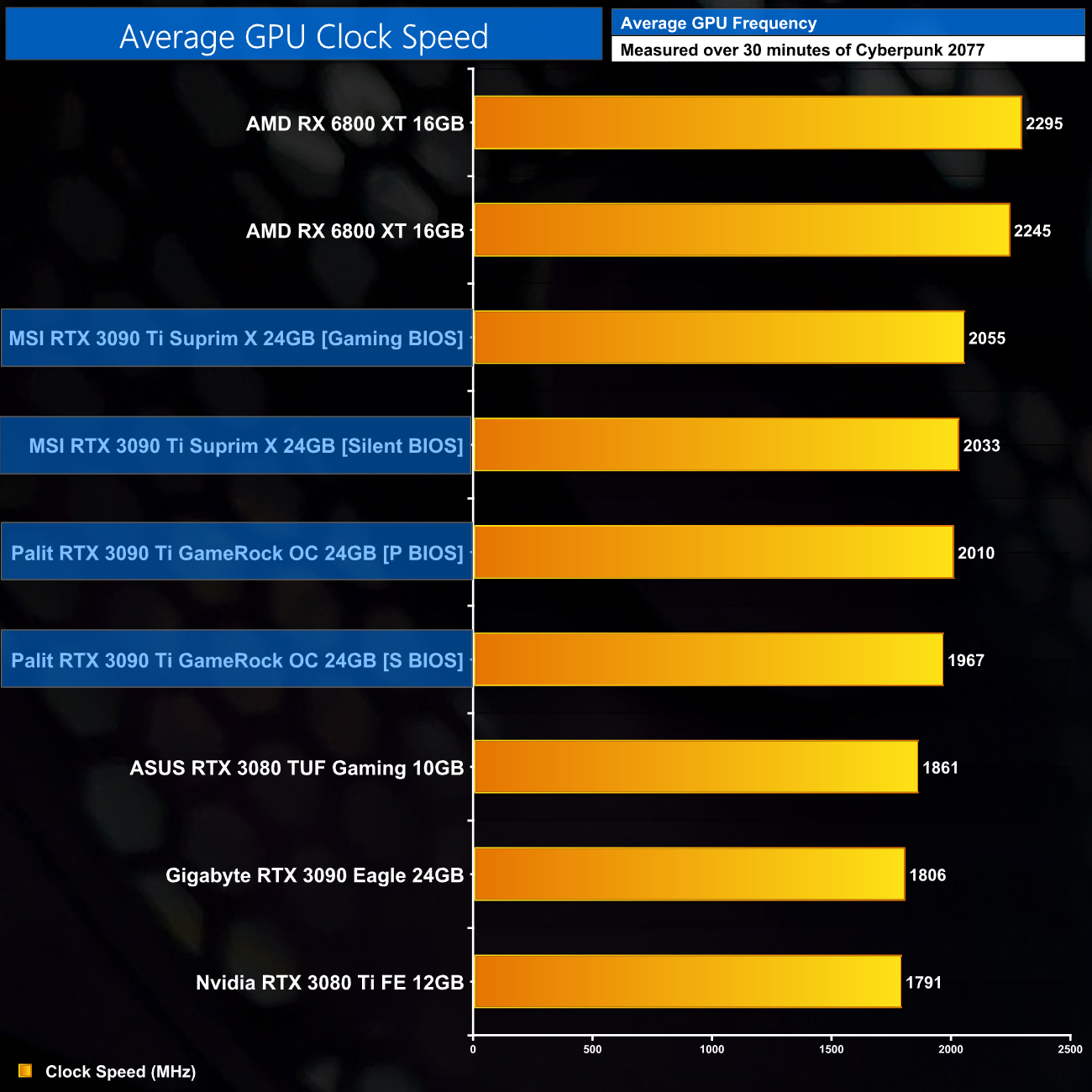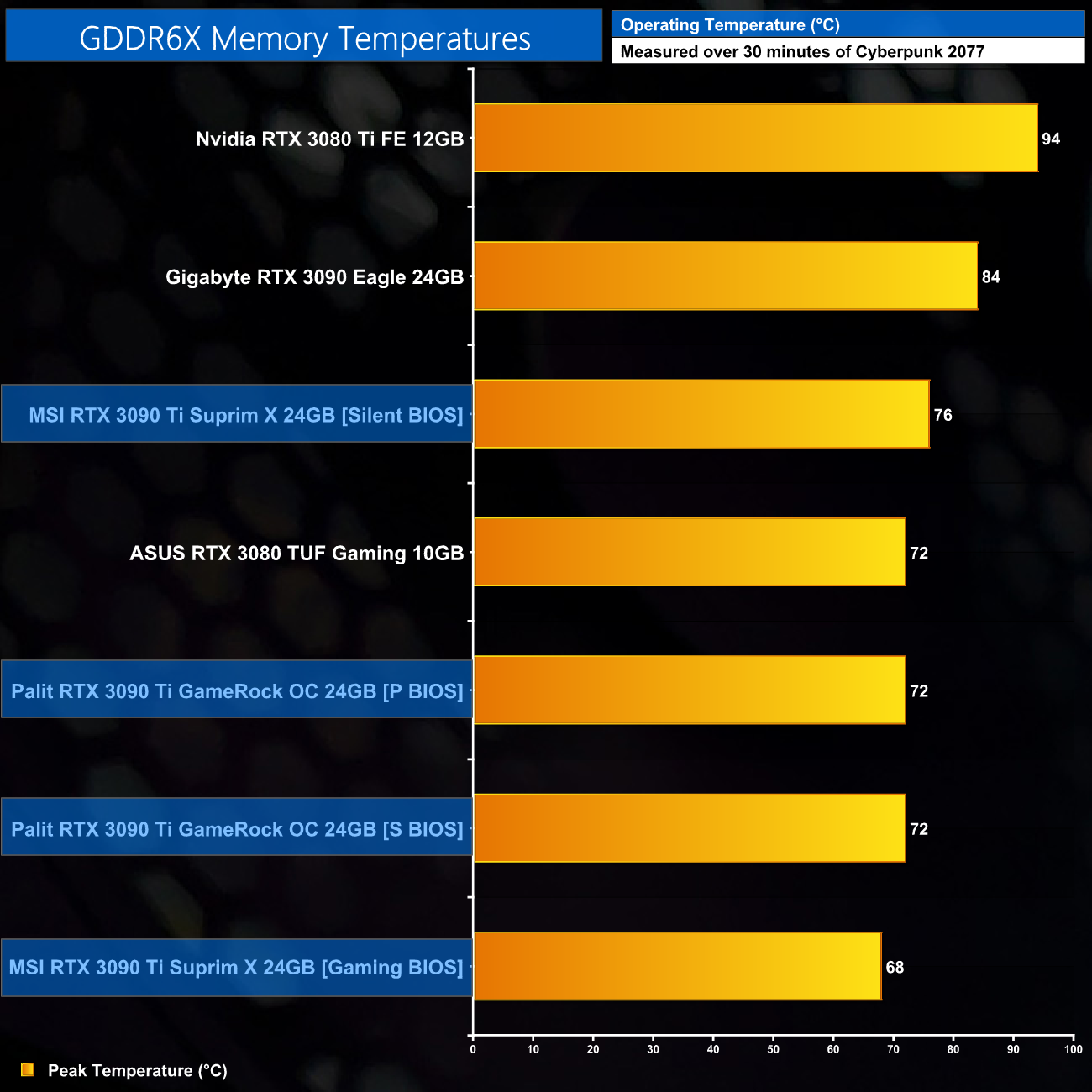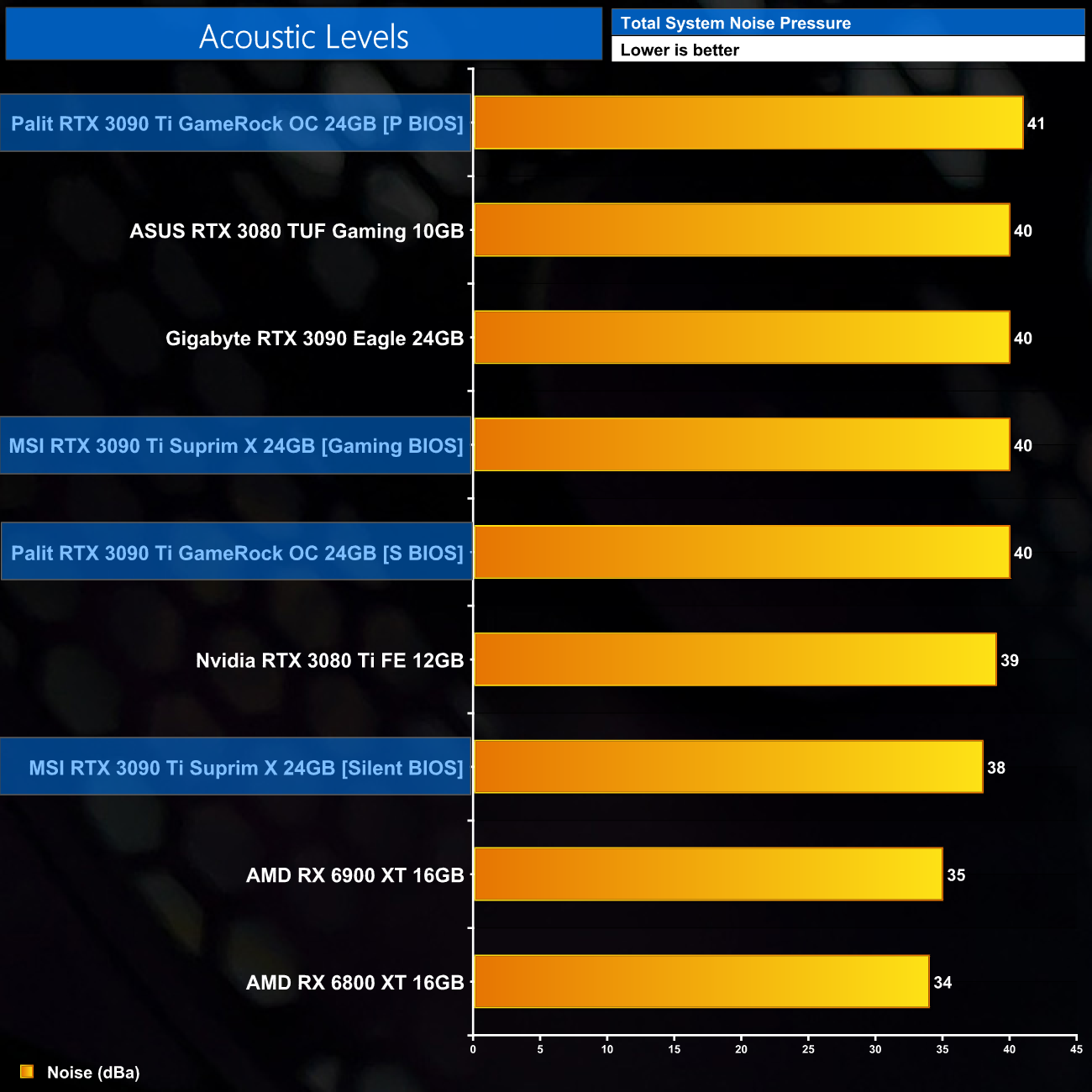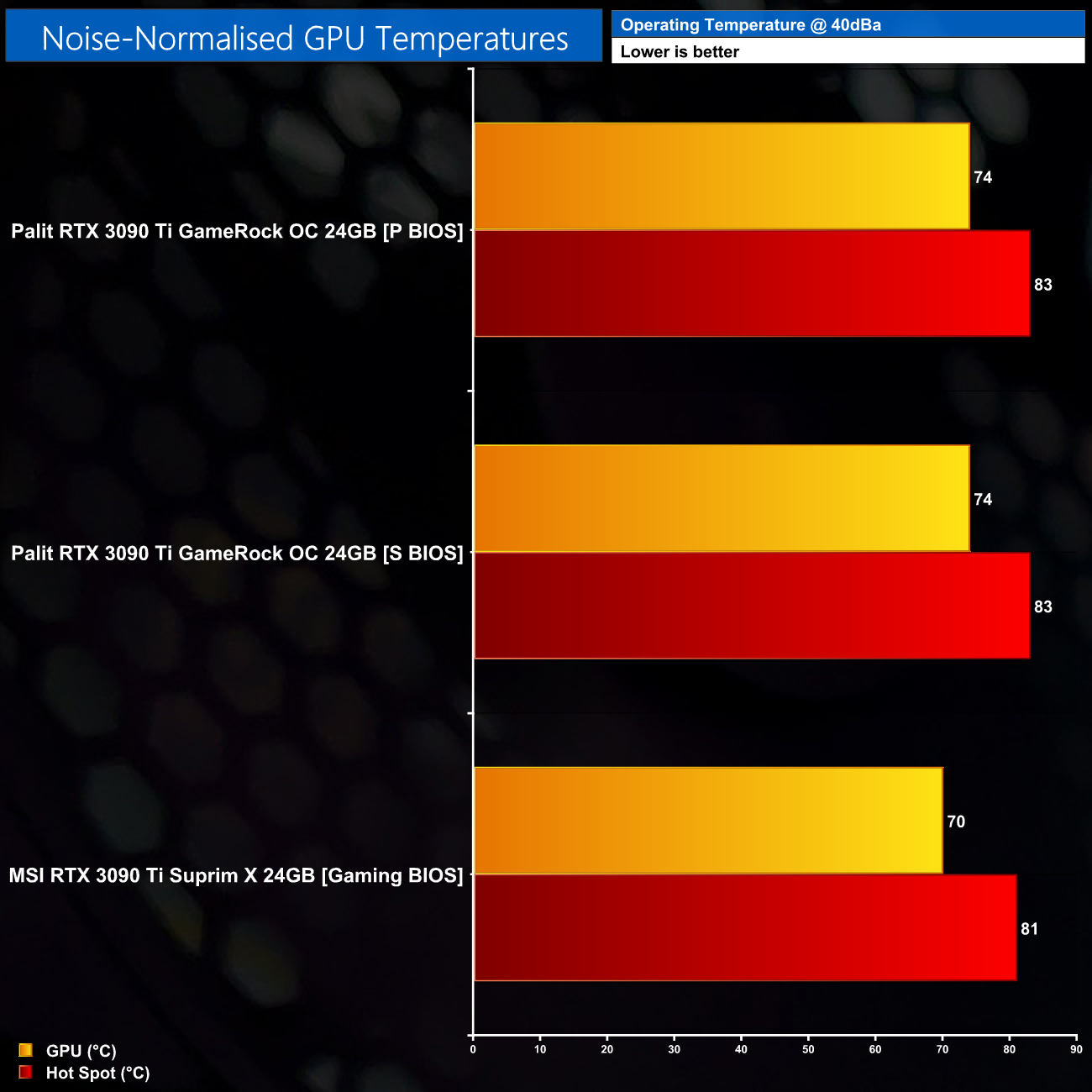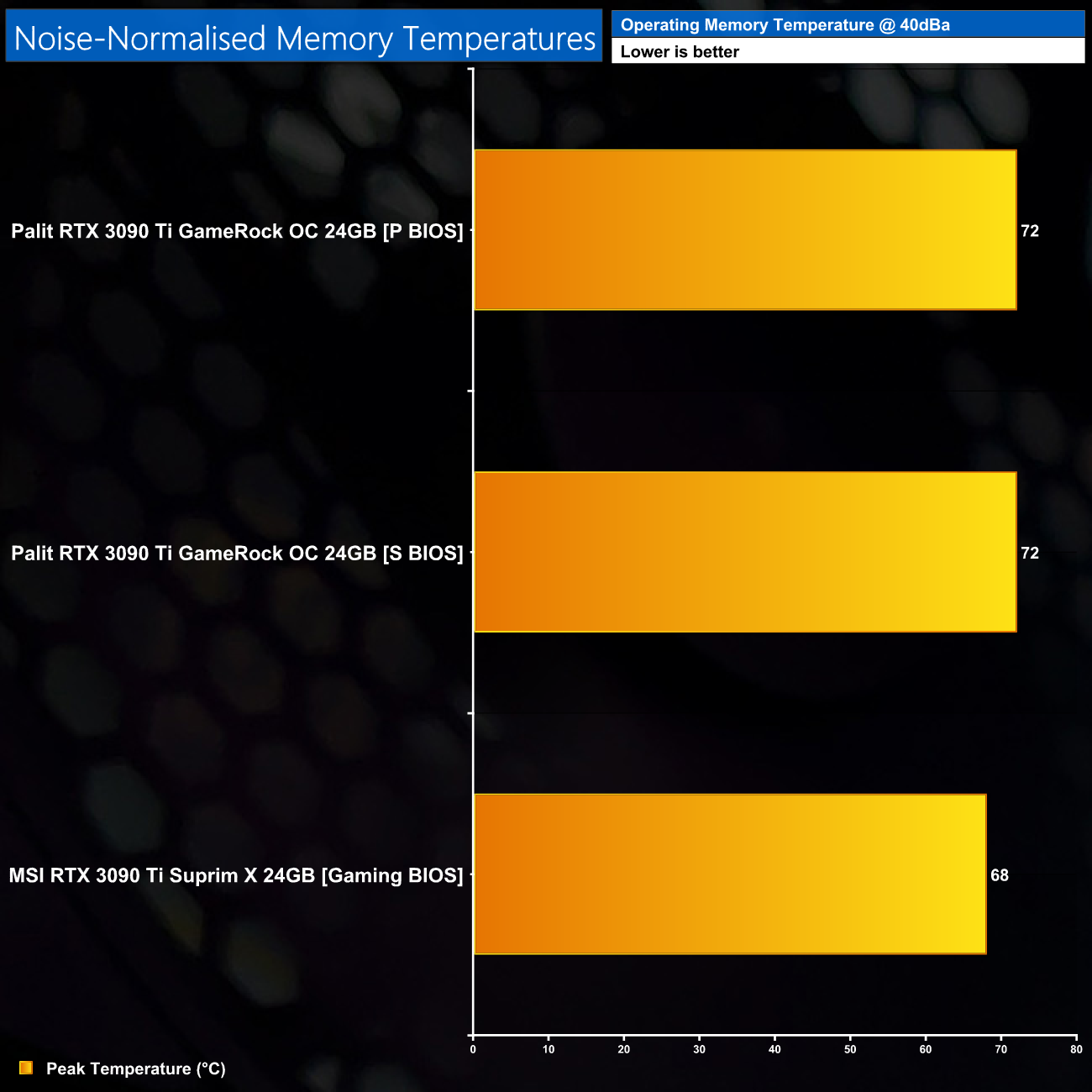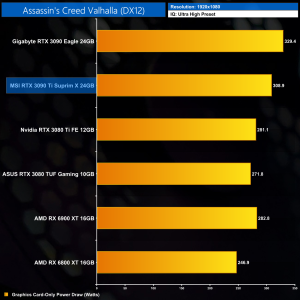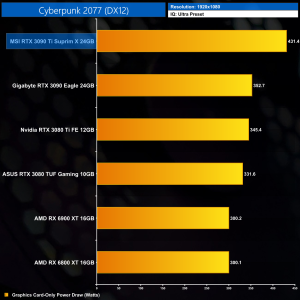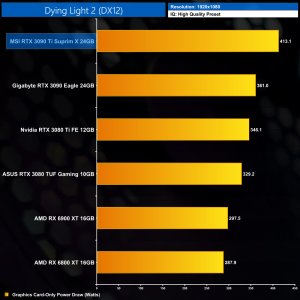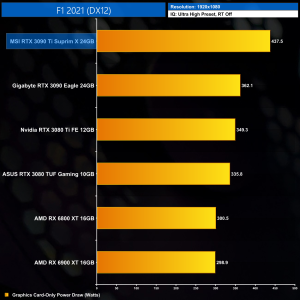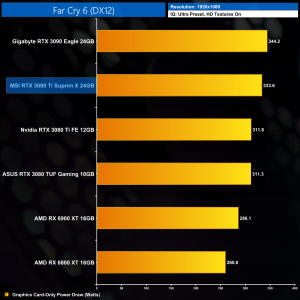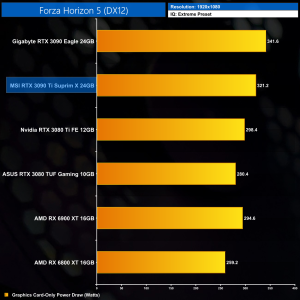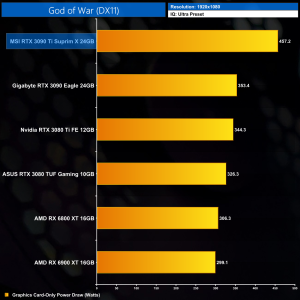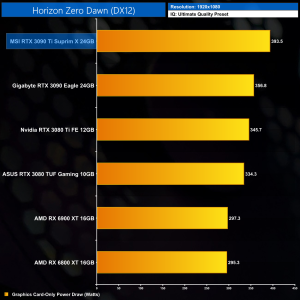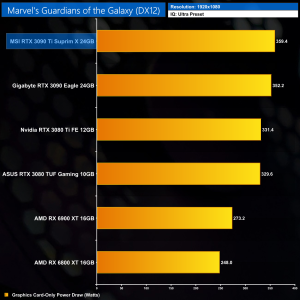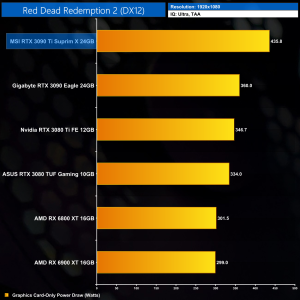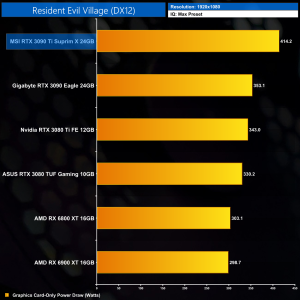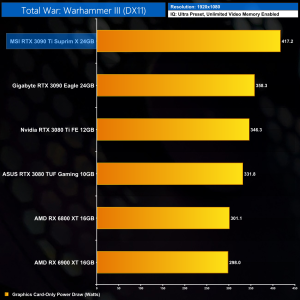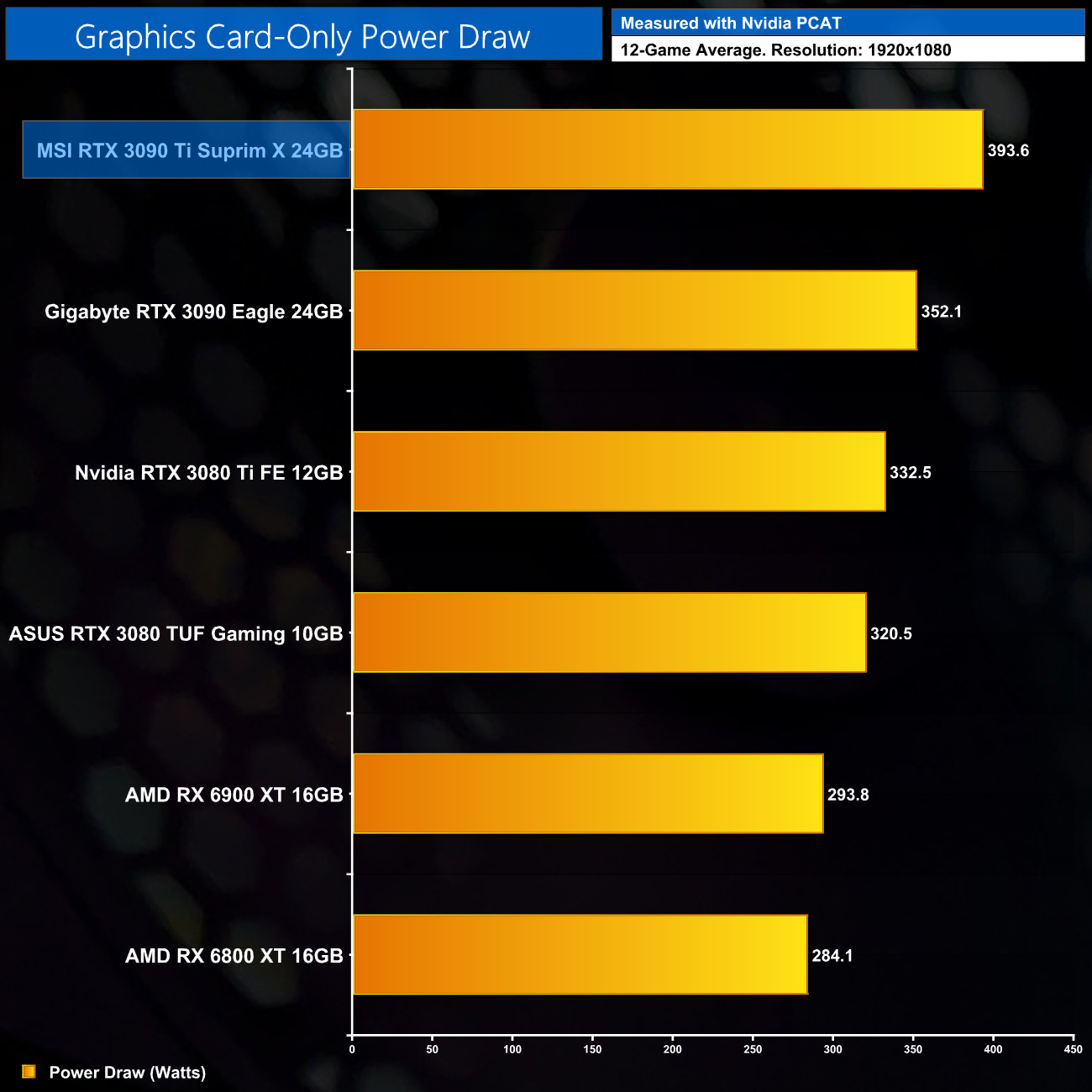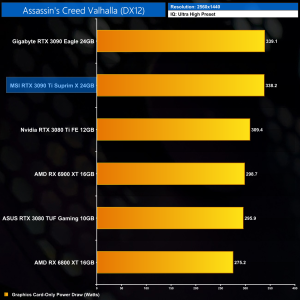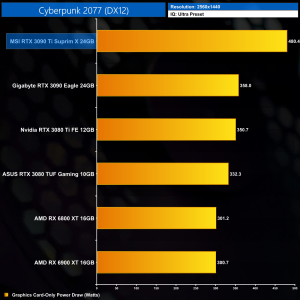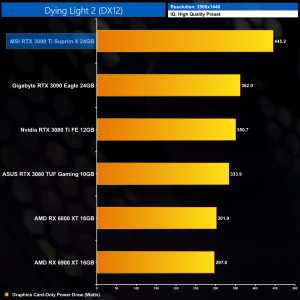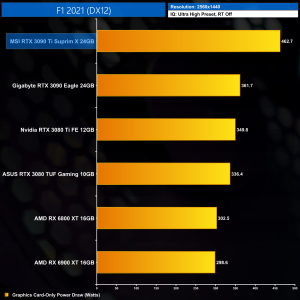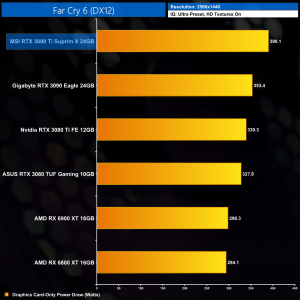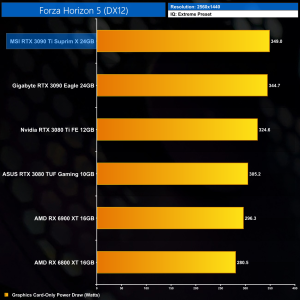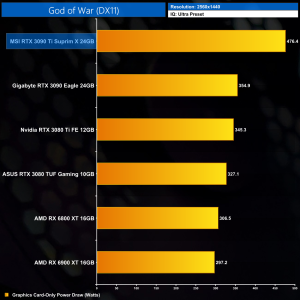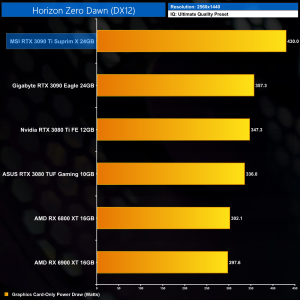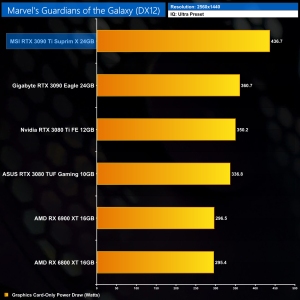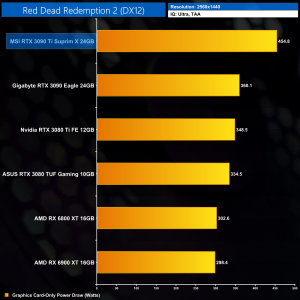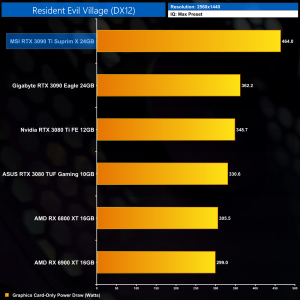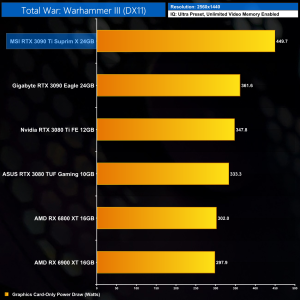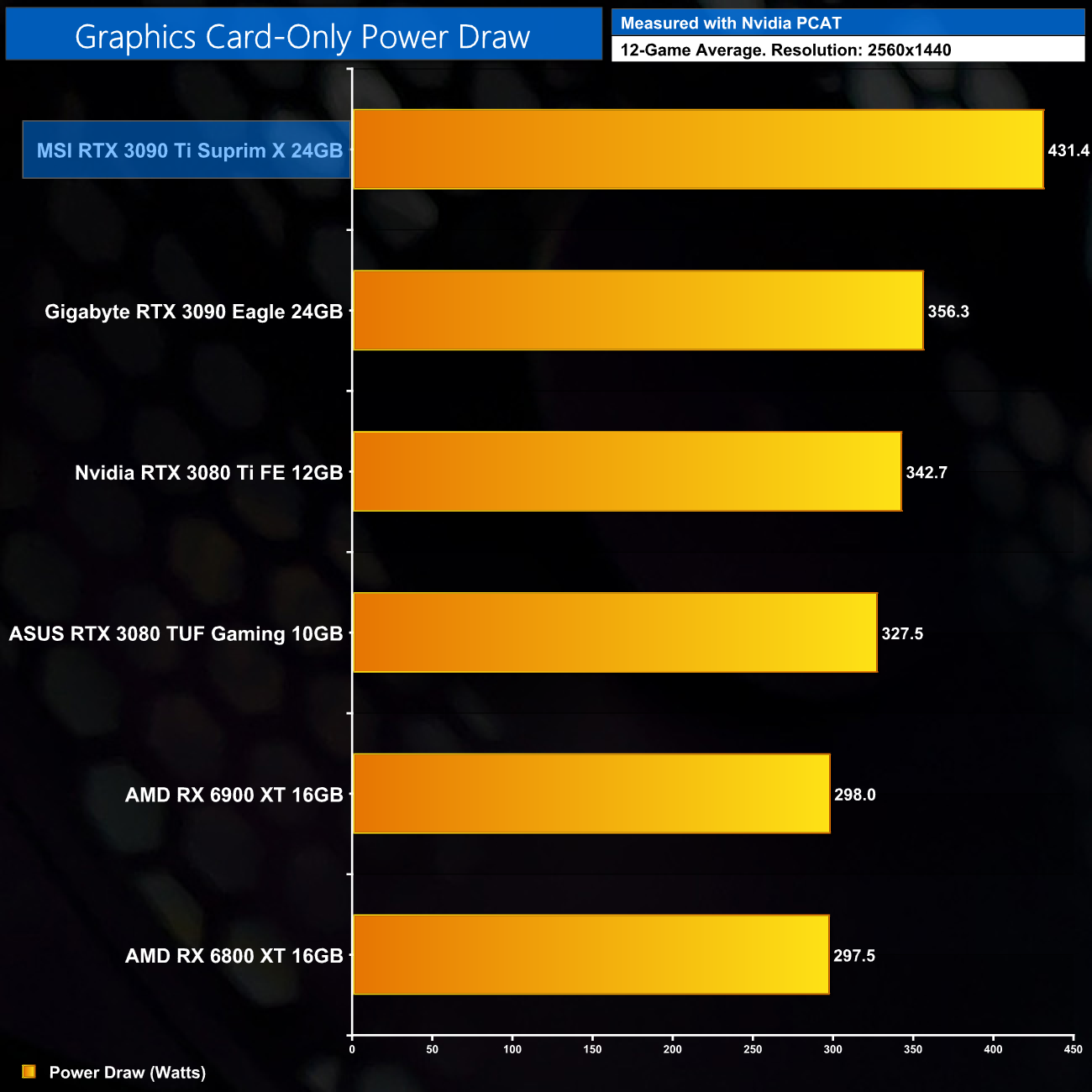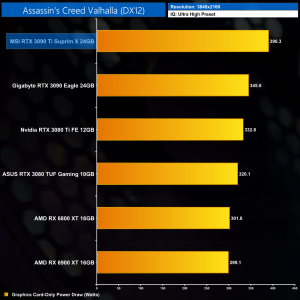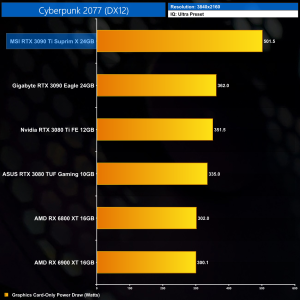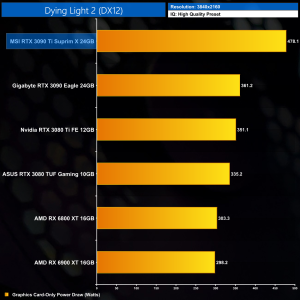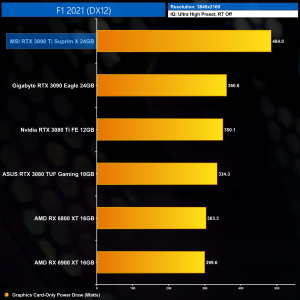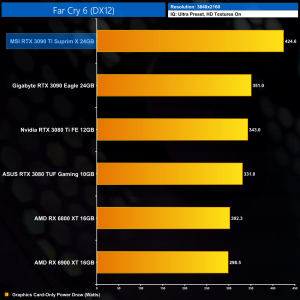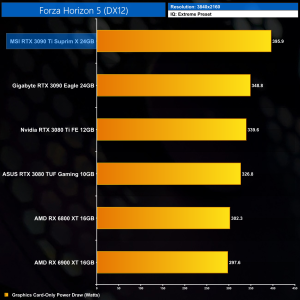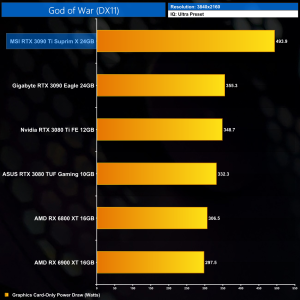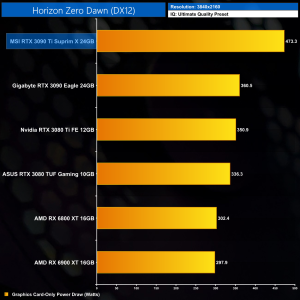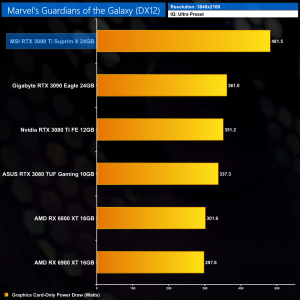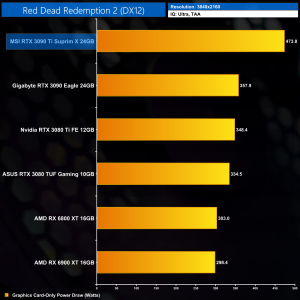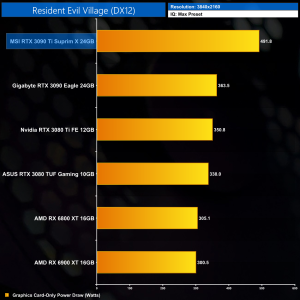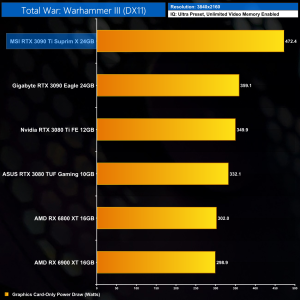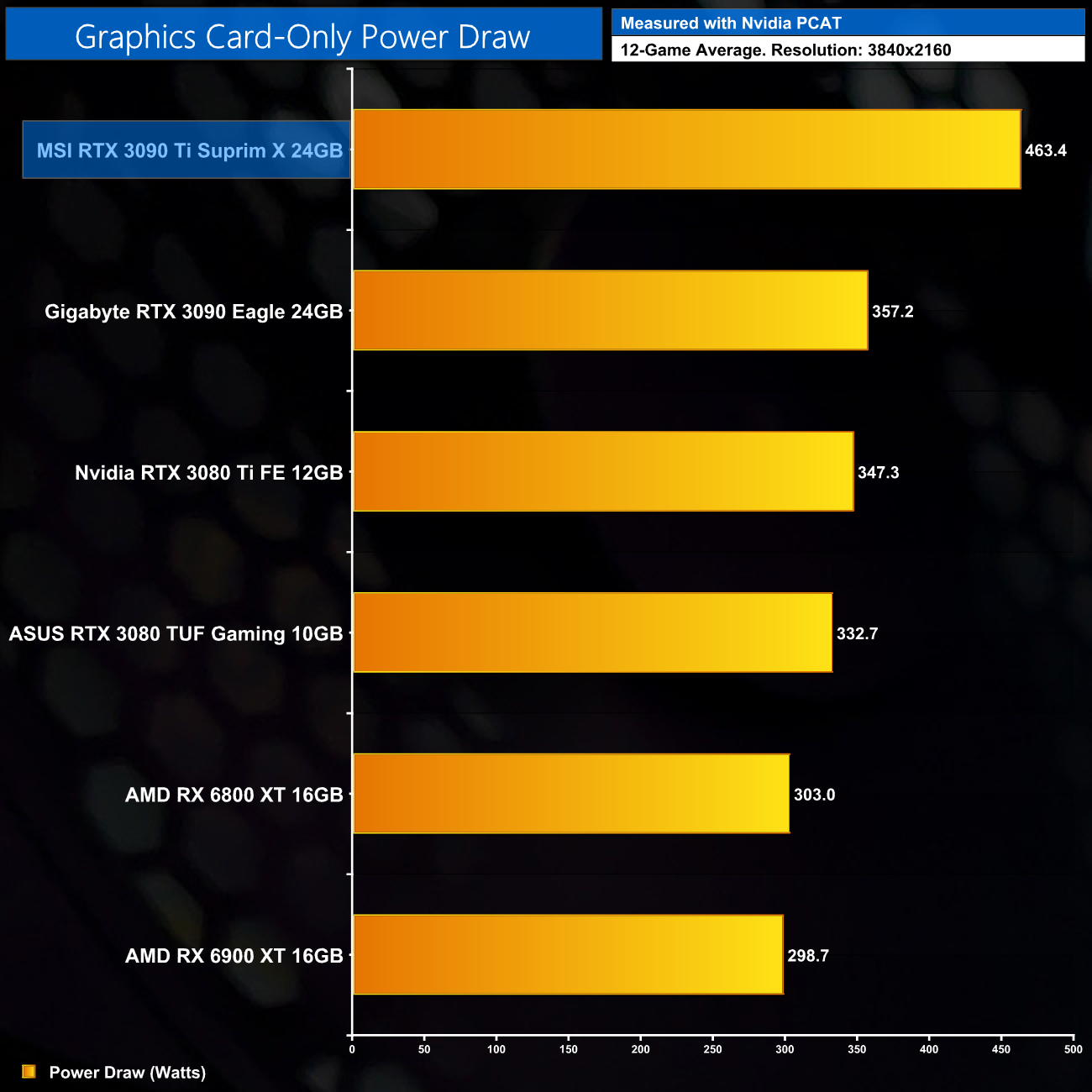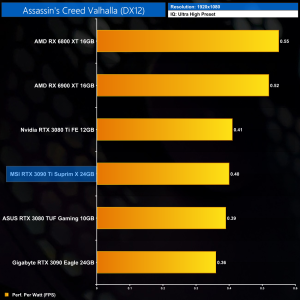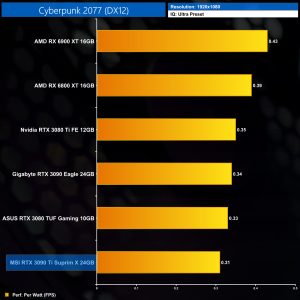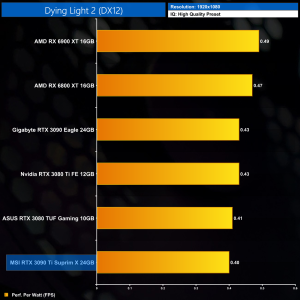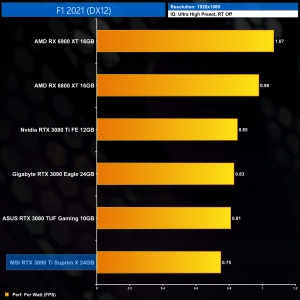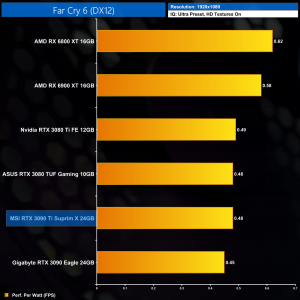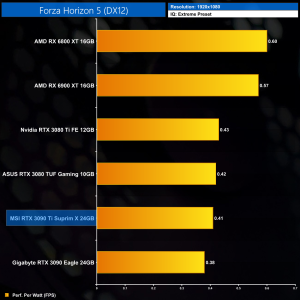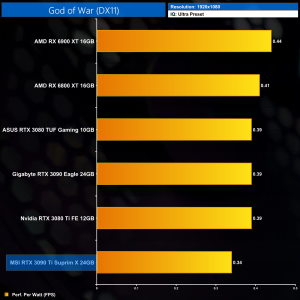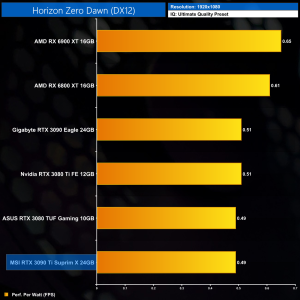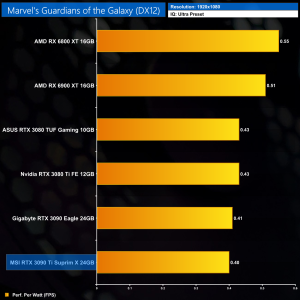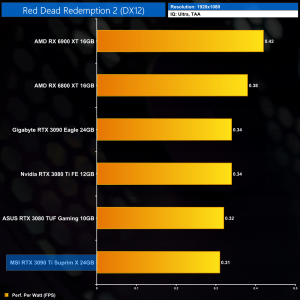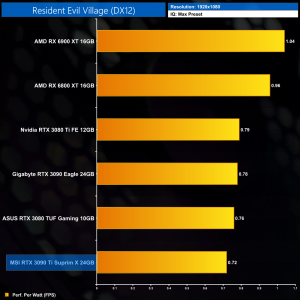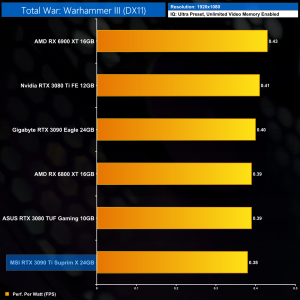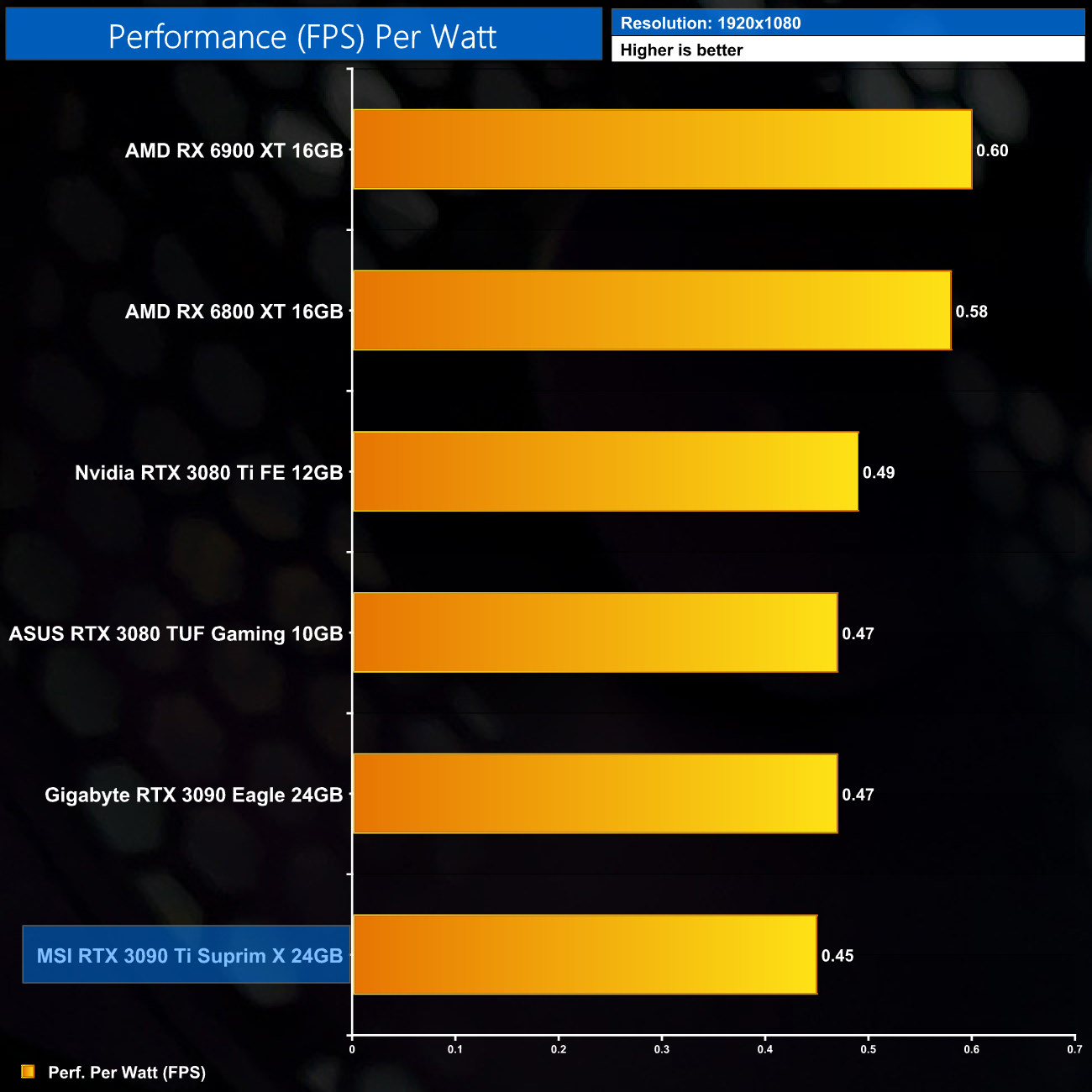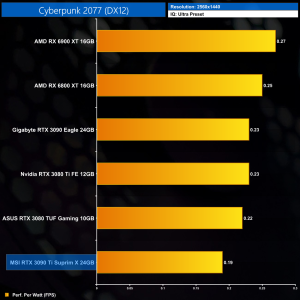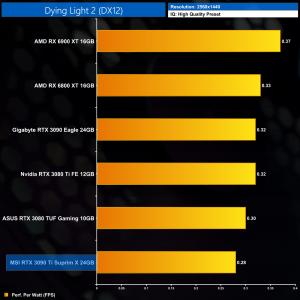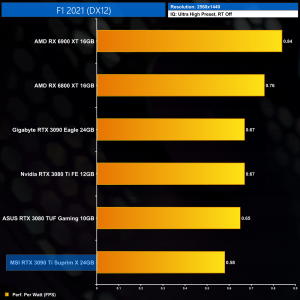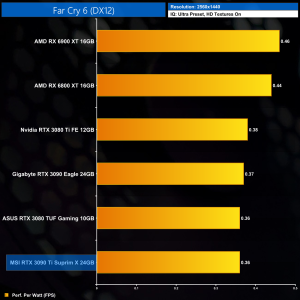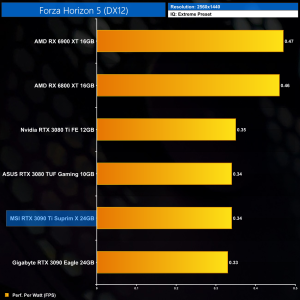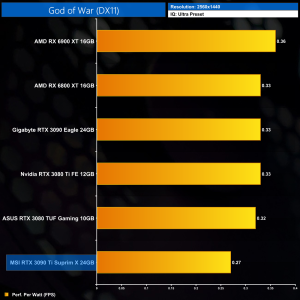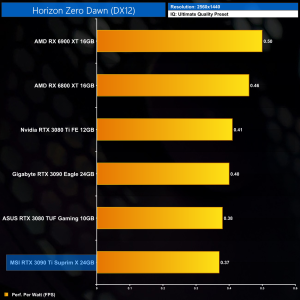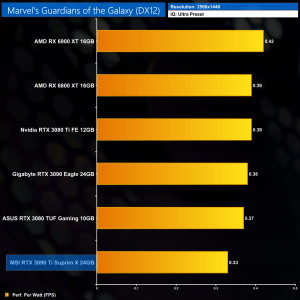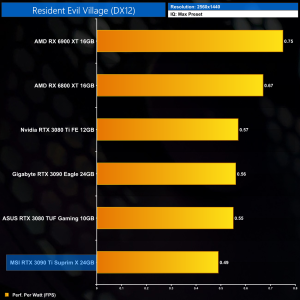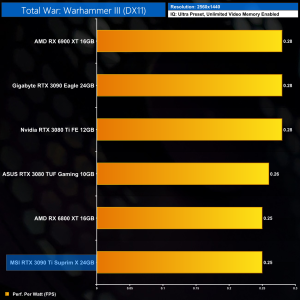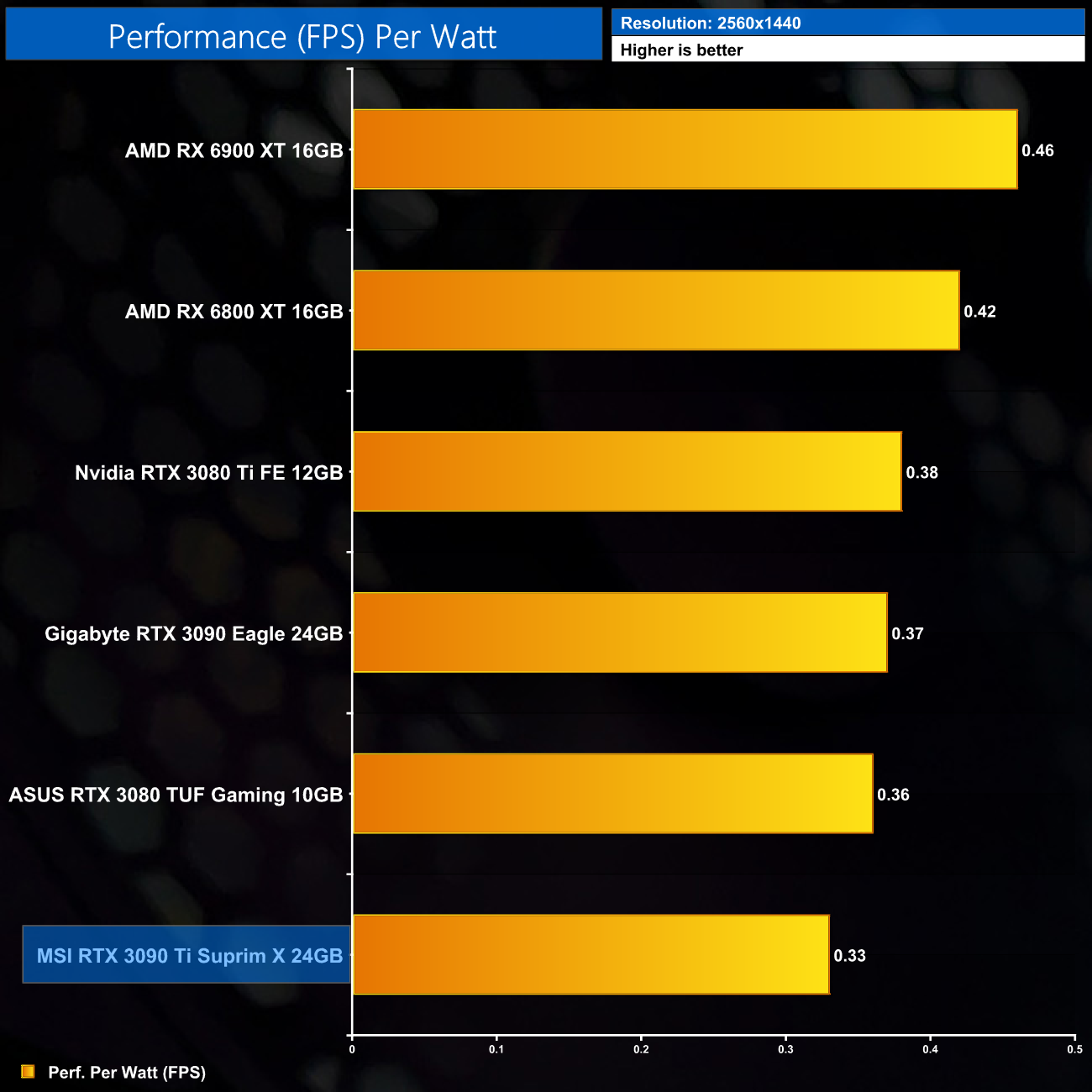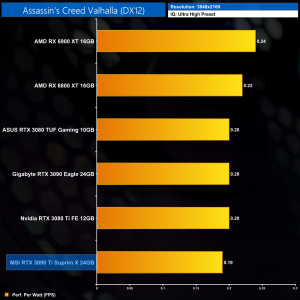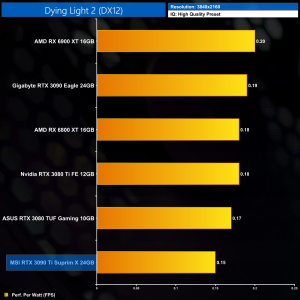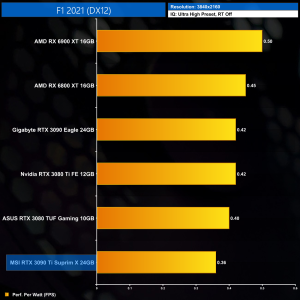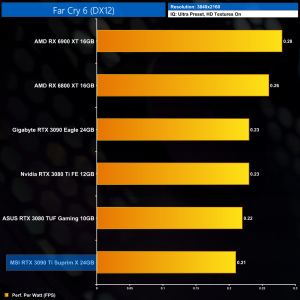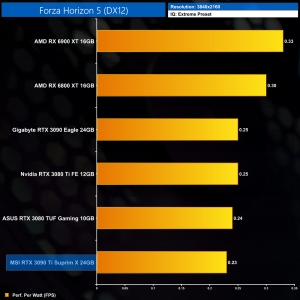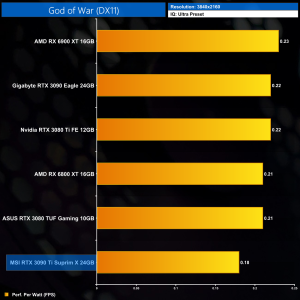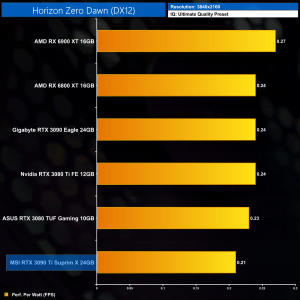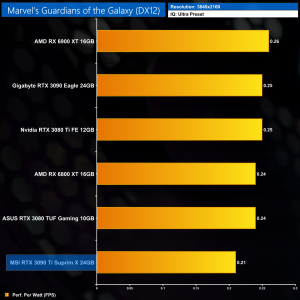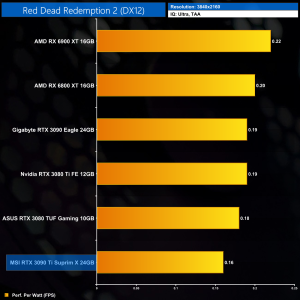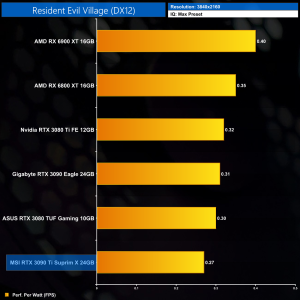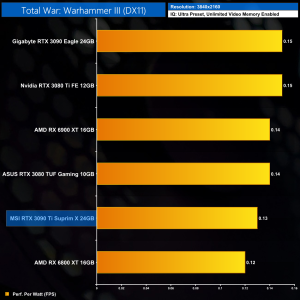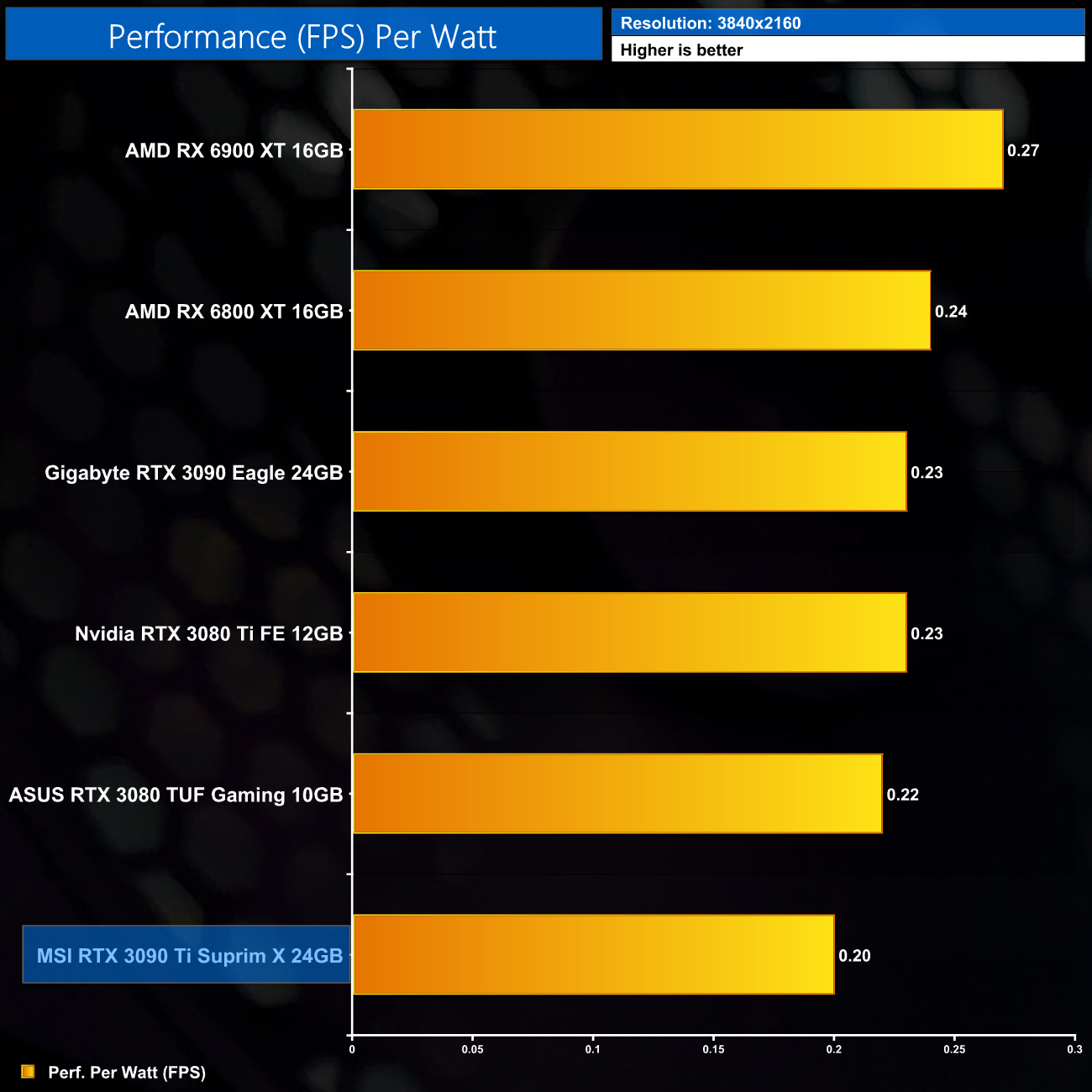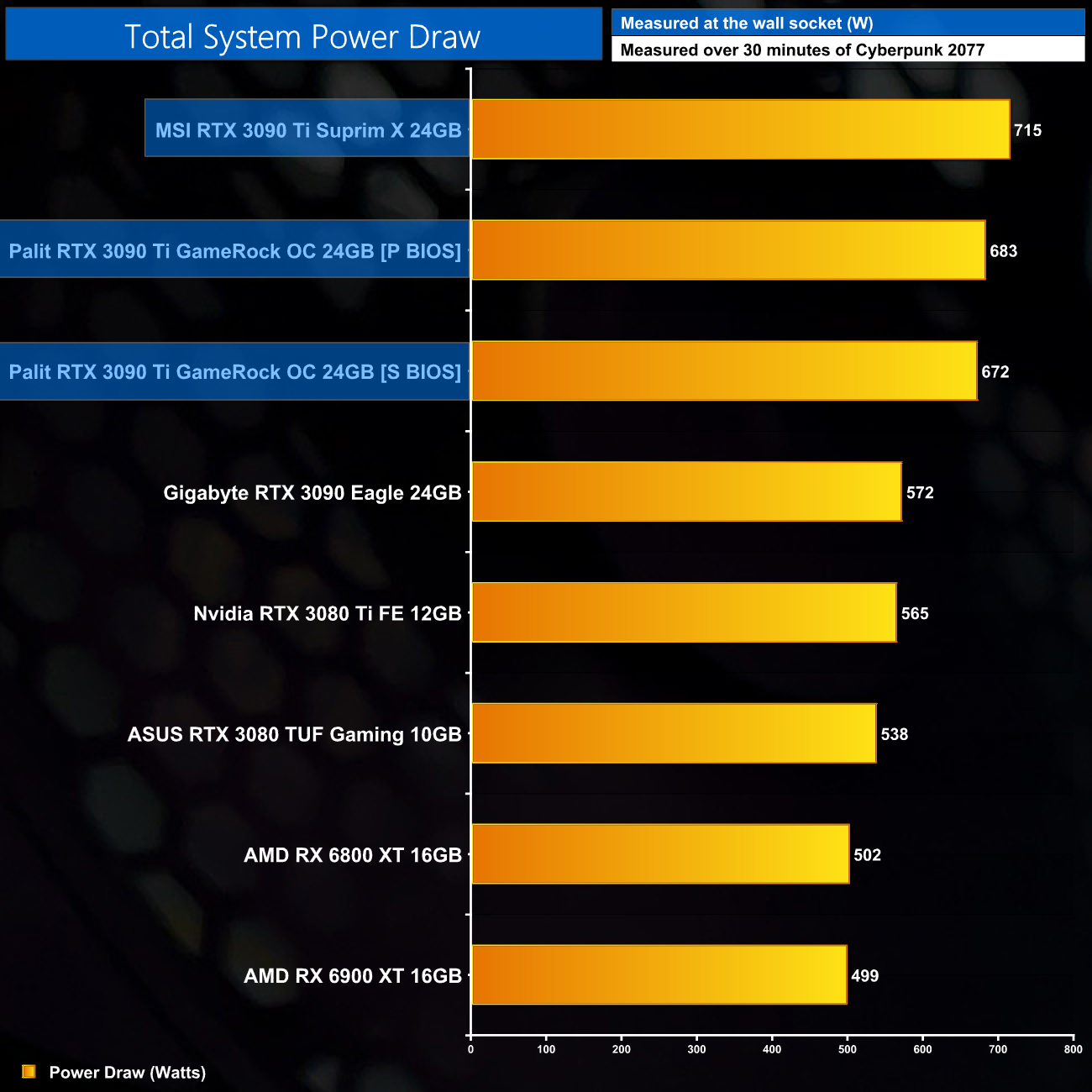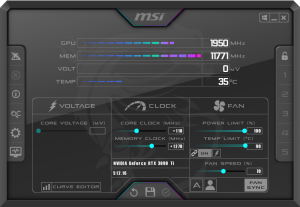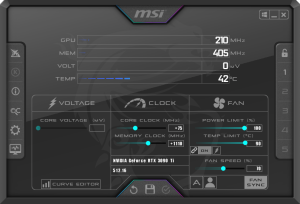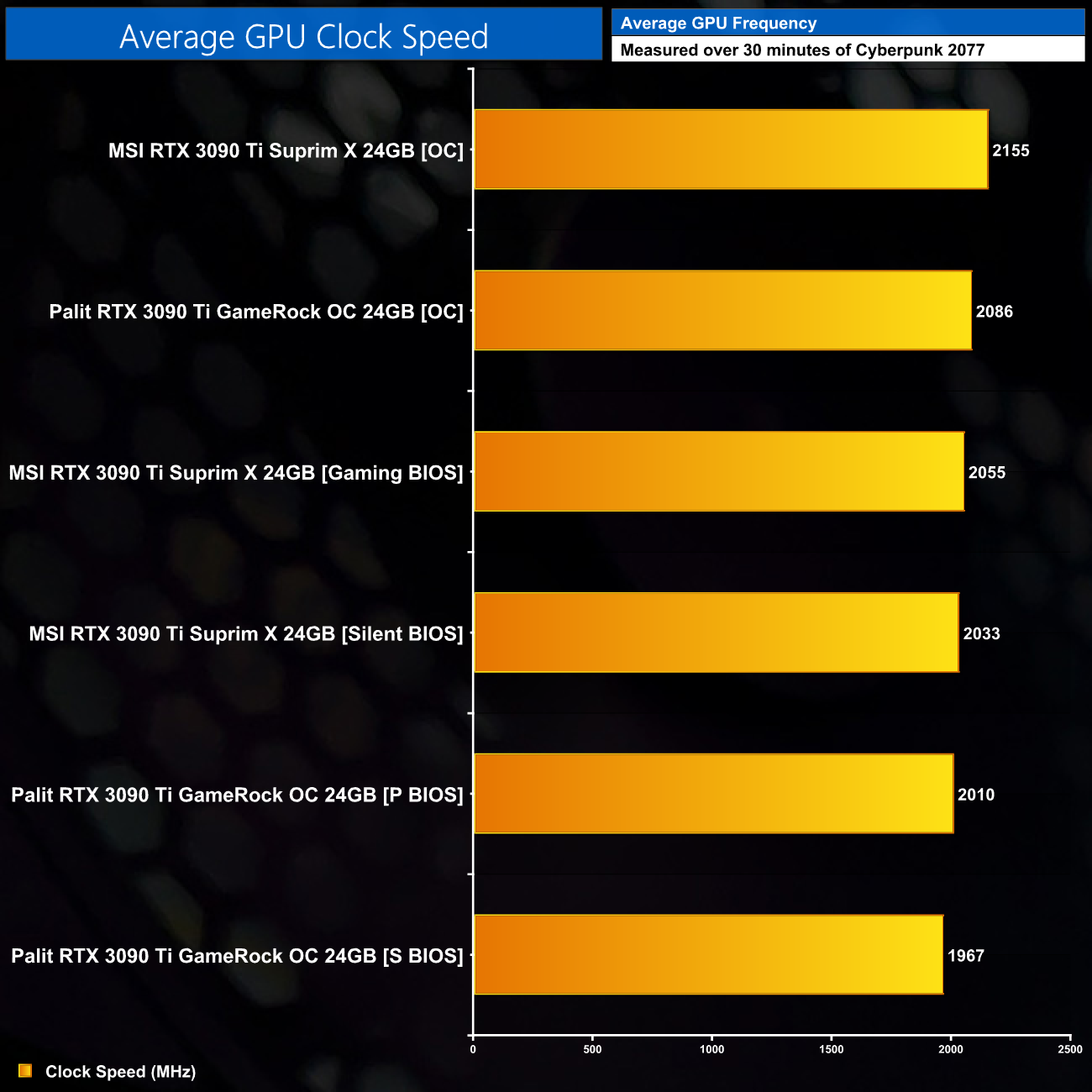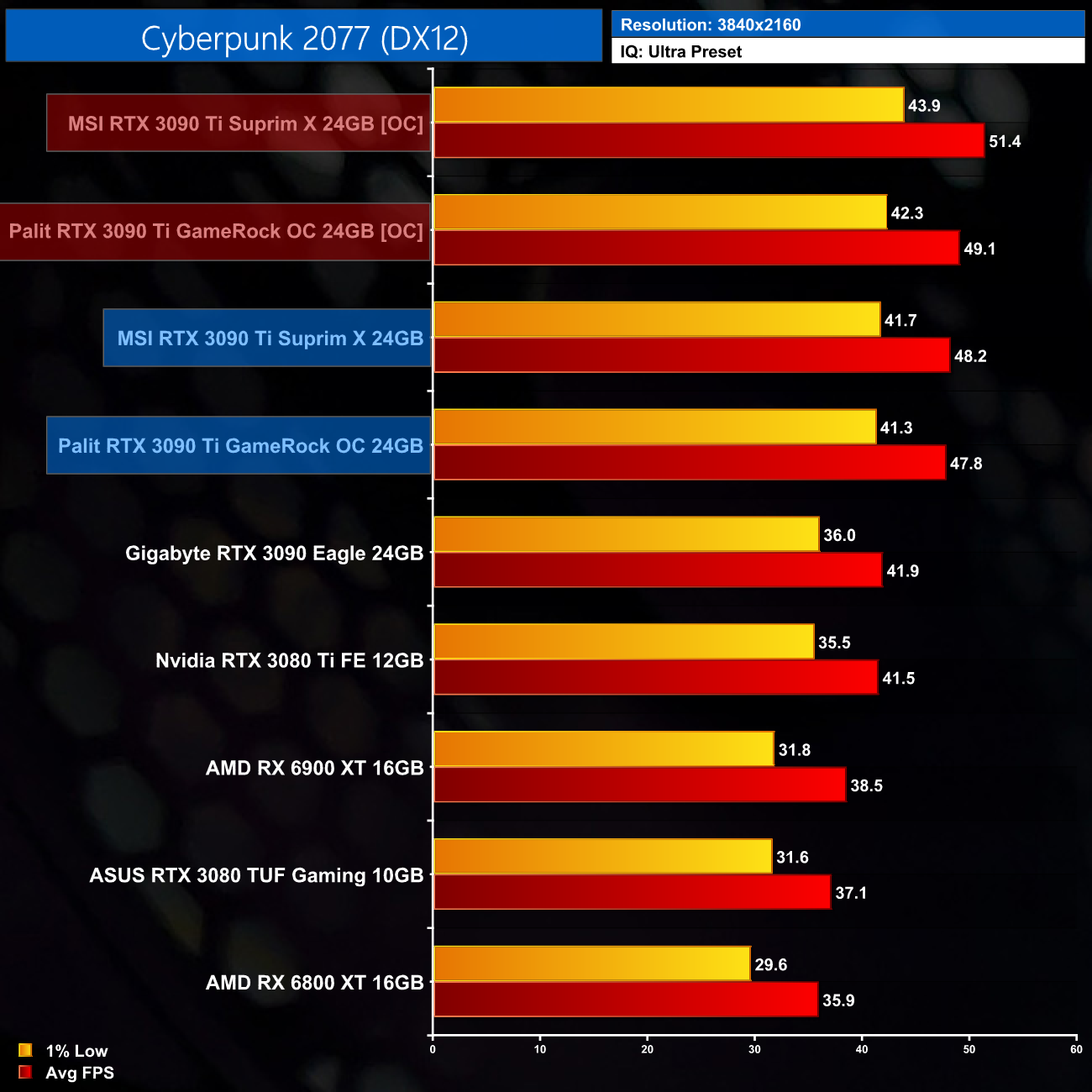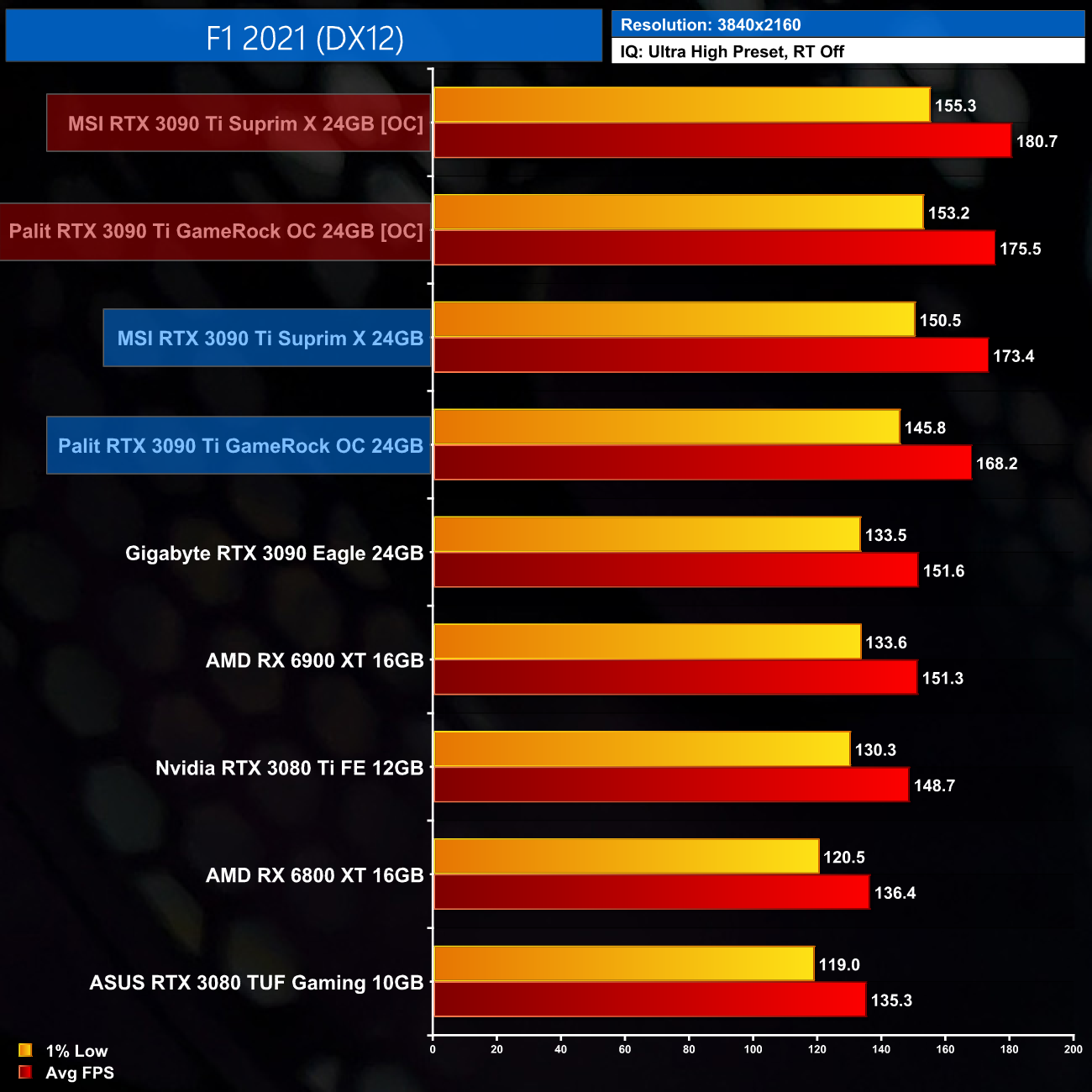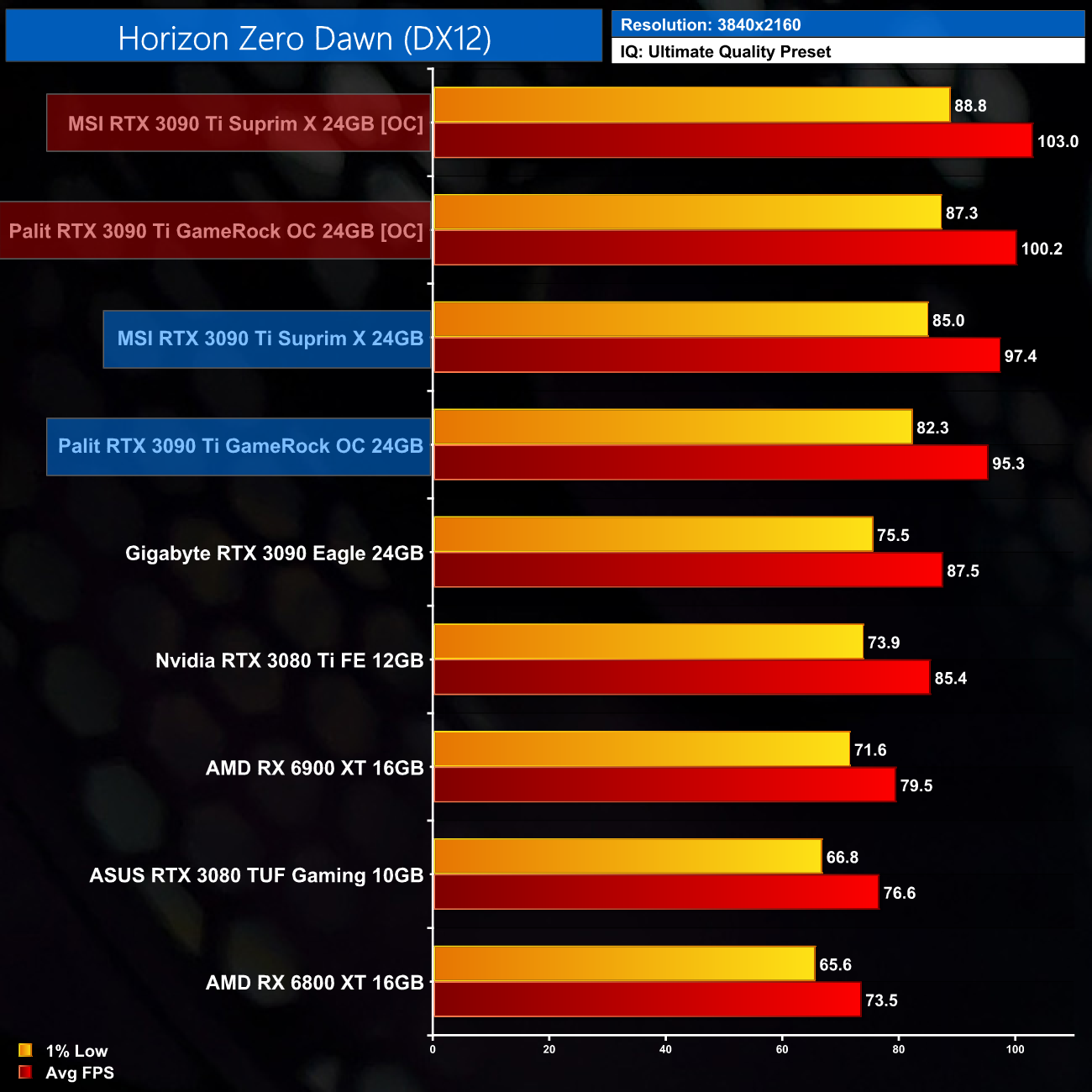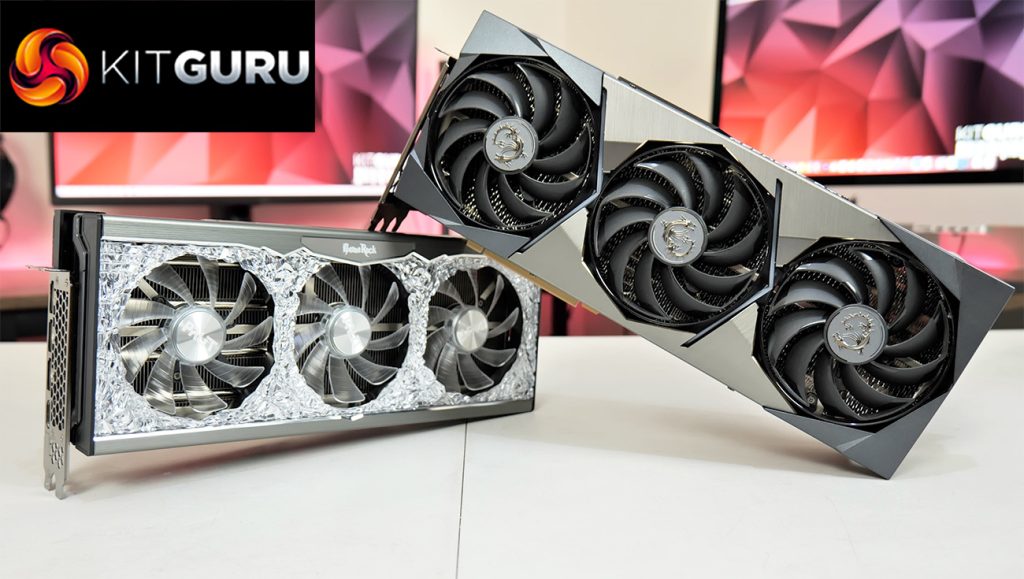While the RTX 3090 Ti was officially announced back at CES 2022, we've had to wait until now to hear more about Nvidia's new flagship GPU. That's right, the RTX 3090 Ti launches today, and we are checking out both the MSI Suprim X and Palit GameRock OC models. But how much faster is this new card compared to the RTX 3090? And will it really guzzle 450W of power? We discuss all that and more in this review.
We've mentioned that this is a ‘new' GPU, which I suppose is technically true, but the reality is the Nvidia RTX 3090 Ti is using the same GA102 silicon we have been familiar with ever since the launch of the RTX 3080 10GB and RTX 3090 24GB back in September 2020. Yes, it has been tweaked with a few extra cores, higher clocks and faster memory, but it's very much an Ampere GPU, fabbed on Samsung's 8nm process, so don't expect wild performance gains over the vanilla RTX 3090.
Due to the increase in power draw however, the two cards we are looking at today are easily the largest I have ever seen, with both the MSI RTX 3090 Ti Suprim X and the Palit RTX 3090 Ti GameRock OC dwarfing even the RTX 3080 Ti. We take a closer look at each of these days in the subsequent pages of this review.
| RTX 3090 Ti | RTX 3090 | RTX 3080 Ti | RTX 3080 | RTX 3070 | |
| SMs | 84 | 82 | 80 | 68 | 46 |
| CUDA Cores | 10752 | 10496 | 10240 | 8704 | 5888 |
| Tensor Cores | 336 | 328 | 320 | 272 | 184 |
| RT Cores | 84 | 82 | 80 | 68 | 46 |
| Texture Units | 336 | 328 | 320 | 272 | 184 |
| ROPs | 112 | 112 | 112 | 96 | 96 |
| GPU Boost Clock | 1860 MHz | 1695 MHz | 1665 MHz | 1710 MHz | 1725 MHz |
| Memory Data Rate | 21 Gbps | 19.5 Gbps | 19 Gbps | 19 Gbps | 14 Gbps |
| Total Video Memory | 24GB GDDR6X | 24GB GDDR6X | 12GB GDDR6X | 10GB GDDR6X | 8GB GDDR6 |
| Memory Interface | 384-bit | 384-bit | 384-bit | 320-bit | 256-bit |
| Memory Bandwidth | 1008 GB/Sec | 936 GB/Sec | 912 GB/Sec | 760 GB/Sec | 448 GB/Sec |
| TGP | 450W | 350W | 350W | 320W | 220W |
Let's first recap the exact makeup of this GPU however. We've mentioned the RTX 3090 Ti uses GA102 silicon, but it's the first time we have seen a fully populated die. That means the RTX 3090 Ti incorporates 84 Streaming Multiprocessors (SMs), and thanks to Ampere’s SM structure with its two FP32 datapaths, each SM houses 128 CUDA cores, giving a total of 10752. This is an increase of 256 cores compared to the RTX 3090, an extra 2.4%.
Ampere also places one RT core, and four Tensor cores, in each SM, giving a total of 84 RT cores and 336 Tensor cores. This is accompanied by 336 texture units and 112 ROPs which are housed directly within each graphics processing cluster (GPC), with 16 ROPs per GPC, and 7 GPCs in total for RTX 3090 Ti.
Clock speed is another area where Nvidia has made improvements compared to the RTX 3090. The RTX 3090 Ti has a reference clock of 1860 MHz, a boost of 165 MHz against the RTX 3090, though both of the partner cards we test come factory overclocked. We test real-world clock speed behaviour later in this review.
For the memory, Nvidia is using the same 384-bit bus as found with the RTX 3090. The memory allocation itself remains with 24GB of GDDR6X, but the kicker is these modules themselves have been upgraded to new 21Gbps chips. This brings total memory bandwidth up to over 1TB/s, hitting 1008GB/s to be precise.
Lastly, for total graphics power, Nvidia rates the RTX 3090 Ti for 450W, an increase of 100W, or 28.6% compared to the vanilla RTX 3090. Both cards we are looking at today push this further still, with a 480W power limit for the Suprim X, and a 460W limit for the GameRock OC. Of course, we are on hand to utilise our best ever GPU power testing methodology, so read on for our most detailed power testing yet.
The MSI RTX 3090 Ti Suprim X ships in a large white point, with an image of the graphics card dominating the front. On the back, MSI highlights various key features of the card, its cooler and design.
Inside, we get a wealth of included accessories – a mouse pad, as well as tonnes of various documents and leaflets.
There's also a support bracket (which you will absolutely need considering this card weighs over 2.1KG), as well as a power adaptor – this card uses the new PCIe Gen5 power connector, but the adaptor lets you uses three 8-pin connectors instead.
As for the card itself, the core design is the same as what we have already seen from various other Suprim X reviews. This means we have a two-tone metal and plastic shroud, with three 100mm Torx 4.0 fans visible as well. It's a tasteful design in my opinion – the metal sections on the shroud almost look gold depending how the light hits them, it's certainly a card that would take pride of place in my own system.
It is absolutely massive, however – measuring in at 337 x 140 x 71mm, so it's a proper 3.5 slot card. It also weighs over 2.1KG, or 2144g on my scales. BFGPU indeed.
Elsewhere, we can note the Suprim X and GeForce RTX logos on the top side of the card, while MSI is using a two-tone full-length metal backplate, with a few cutouts towards the end to allow airflow to pass directly through the heatsink.
It's important to note a dual-BIOS switch too, with a choice of Silent or Gaming BIOS, though the only difference between the two is fan speed.
As mentioned, MSI is using the new PCIe Gen5 power connector, though an adaptor is included if your PSU doesn't yet support this connector. We can also note three DisplayPort 1.4 and one HDMI 2.1 video outputs.
As for the Palit RTX 3090 Ti GameRock OC, this also ships in a white box, with the GameRock logo emblazoned on the front – I always get a blast of nostalgia for Guitar Hero whenever I see this font…
On the back, Palit highlights different features of the cooler and design of the card.
As for the accessories, Palit includes a quick start guide and, oddly, a calendar, along with a support bracket (that just needs assembling) and an RGB extension cable. We also find another power adaptor for the PCIe Gen5 plug.
Looking at the card itself, we can see the same overall design as the RTX 3090 GameRock OC that we reviewed last year. That means we have easily the most ‘blinged-out' shroud design I have ever seen, with almost the entirety of the shroud acting as a big RGB LED diffuser – be sure to watch our video review to see this in action.
We can also note three 90mm fans used to cool the heatsink, while the parts of the shroud which aren't emitting RGB lighting are made of a grey metal.
Palit has also upscaled its design however to deal with the extra heat of the GPU – the GameRock OC measures 314 x 137 x 65 mm, and weighs in just under 1.9KG on my scales. It's not quite as large as the Suprim X, but it's not exactly Mini-ITX friendly…
The GeForce RTX and GameRock logos are visible on the top side of the card, and also on the full-length metal backplate, which features several large cutouts at the far end. Palit also includes a dual-BIOS switch right next to the I/O bracket, with a choice between the P (performance) and S (silent) BIOS. The former has a 460W power target, while the latter has a 450W target.
We get another look at the new PCIe Gen5 power connector that Palit uses here, though do remember an adaptor is included. Display outputs are also standard, with 3x DisplayPort 1.4 and 1x HDMI 2.1.
Driver Notes
- All AMD GPUs were benchmarked with the public Adrenalin 22.3.1 driver.
- All Nvidia GPUs (except RTX 3090 Ti) were benchmarked with the 511.79 driver.
- RTX 3090 Ti was benchmarked with the 512.16 driver supplied to press.
Test System:
We test using the a custom built system powered by MSI, based on Intel’s Alder Lake platform. You can read more about this system HERE and check out MSI on the CCL webstore HERE.
| CPU |
Intel Core i9-12900K
|
| Motherboard |
MSI MEG Z690 Unify
|
| Memory |
32GB (2x16GB) ADATA XPG Lancer DDR5 6000MHz
CL 40-40-40
|
| Graphics Card |
Varies
|
| SSD |
2TB MSI Spatium M480
|
| Chassis | MSI MPG Velox 100P Airflow |
| CPU Cooler |
MSI MEG CoreLiquid S360
|
| Power Supply |
Corsair 1200W HX Series Modular 80 Plus Platinum
|
| Operating System |
Windows 11 Pro 21H2
|
| Monitor |
MSI Optix MPG321UR-QD
|
| Resizable BAR |
Enabled for all supported GPUs
|
Comparison Graphics Cards List
- AMD RX 6800 XT 16GB
- AMD RX 6900 XT 16GB
- ASUS RTX 3080 TUF Gaming 10GB
- Nvidia RTX 3080 Ti FE 12GB
- Gigabyte RTX 3090 Eagle 24GB
Software and Games List
- 3DMark Fire Strike & Fire Strike Ultra (DX11 Synthetic)
- 3DMark Time Spy (DX12 Synthetic)
- Assassin's Creed Valhalla (DX12)
- Cyberpunk 2077 (DX12)
- Dying Light 2 (DX12)
- F1 2021 (DX12)
- Far Cry 6 (DX12)
- Forza Horizon 5 (DX12)
- God of War (DX11)
- Horizon Zero Dawn (DX12)
- Marvel's Guardians of the Galaxy (DX12)
- Metro Exodus Enhanced Edition (DXR)
- Red Dead Redemption 2 (DX12)
- Resident Evil Village (DX12)
- Total War: Warhammer III (DX11)
We run each benchmark/game three times, and present mean averages in our graphs. We use FrameView to measure average frame rates as well as 1% low values across our three runs.
Fire Strike is a showcase DirectX 11 benchmark for modern gaming PCs. Its ambitious real-time graphics are rendered with detail and complexity far beyond other DirectX 11 benchmarks and games. Fire Strike includes two graphics tests, a physics test and a combined test that stresses the CPU and GPU. (UL).
3DMark Time Spy is a DirectX 12 benchmark test for Windows 10 gaming PCs. Time Spy is one of the first DirectX 12 apps to be built the right way from the ground up to fully realize the performance gains that the new API offers. With its pure DirectX 12 engine, which supports new API features like asynchronous compute, explicit multi-adapter, and multi-threading, Time Spy is the ideal test for benchmarking the latest graphics cards. (UL).
Starting with a look at the 3DMark benchmarks, we can see decent results here from the RTX 3090 Ti Suprim X. It's not quite as fast as the RX 6900 XT in Fire Strike, but takes top position in both Time Spy and Fire Strike Ultra, outperforming the RTX 3090 by 14% in the latter of those benchmarks.
Real-time ray tracing is incredibly demanding. The latest graphics cards have dedicated hardware that’s optimized for ray-tracing. The 3DMark DirectX Raytracing feature test measures the performance of this dedicated hardware. Instead of using traditional rendering techniques, the whole scene is ray-traced and drawn in one pass. The result of the test depends entirely on ray-tracing performance. (UL).
3DMark's ray tracing feature test shows another clear win for the RTX 3090 Ti – it embarrasses the RX 6900 XT here, and also offers a 10% performance boost over the RTX 3090 non-Ti.
Assassin's Creed Valhalla is an action role-playing video game developed by Ubisoft Montreal and published by Ubisoft. It is the twelfth major installment and the twenty-second release in the Assassin's Creed series, and a successor to the 2018's Assassin's Creed Odyssey. The game was released on November 10, 2020, for Microsoft Windows, PlayStation 4, Xbox One, Xbox Series X and Series S, and Stadia, while the PlayStation 5 version was released on November 12. (Wikipedia).
Engine: AnvilNext 2.0. We test using the Ultra High preset, DX12 API.
Kicking off the game benchmarks with Assassin's Creed: Valhalla, at 1440p we can see the RTX 3090 Ti Suprim X delivers 105 FPS on average. As AMD GPUs do so well in this game, that only puts it level with the RX 6800 XT and 16% slower than the RX 6900 XT, while it's only 6% faster than the vanilla RTX 3090.
At 4K, the 3090 Ti does climb to the top of the chart, but it's not much faster than the 6900 XT, delivering just 4% better performance. That makes in 9% faster than the RTX 3090, and still only 13% faster than the RX 6800 XT.
Cyberpunk 2077 is a 2020 action role-playing video game developed and published by CD Projekt. The story takes place in Night City, an open world set in the Cyberpunk universe. Players assume the first-person perspective of a customisable mercenary known as V, who can acquire skills in hacking and machinery with options for melee and ranged combat. Cyberpunk 2077 was released for Microsoft Windows, PlayStation 4, Stadia, and Xbox One on 10 December 2020. (Wikipedia).
Engine: REDengine 4. We test using the Ultra preset, DX12 API.
Moving onto Cyberpunk 2077, we see more benefit from the RTX 3090 Ti in this title. Even at 1440p there is more of the performance difference that we were hoping for, as it's coming in 12% faster than the RTX 3090, and 11% faster than the RX 6900 XT. The fact that it still only hits 91FPS shows you just how demanding this game is at Ultra settings.
At 4K, the 3090 Ti can stretch its legs further, delivering an extra 15% performance over the RTX 3090, with a much more impressive 25% lead over the RX 6900 XT as well, even if the frame-rate is sitting below 50FPS.
Dying Light 2: Stay Human is a 2022 action role-playing game developed and published by Techland. The sequel to Dying Light (2015), the game was released on February 4, 2022 for Microsoft Windows, PlayStation 4, PlayStation 5, Xbox One, and Xbox Series X/S. (Wikipedia).
Engine: C-Engine. We test using the High preset, DX12 API.
Dying Light 2 doesn't show us as impressive results as we saw in Cyberpunk, but the RTX 3090 Ti is still sitting at the top of the chart, delivering 126FPS at 1440p. That puts it 9% ahead of the RTX 3090, and 15% clear of the RX 6900 XT, though do remember this is an Nvidia sponsored title.
As for 4K performance, here the 3090 Ti delivers an extra 7FPS compared to the RTX 3090, which may not sound like much, but it is a 10% improvement. Once more we're also looking at a 25% lead for the 3090 Ti over the 6900 XT as well.
F1 2021 is the official video game of the 2021 Formula One and Formula 2 Championships developed by Codemasters and published by EA Sports. The game was released for Microsoft Windows, PlayStation 4, PlayStation 5, Xbox One and Xbox Series X/S on 16 July 2021. The deluxe edition was launched three days earlier on 13 July 2021. (Wikipedia).
Engine: EGO. We test using the Ultra High preset, ray tracing disabled, DX12 API.
F1 2021 does scale reasonably well with the 3090 Ti, both in terms of the fact that it can push almost 270FPS and 175FPS at 1440p and 4K, respectively, but we're also seeing up to a 14% increase in performance over the vanilla RTX 3090 Ti. AMD is very competitive in this game however, with the 3090 Ti just 7% faster than the 6900 XT at 1440p.
Far Cry 6 is a 2021 action-adventure first-person shooter game developed by Ubisoft Toronto and published by Ubisoft. It is the sixth main installment in the Far Cry series and the successor to 2018's Far Cry 5. The game was released on October 7, 2021, for Microsoft Windows, PlayStation 4, PlayStation 5, Xbox One, Xbox Series X/S, Stadia, and Amazon Luna. (Wikipedia).
Engine: Dunia Engine. We test using the Ultra preset, HD Textures enabled, DX12 API.
Far Cry 6 is another title where AMD does well, and do note this is actually an AMD sponsored game! Even at 4K, the RTX 3090 Ti is just 7% faster than the RX 6900 XT, and that margin shrinks to just 1% – or basically nothing – at 1440p. Relative to the RTX 3090, we're seeing performance improvements of 7% at 1440p, and then 10% at 4K.
Forza Horizon 5 is a 2021 racing video game developed by Playground Games and published by Xbox Game Studios. The twelfth main instalment of the Forza series, the game is set in a fictionalised representation of Mexico. It was released on 9 November 2021 for Microsoft Windows, Xbox One, and Xbox Series X/S. (Wikipedia).
Engine: ForzaTech. We test using the Extreme preset, DX12 API.
Next up is Forza Horizon 5 and the results here are particularly interesting. For starters, Nvidia GPUs get an absolute kicking by their AMD counterparts in this title, with the RTX 3090 Ti 9% slower than even the RX 6800 XT at 1440p, making it 16% slower than the RX 6900 XT.
I'm not sure if this game just isn't as well optimised for the Ampere architecture as it should be, but the 3090 Ti isn't even scaling well against the RTX 3090 – even at 4K, it's just 4% faster on average, still making it 7% slower than the RX 6900 XT, making this the only game I tested where the 3090 Ti can't beat the 6900 XT at the 4K resolution.
God of War is an action-adventure game developed by Santa Monica Studio and published by Sony Interactive Entertainment (SIE). It was released worldwide on April 20, 2018, for the PlayStation 4 with a Microsoft Windows version released on January 14, 2022. (Wikipedia).
Engine: Sony Santa Monica Proprietary. We test using the Ultra preset, DX11 API.
God of War is more favourable to Nvidia cards, and we do also see better scaling for the 3090 Ti here – at 1440p it hits 131FPS on average, making it 13% faster than the RTX 3090, and 21% faster than the RX 6900 XT.
Up at 4K, it's now 30% faster than the 6900 XT, and still a decent 14% ahead of the vanilla RTX 3090, with both AMD GPUs sitting at the bottom of the chart.
Horizon Zero Dawn is an action role-playing game developed by Guerrilla Games and published by Sony Interactive Entertainment. The plot follows Aloy, a hunter in a world overrun by machines, who sets out to uncover her past. It was released for the PlayStation 4 in 2017 and Microsoft Windows in 2020. (Wikipedia).
Engine: Decima. We test using the Ultimate Quality preset, DX12 API.
Horizon Zero Dawn is another title where the RX 6900 XT does well to keep up with the RTX 3090 Ti, as Nvidia's new flagship is only 5% faster than its AMD's rival at 1440p. At 4K however we see the best from the 3090 Ti, it's nearly able to hit 100FPS, making it 11% faster than the RTX 3090 and 23% faster than the
Marvel's Guardians of the Galaxy is a 2021 action-adventure game developed by Eidos-Montréal and published by Square Enix. Based on the Marvel Comics superhero team Guardians of the Galaxy, the game was released for Microsoft Windows, Nintendo Switch, PlayStation 4, PlayStation 5, Xbox One, and Xbox Series X/S on October 26, 2021. (Wikipedia).
Engine: Dawn Engine. We test using the Ultra preset, DX12 API.
Marvel's Guardians of the Galaxy has a fixed 144FPS cap, and the RTX 3090 Ti is falling foul of that at both 1080p and 1440p. At 4K however, it is no longer constrained and can deliver a 14% boost over the RTX 3090, while it's 32% faster than the RX 6900 XT, which also suffers from noticeably worse 1% lows.
Red Dead Redemption 2 is a 2018 action-adventure game developed and published by Rockstar Games. The game is the third entry in the Red Dead series and is a prequel to the 2010 game Red Dead Redemption. Red Dead Redemption 2 was released for the PlayStation 4 and Xbox One in October 2018, and for Microsoft Windows and Stadia in November 2019. (Wikipedia).
Engine: Rockstar Advance Game Engine (RAGE). We test by manually selecting Ultra settings (or High where Ultra is not available), TAA, DX12 API.
Moving onto Red Dead Redemption 2, the results here are fairly typical of what we've seen so far. The RTX 3090 Ti is 13% faster than its non-Ti sibling, though that lead shrinks to 9% when compared to AMD's RX 6900 XT. At 4K, the 3090 Ti is still 14% faster than the RTX 3090, but now 20% faster than the 6900 XT, showcasing Nvidia's advantage at the higher resolution.
Resident Evil Village is a survival horror game developed and published by Capcom. The sequel to Resident Evil 7: Biohazard (2017), players control Ethan Winters, who is searching for his kidnapped daughter; after a fateful encounter with Chris Redfield, he finds himself in a village filled with mutant creatures. The game was announced at the PlayStation 5 reveal event in June 2020 and was released on May 7, 2021, for Windows, PlayStation 4, PlayStation 5, Xbox One, Xbox Series X/S and Stadia. (Wikipedia).
Engine: RE Engine. We test using the Max preset, with V-Sync disabled, DX12 API.
Things are neck-and-neck between the RTX 3090 Ti and RX 6900 XT in Resident Evil Village, with just 4FPS separating the two at 1440p – considering that's a difference of 224FPS and 228FPS, I'd say you're unlikely to notice! At 4K, the 3090 Ti does push ahead with a 10% margin, though that's still one of the better results for Team Red.
Total War: Warhammer III is a turn-based strategy and real-time tactics video game developed by Creative Assembly and published by Sega. It is part of the Total War series, and the third to be set in Games Workshop's Warhammer Fantasy fictional universe (following 2016's Total War: Warhammer and 2017's Total War: Warhammer II). The game was announced on February 3, 2021 and was released on February 17, 2022.(Wikipedia).
Engine: TW Engine 3 (Warscape). We test using the Ultra preset, with unlimited video memory enabled, DX11 API.
Lastly, we finish with Total War: Warhammer III. AMD GPUs definitely struggle in this title, and at 1440p we can see the RTX 3090 Ti is 33% faster than the RX 6900 XT, though compared to the RTX 3090 non-Ti, we're looking at a difference of 11%.
Up at 4K, the 3090 Ti is still just 13% faster than the RTX 3090, but it absolutely obliterates the 6900 XT, delivering almost 50% more performance. We do have to say however, this is probably more about the 6900 XT under-performing, than it is about the 3090 Ti being super fast.
Here we present frame rate figures for each graphics card, averaged across all 12 games on test today. These figures can disguise significant variations in performance from game to game, but provide a useful overview of the sort of performance you can expect at each resolution tested.
Overall, the RTX 3090 Ti is the fastest GPU we have ever tested at every resolution. That said, we know the RX 6900 XT does best, relatively speaking, at the lower resolutions, and at 1440p the RTX 3090 Ti is only 6% faster on average compared to the AMD GPU, so it's not a massive increase by any means. Compared to the RTX 3090 at the same resolution, we are seeing a 10% average improvement.
The RTX 3090 Ti really does best at 4K however, where we see the 6900 XT falling off a bit, resulting in an extra 16% performance from Nvidia's new flagship. Compared to the RTX 3090, the new Ti model is 12% faster on average. Do note though that our MSI 3090 Ti is a factory overclocked model, while our 3090 runs at stock clocks, so you can probably deduct a couple of percentage points when taking that into account.
Here we test Cyberpunk 2077, with RT Lighting set to Ultra.
Ray tracing performance scales more-or-less in line with what we have already observed – at 1440p, the RTX 3090 Ti is 14% faster than the RTX 3090, though it's almost twice as AMD's nearest challenger, the RX 6900 XT, which really struggles with the bevy of ray traced effects in Cyberpunk.
We do see an even bigger 18% boost to performance versus the RTX 3090 when testing at 4K, but the 3090 Ti is only hitting 22.8FPS at that resolution, so it's not a meaningful difference.
Here we test Metro Exodus Enhanced Edition, with the in-game ray tracing effects set to Ultra.
Metro Exodus Enhanced Edition is arguably the best showcase for ray tracing in games, with excellent performance despite a vast amount of ray tracing on show. At 4K, the RTX 3090 Ti averages over 70FPs, delivering s 17% uplift compared to the RTX 3090. It can also deliver over twice the performance of the RX 6900 XT.
Here we test Resident Evil Village, this time testing with the in-game ray tracing effects set to High.
As for Resident Evil Village, the ray tracing effects are less impressive here so performance doesn't scale as well for the 3090 Ti. It's still 14% faster than the RTX 3090 at 4K, though its lead of 31% over the RX 6900 XT is much smaller than the other two games we tested.
While our primary focus so far has been on the gaming performance of the MSI Suprim X, here we include a select sample 4K gaming benchmarks, testing both the Suprim X and GameRock OC.
The reason we opted to do most of our gaming benchmarks using the Suprim X becomes clear when looking at these charts – there is only a small difference in clock speed when using either card, resulting in just 1-2% performance variations. In other words, you don't lose out on much, if anything, by opting for one card over the other, certainly nothing that would actually be noticeable in-game.
Here we present the average clock speed for each graphics card while running Cyberpunk 2077 for 30 minutes. We use GPU-Z to record the GPU core frequency during gameplay. We calculate the average core frequency during the 30 minute run to present here.
The reason we see such similar performance between both RTX 3090 Tis that we have tested is due to the operating clock speed. MSI's Suprim X is the fastest, but only by around 45MHz in the real world, which is enough to affect gaming performance by 1-2%, but it's really not something you'd notice when actually gaming.
For our temperature testing, we measure the peak GPU core temperature under load. A reading under load comes from running Cyberpunk 2077 for 30 minutes.
As for thermals, we have tested both BIOS modes on each card here, and to be honest there's not much difference between even the best and worst results. The Suprim X does run coolest out of the box when using the Gaming BIOS, with a GPU hotspot of 81C, but at worst using the Silent BIOS, the hotspot only hit 87C. Palit's results are right in the middle, with just a 1C difference between its Performance and Silent BIOS.
For our temperature testing, we measure the peak memory temperature under load. A reading under load comes from running Cyberpunk 2077 for 30 minutes.
GDDR6X memory temperatures are also kept well in check. I wasn't sure if the 21Gbps modules would run noticeably hotter, but at least with these two cards, memory thermals are absolutely fine. The RTX 3080 Ti Founders Edition GDDR6X runs well into the 90C range and that's slower memory to begin with, so we can't complain about these two 3090 Tis, though performance may vary depending on the specific model you are looking at.
We take our noise measurements with the sound meter positioned 1 foot from the graphics card. I measured the noise floor to be 32 dBA, thus anything above this level can be attributed to the graphics cards. The power supply is passive for the entire power output range we tested all graphics cards in, while all CPU and system fans were disabled. A reading under load comes from running Cyberpunk 2077 for 30 minutes.
As for noise levels, one consequence of the 3090 Ti being such a high power GPU is that all of the cards we tested were audible under load. Some were quieter than other, with MSI's Silent BIOS delivering the lowest noise levels, but at 38dBa it was still audible to my ear. It's still not loud of course, but you may just have to adjust your expectations – to cool over 450W of power is going to require higher fan speeds than if this were just a 350W GPU, for instance.
Following on from our stock thermal and acoustic testing, here we re-test the operating temperature of the GPU, but with noise levels normalised to 40dBa. This allows us to measure the efficiency of the overall cooling solution as varying noise levels as a result of more aggressive fan curves are no longer a factor.
Removing noise levels from the equation, we also look at noise-normalised temperatures, with fan speeds set to output 40dBa. The MSI Suprim X ran coolest here, but only by 2C when looking at the GPU hotspot temperature. We also tested both BIOS for the Palit GameRock, as the P BIOS does have a 10W higher power target, but even that didn't make a difference to thermals once we had set the same fan speed for both BIOS.
As for noise-normalised memory temperatures, once again both Palit BIOS modes performed the same, with the GDDR6X running 4C hotter than the Suprim X.
Here we present power draw figures for the graphics card-only, on a per-game basis for all twelve games we tested at 1080p. This is measured using Nvidia's Power Capture Analysis Tool, also known as PCAT. You can read more about our updated power draw testing methodology HERE.
Per-Game Results at 1080p:
Click to enlarge.
12-Game Average at 1080p:
Despite the Suprim X's 480W power target, average power draw is lower at 1080p, where the GPU isn't always fully utilised – we saw an average figure of 394W, a 40W increase over the RTX 3090.
Here we present power draw figures for the graphics card-only, on a per-game basis for all twelve games we tested at 1440p. This is measured using Nvidia's Power Capture Analysis Tool, also known as PCAT. You can read more about our updated power draw testing methodology HERE.
Per-Game Results at 1440p:
Click to enlarge.
12-Game Average at 1440p:
Average power draw is noticeably higher at 1440p, but still a bit below the power target – we can see an average reading of 431W, though that is now 75W higher than the RTX 3090, and certainly nothing to be scoffed at.
Here we present power draw figures for the graphics card-only, on a per-game basis for all twelve games we tested at 2160p (4K). This is measured using Nvidia's Power Capture Analysis Tool, also known as PCAT. You can read more about our updated power draw testing methodology HERE.
Per-Game Results at 2160p:
Click to enlarge.
12-Game Average at 2160p:
As for 4K power draw, we get much closer to the 480W power limit here, though a few games including Forza Horizon 5 and Assassin's Creed Valhalla still show sub-400W power draw, bringing down the average. Even so, this is a lot of juice and marks a 30% increase to power draw versus the RTX 3090.
Using the graphics card-only power draw figures presented earlier in the review, here we present performance per Watt on a per-game basis for all twelve games we tested at 1080p.
Per-Game Results at 1080p:
Click to enlarge.
12-Game Average at 1080p:
Considering the large increase to power, despite performance gains of 12% on average over the RTX 3090, it's no surprise to see the RTX 3090 Ti rock bottom of our performance per Watt chart, even at 1080p where its power draw was lowest.
Using the graphics card-only power draw figures presented earlier in the review, here we present performance per Watt on a per-game basis for all twelve games we tested at 1440p.
Per-Game Results at 1440p:
Click to enlarge.
12-Game Average at 1440p:
The RTX 3090 Ti still delivers the lowest performance per Watt of any GPU tested, where it is 8% behind the RTX 3080. Compared to the RX 6900 XT, the 3090 Ti delivers 28% less performance per Watt.
Using the graphics card-only power draw figures presented earlier in the review, here we present performance per Watt on a per-game basis for all twelve games we tested at 2160p (4K).
Per-Game Results at 2160p:
Click to enlarge.
12-Game Average at 2160p
At 4K, the RTX 3090 Ti is once again rooted to the bottom of our chart for performance per Watt. It's 9% behind the RTX 3080 and 26% behind the RX 6900 XT.
We measure system-wide power draw from the wall while running Cyberpunk 2077 for 30 minutes.
If you're wondering about total system power draw, with our i9-12900K test PC, power draw exceeded 710W when using the MSI Suprim X. The GameRock OC does have a slightly lower power target, but even then 680W is a lot of power for a single-card system.
For our manual overclocking tests, we used MSI Afterburner. Our best results are as below.
MSI Suprim X:
Palit GameRock OC:
Interestingly, neither card has an adjustable power limit, so we weren’t able to push the power even higher in pursuit of higher clocks. Still, for the Suprim X we were able to add 110MHz to the GPU and 1270MHz to the memory. The GameRock OC didn’t overclock quite as well, with an extra 75MHz to the GPU and 1110MHz to the memory.
This saw the Suprim X run 100MHz faster on average, hitting 2155MHz, while the GameRock OC averaged 2086MHz.
These overclocks saw performance improve by a handful of percent, between 4-7% in the games re-tested here. This is fine but nothing super exciting, as it seems the 3090 Ti has already been delivered right on the edge of its performance limits.
Despite being first announced almost three months ago, things had gone strangely quiet on the RTX 3090 Ti since its unveiling at CES 2022, with rumours swirling around potential issues with the GDDR6X memory. Whatever the case may have been, the RTX 3090 Ti is now here and launches today, cementing its place as the fastest consumer graphics card on the market.
‘Well, how fast is it really,' I hear you ask. Over the twelve games I tested, the RTX 3090 Ti delivered a 12% performance uplift compared to the original RTX 3090, when gaming at 4K. At the same resolution, it comes in 16% faster on average than AMD's flagship RX 6900 XT.
As we have come to expect from Ampere however, it's not quite as strong at the lower resolutions, with a 10% average gain over the RTX 3090 at 1440p, while that shrinks to 6% versus the RX 6900 XT. It's also worth noting that we focused our testing on the MSI Suprim X model, which is a factory overclocked card, so the difference would likely be slightly smaller if we tested a reference-clocked card.
Still, those numbers do conclusively make the RTX 3090 Ti the fastest consumer graphics card that money can buy, and for those wondering we saw similar, if not slightly larger, performance uplifts during ray traced workloads, with Metro Exodus Enhanced Edition putting the RTX 3090 Ti 17% ahead of its non-Ti brethren at 4K. It should go without saying by now that also means the 3090 Ti is clearly faster than AMD's 6900 XT for ray tracing performance, as RDNA 2 just cannot match Ampere in this regard.
We'll take a moment to discuss the two aftermarket cards we have tested today – the MSI Suprim X and the Palit GameRock OC. Both are very competent cards, though they are also exceptionally large, and I'd expect this to be consistent across every third-party model. Nvidia pushing the power as high as they did requires some cooling to say the least, and noise levels are also slightly higher than what we have seen from previous models in the Suprim X and GameRock series.
On the topic of power draw, there's no other way around it, the RTX 3090 Ti is the single most power hungry GPU I have ever tested. We observed total system power draw exceeding 710W, while power draw for the graphics card averaged at 463W for the Suprim X, but went as high as 500W in Cyberpunk 2077 at 4K. It is quite staggering really to see a 30% increase in power when compared to the RTX 3090, which wasn't exactly frugal to begin with, particularly in the face of rising electricity prices.
Such monumental power draw has negative implications for overall efficiency too. At 4K, performance per Watt for this new GPU lags behind the competition, as it is 9% less efficient than the RTX 3080 but 26% less efficient than the RX 6900 XT. This is an area where Nvidia had the upper hand for years but times have now changed, and we have to wonder if power efficiency is even a consideration any more, or if the goal is simply to deliver as much performance as the silicon will allow. The idea of Nvidia releasing a 450W GPU would have been almost unimaginable only three years ago, but here we are.
And then we come to pricing. Nvidia set the UK MSRP at £1879, which on paper marks a 34% increase over the £1399 MSRP of the vanilla RTX 3090. The aftermarket cards we have reviewed today however, are priced higher still, with the Suprim X's MSRP set at £1979.99, and that increases to £2179 for the GameRock OC. Considering the RTX 3090 Suprim X is still listed at £2000, while the 3090 GameRock is also selling for £2099, we can only imagine that real-world street pricing will be even higher. In short, this is a graphics card for only the most cash rich of enthusiasts.
Viewed through an objective lens then, the RTX 3090 Ti has more than its fair share of downsides. The extra performance on offer versus the RTX 3090 just doesn't come close to matching either the increase to price or power draw, and while an extra 12% performance on average is certainly not nothing, it's not exactly going to set the world alight.
But I can't shake the feeling that none of those downsides really matter to this card's target audience. And that's because, despite all its shortcomings, the RTX 3090 Ti has met its primary goal of being the fastest consumer graphics card on the market, and for those who this card is aimed at, I think that is all that really matters.
To be clear, its value is very poor, it is excessively power hungry and its efficiency lags behind the RX 6900 XT. But if you just want the best of the best, and don't care about anything else, then the RTX 3090 Ti is the GPU to buy. Just don’t be surprised when that all changes with the launch of the RTX 40 series later this year.
You can view the RTX 3090 Ti range on Overclockers UK HERE.
Discuss on our Facebook page HERE.
MSI RTX 3090 Ti Suprim X
Pros
- Fastest GPU we have ever tested.
- Beautiful design.
- Dual-BIOS.
- Reasonably quiet under load.
Cons
- Extremely large.
- Power draw is sky high.
- Efficiency has gone out the window.
Palit RTX 3090 GameRock OC
Pros
- Basically as fast as the Suprim X.
- Bling-tastic design is a real point of difference.
- Dual-BIOS.
- Slightly less power hungry than the Suprim X.
Cons
- Very large.
- Power draw is still extremely high.
- Efficiency has gone out the window.
KitGuru says: For the vast majority of people, the RTX 3090 Ti isn't worth thinking about as anything more than a technical curiosity. For the richest few who only want the fastest card that money can buy, it will serve its purpose.
 KitGuru KitGuru.net – Tech News | Hardware News | Hardware Reviews | IOS | Mobile | Gaming | Graphics Cards
KitGuru KitGuru.net – Tech News | Hardware News | Hardware Reviews | IOS | Mobile | Gaming | Graphics Cards


